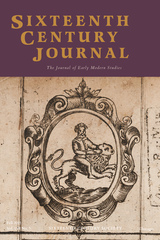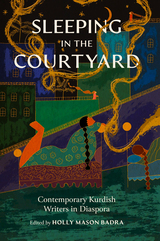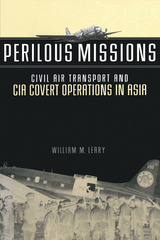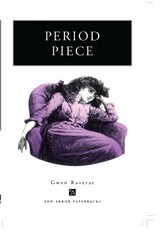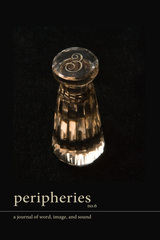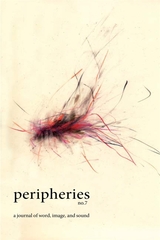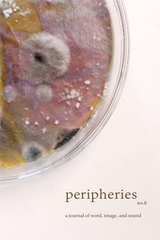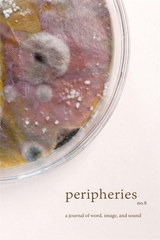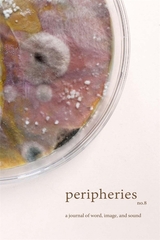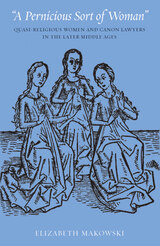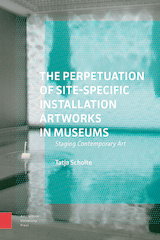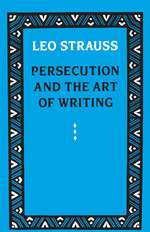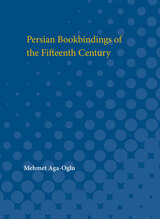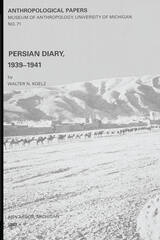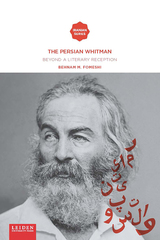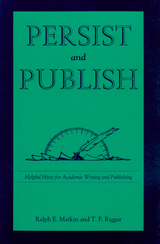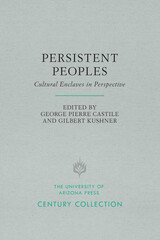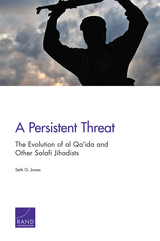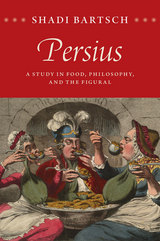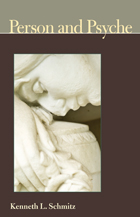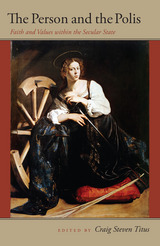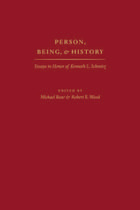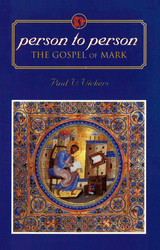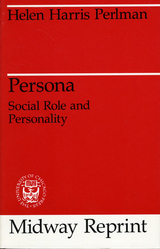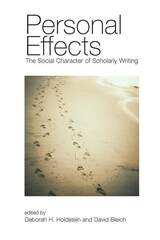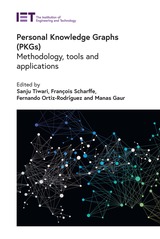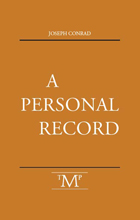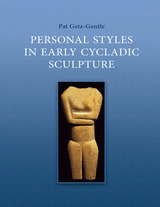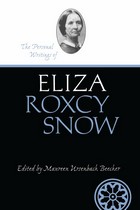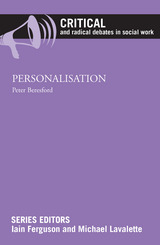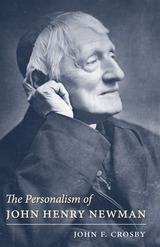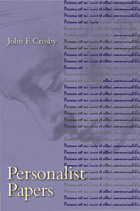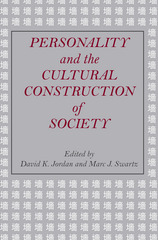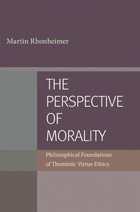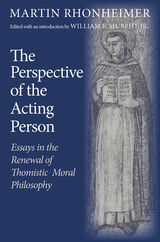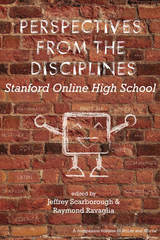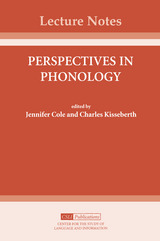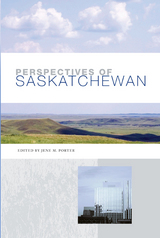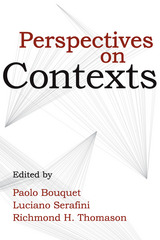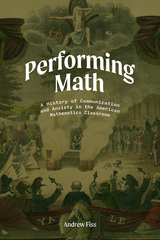 Performing Math: A History of Communication and Anxiety in the American Mathematics Classroom
Andrew Fiss
Rutgers University Press, 2021 Performing Math tells the history of expectations for math communication—and the conversations about math hatred and math anxiety that occurred in response. Focusing on nineteenth-century American colleges, this book analyzes foundational tools and techniques of math communication: the textbooks that supported reading aloud, the burnings that mimicked pedagogical speech, the blackboards that accompanied oral presentations, the plays that proclaimed performers’ identities as math students, and the written tests that redefined “student performance.” Math communication and math anxiety went hand in hand as new rules for oral communication at the blackboard inspired student revolt and as frameworks for testing student performance inspired performance anxiety. With unusual primary sources from over a dozen educational archives, Performing Math argues for a new, performance-oriented history of American math education, one that can explain contemporary math attitudes and provide a way forward to reframing the problem of math anxiety.
 Performing #MeToo: How Not to Look Away
Edited by Judith Rudakoff
Intellect Books, 2021 This collection of essays applies a multinational lens to performances that explore the #MeToo movement.
In October 2017, a wave of sexual assault allegations against Hollywood producer Harvey Weinstein prompted an outpouring of similar stories on Twitter and beyond, all bound by the same hashtag: #MeToo. The phrase, initially coined by activist Tarana Burke in 2006, reverberated across the internet and invigorated a movement. The essays in this volume engage with many of the performative interpretations of and responses to the #MeToo movement and invite reflection, discussion, and action.
Written by an international group of scholars and artists, the essays bring a global perspective to discussions on topics at the intersection of the #MeToo movement and the performing arts, including celebrity feminism, the practice of protest as a coping mechanism, misogynistic speech, the politics of performance, rehearsing and performing intimacy, and more. Contributors highlight works they have performed, witnessed, or studied, offering analysis and nuance while creating an archive of a powerful cultural moment.
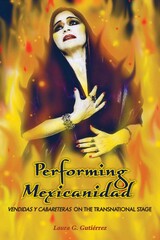 Performing Mexicanidad: Vendidas y Cabareteras on the Transnational Stage
By Laura G. Gutiérrez
University of Texas Press, 2010 Using interdisciplinary performance studies and cultural studies frameworks, Laura G. Gutiérrez examines the cultural representation of queer sexuality in the contemporary cultural production of Mexican female and Chicana performance and visual artists. In particular, she locates the analytical lenses of feminist theory and queer theory in a central position to interrogate Mexican female dissident sexualities in transnational public culture. This is the first book-length study to wed performance studies and queer theory in examining the performative/performance work of important contemporary Mexicana and Chicana cultural workers. It proposes that the creations of several important artists—Chicana visual artist Alma López; the Mexican political cabareteras Astrid Hadad, Jesusa Rodríguez, Liliana Felipe, and Regina Orozco; the Chicana performance artist Nao Bustamante; and the Mexican video artist Ximena Cuevas—unsettle heterosexual national culture. In doing so, they are not only challenging heterosexist and nationalist discourses head-on, but are also participating in the construction of a queer world-making project. Treating the notion of dis-comfort as a productive category in these projects advances feminist and queer theories by offering an insightful critical movement suggesting that queer worlds are simultaneously spaces of desire, fear, and hope. Gutiérrez demonstrates how arenas formerly closed to female performers are now providing both an artistic outlet and a powerful political tool that crosses not only geographic borders but social, sexual, political, and class boundaries as well, and deconstructs the relationships among media, hierarchies of power, and the cultures of privilege.
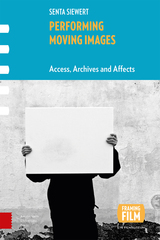 Performing Moving Images: Access, Archives and Affects
Senta Siewert
Amsterdam University Press, 2020 Performing Moving Images: Access, Archive and Affects presents institutions, individuals and networks who have ensured experimental films and Expanded Cinema of the 1960s and 1970s are not consigned to oblivion. Through a comparison of recent international case studies from festivals, museums, and gallery spaces, the book analyzes their new contexts, and describes the affective reception of those events. The study asks: what is the relationship between an aesthetic experience and memory at the point where film archives, cinema, and exhibition practices intersect? What can we learn from re-screenings, re-enactments, and found footage works, that are using archival material? How does the affective experience of the images, sounds and music resonate today? Performing Moving Images: Access, Archive and Affects proposes a theoretical framework from the perspective of the performative practice of programming, curating, and reconstructing, bringing in insights from original interviews with cultural agents together with an interdisciplinary academic discourse.
 Performing Palimpsest Bodies: Postmemory Theatre Experiments in Mexico
Ruth Hellier-Tinoco
Intellect Books, 2019 This book proposes the innovative concept of palimpsest bodies to interpret provocative theatre and performance experiments, exploring issues of cultural memory, history, transgression, and community transformation. Combined with ideas of postmemory and rememory, palimpsest bodies are inherently trans-temporal as they perform re-visions of embodied gestures, vocalized calls, and sensory experiences.
Focusing on four projects from one of Mexico’s most significant contemporary theatre companies, La Máquina de Teatro, directed by renowned artists Juliana Faesler and Clarissa Malheiros, this study documents the rigorous performances of layered, plural, and trans identities as collaborative, feminist, and queer re-visions of official histories and collective memories, using ideas of scenarios, archives, and remains. Illustrated with over 100 color photos, Performing Palimpsest Bodies will appeal to artists and scholars interested in contemporary theatre and performance studies, critical dance studies, and collective creation.
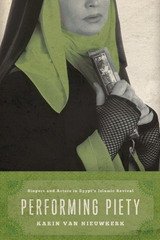 Performing Piety: Singers and Actors in Egypt's Islamic Revival
By Karin van Nieuwkerk
University of Texas Press, 2013 In the 1980s, Egypt witnessed a growing revival of religiosity among large sectors of the population, including artists. Many pious stars retired from art, “repented” from “sinful” activities, and dedicated themselves to worship, preaching, and charity. Their public conversions were influential in spreading piety to the Egyptian upper class during the 1990s, which in turn enabled the development of pious markets for leisure and art, thus facilitating the return of artists as veiled actresses or religiously committed performers. Revisiting the story she began in “A Trade like Any Other”: Female Singers and Dancers in Egypt, Karin van Nieuwkerk draws on extensive fieldwork among performers to offer a unique history of the religious revival in Egypt through the lens of the performing arts. She highlights the narratives of celebrities who retired in the 1980s and early 1990s, including their spiritual journeys and their influence on the “pietization” of their fans, among whom are the wealthy, relatively secular, strata of Egyptian society. Van Nieuwkerk then turns to the emergence of a polemic public sphere in which secularists and Islamists debated Islam, art, and gender in the 1990s. Finally, she analyzes the Islamist project of “art with a mission” and the development of Islamic aesthetics, questioning whether the outcome has been to Islamize popular art or rather to popularize Islam. The result is an intimate thirty-year history of two spheres that have tremendous importance for Egypt—art production and piety.
 Performing Populism: Visions of Spanish Politics from 15-M to Podemos
Ruben Perez Hidalgo
Vanderbilt University Press, 2023 Whether or not it constituted a complete break from the past, the 15-M movement’s most important legacy was a more expansive notion of the popular political, one that recognized cultural representation as a mode of political articulation and as part of a political culture. In an effort to understand the populist cycle inaugurated by 15-M, and to do so beyond a series of narrated events, Performing Populism sets out to explain Spanish populism in relation to the performances of its visual politics.
The book's first part examines how the 15-M movement created a new way of seeing that in turn led to a new way of doing politics in Spain. Part Two focuses on the multiple ramifications of that new vision once the people stopped marching and the movement became less visible.
From electoral posters to fiction films, documentaries, and internet memes, Performing Populism traces the ways that collective Spanish identities evolved from a period when "the people" seemed to have been willingly subsumed under the apathetic ideation of the middle-class consumer to the moment in 2011 when a crisis of representation forced many into political consciousness. This rude awakening kickstarted the reconstruction of a Spanish "us" that staged exhibitions of popular will on par with and parallel to the Arab Spring, but in a European register that embraced the countercultural through art that disremembered its political past but could not escape the ghostly shadow of its history.
Performing Process: Sharing Dance and Choreographic Practice
Edited by Emma Meehan and Hetty Blades
Intellect Books, 2018 Increasingly, choreographic process is examined, shared, and discussed in a variety of academic, artistic, and performative contexts. More than ever before, post-show discussions, artistic blogs, books, archives, and seminars provide opportunities for choreographers to explain their particular methodologies. Performing Process: Sharing Dance and Choreographic Practice provides a unique theoretical investigation of this current trend. The chapters in this collection examine the methods, politics, and philosophy of sharing choreographic process, aiming to uncover theoretical repercussions of and the implications for forms of knowledge, the appreciation of dance, education, and artistic practices.
 Performing Processes: Creating Live Performance
Edited by Roberta Mock
Intellect Books, 1995 Live performance continues to be created every time it is performed. This book explores the dynamic relationship between creative process, presentation and spectator response to provide students and scholars in Drama with new insights on performance from poetry to pantomime.
These essays make parallels between areas of performance that are rarely, if ever, compared. They present the basis for an overall theory of how 'conception', 'development', 'presentation' and 'reception' are fused together to make up the overall 'performance'. This study investigates the relationship between the process of creating performance and spectator response, and how this exchange is embedded into the product itself.
The authors draw on theoretical approaches from a range of sources, and examine the work of contemporary dramatists, choreographers, poets and performers including:
• Sarah Kane
• Iain Baxter
• Yolande Snaith
• Slobodan Snajder
• Phylis Nagy
• Steve Benson
• David Fielding
• David Antin
• Bette Midler
• Karen Malpede
• Stephen Daldry
• Mai Lanfang
Its construction of a new, wide-ranging approach to performance research makes this book a valuable resource for the student as well as the broader academic community. It has application both as a textbook and for supplementary research on drama courses nationwide.
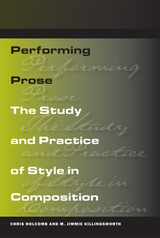 Performing Prose: The Study and Practice of Style in Composition
Chris Holcomb and M. Jimmie Killingsworth
Southern Illinois University Press, 2010 In Performing Prose, authors Chris Holcomb and M. Jimmie Killingsworth breathe new life into traditional concepts of style. Drawing on numerous examples from a wide range of authors and genres, Holcomb and Killingsworth demonstrate the use of style as a vehicle for performance, a way for writers to project themselves onto the page while managing their engagement with the reader. By addressing style and rhetoric not as an editorial afterthought, but as a means of social interaction, they equip students with the vocabulary and tools to analyze the styles of others in fresh ways, as well as create their own. Whereas most writing texts focus exclusively on analysis or techniques to improve writing, Holcomb and Killingsworth blend these two schools of thought to provide a singular process of thinking about writing. They discuss not only the benefits of conventional methods, but also the use of deviation from tradition; the strategies authors use to vary their style; and the use of such vehicles as images, tropes, and schemes. The goal of the authors is to provide writers with stylistic “footing”: an understanding of the ways writers use style to orchestrate their relationships with readers, subject matter, and rhetorical situations. Packed with useful tips and insights, this comprehensive volume investigates every aspect of style and its use to present an indispensable resource for both students and scholars. Performing Prose moves beyond customary studies to provide a refreshing and informative approach to the concepts and strategies of writing.
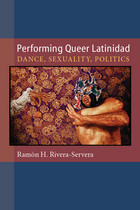 Performing Queer Latinidad: Dance, Sexuality, Politics
Ramón H. Rivera-Servera
University of Michigan Press, 2012 Performing Queer Latinidad highlights the critical role that performance played in the development of Latina/o queer public culture in the United States during the 1990s and early 2000s, a period when the size and influence of the Latina/o population was increasing alongside a growing scrutiny of the public spaces where latinidad could circulate. Performances---from concert dance and street protest to the choreographic strategies deployed by dancers at nightclubs---served as critical meeting points and practices through which LGBT and other nonnormative sex practitioners of Latin American descent (individuals with greatly differing cultures, histories of migration or annexation to the United States, and contemporary living conditions) encountered each other and forged social, cultural, and political bonds. At a time when latinidad ascended to the national public sphere in mainstream commercial and political venues and Latina/o public space was increasingly threatened by the redevelopment of urban centers and a revived anti-immigrant campaign, queer Latinas/os in places such as the Bronx, San Antonio, Austin, Phoenix, and Rochester, NY, returned to performance to claim spaces and ways of being that allowed their queerness and latinidad to coexist. These social events of performance and their attendant aesthetic communication strategies served as critical sites and tactics for creating and sustaining queer latinidad.
Performing Revolutionary: Art, Action, Activism
Nicole Garneau and Anne Cushwa
Intellect Books, 2018 The result of five years of practice-based creative research focused on Nicole Garneau’s UPRISING project, Performing Revolutionary presents a number of methods for the creation of politically charged interactive public events in the style of a how-to guide. UPRISING, a series of public demonstrations in eight locations in the United States and five in Europe, involved thousands of voluntary participants who came together to create radical change through performance art. Bringing together accounts by participants, writers, theorists, artists, and activists, as well as photographs and critical essays, Performing Revolutionary offers a fresh perspective on the challenges of moving from critique to action.
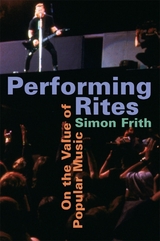 Performing Rites: On the Value of Popular Music
Simon Frith
Harvard University Press, 1998 Who's better? Billie Holiday or P. J. Harvey? Blur or Oasis? Dylan or Keats? And how many friendships have ridden on the answer? Such questions aren't merely the stuff of fanzines and idle talk; they inform our most passionate arguments, distill our most deeply held values, make meaning of our ever-changing culture. In Performing Rites, one of the most influential writers on popular music asks what we talk about when we talk about music. What's good, what's bad? What's high, what's low? Why do such distinctions matter? Instead of dismissing emotional response and personal taste as inaccessible to the academic critic, Simon Frith takes these forms of engagement as his subject--and discloses their place at the very center of the aesthetics that structure our culture and color our lives.
Taking up hundreds of songs and writers, Frith insists on acts of evaluation of popular music as music. Ranging through and beyond the twentieth century, Performing Rites puts the Pet Shop Boys and Puccini, rhythm and lyric, voice and technology, into a dialogue about the undeniable impact of popular aesthetics on our lives. How we nod our heads or tap our feet, grin or grimace or flip the dial; how we determine what's sublime and what's "for real"--these are part of the way we construct our social identities, and an essential response to the performance of all music. Frith argues that listening itself is a performance, both social gesture and bodily response. From how they are made to how they are received, popular songs appear here as not only meriting aesthetic judgments but also demanding them, and shaping our understanding of what all music means.
Performing Spanishness: History, Cultural Identity & Censorship in the Theatre of José María Rodríguez Méndez
Michael Thompson
Intellect Books, 1995 José María Rodríguez Méndez is a noted playwright, an acerbic cultural critic, and a political dissident under Franco. In Performing Spanishness, the first English-language examination of Méndez’s life and work, Michael Thompson sets the playwright’s lifelong struggle against censorship in the context of Spain’s shifting national identity. Méndez’s work presents “Spanishness” not as a static trait, but as an ongoing performance; Performing Spanishness is an indispensable resource to those interested in theater, Spain, and the relationship between art and activism.
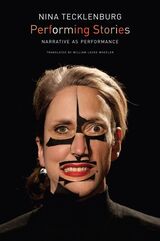 Performing Stories: Narrative as Performance
Nina Tecklenburg
Seagull Books, 2020 Retelling performances, collecting things, reading traces, mapping memories, gaming autobiographies: in European and Anglo-American theater since the turn of the millennium, a range of new nonliterary narrative practices such as these have taken root. Unable to be subsumed under a well-established narratological, dramatic, or postdramatic perspective, they call for a reexamination of the relationship between performance and narration. Performing Stories seeks to reconceptualize narrative against the backdrop of innovative theater formats such as collective storytelling games, theater installations, extensive autobiographical performances, immersive role-playing, and audio-video walks.
Nina Tecklenburg’s focus lies on narration less as literary composition than as sensate, embodied cultural practice—a participatory and open process that fosters social relationships. She gives central importance to the forces of narration that create and undo culture and politics. A foundational new book, Performing Stories presents a groundbreaking transdisciplinary perspective through new approaches that are stimulating to performance studies, narrative and cultural theory, literary criticism, and game and video studies.
 Performing Television: Contemporary Drama and the Media Culture
Elizabeth Klaver
University of Wisconsin Press, 2000 Is it possible today to understand current genres such as drama and theater without considering the influence of television? Elizabeth Klaver argues that television’s dominance of the entertainment industry demands a continual negotiation of subject position from all other cultural forms and institutions. By examining plays that incorporate televisual discourse—from cameras and monitors to televisual style and structure—Performing Television probes the turbulent relation contemporary drama has had to television and its negotiations for identity in a postmodern media culture.
Klaver applies post-structuralist theories of subjectivity to drama while ranging through Beckett’s plays, National Hockey League games, “The Tonight Show,” gay and lesbian drama, minority drama, avant-garde performance, and the topics of theatrical paranoia, the mediatized Imaginary, and the spectatorial gaze.
Performing Temporality in Contemporary European Dance: Unbecoming Rhythms
Jonas Rutgeerts
Intellect Books, 2023 Develops a new framework to understand performance and temporality in contemporary dance.
Performing Temporality in Contemporary European Dance probes rhythm, offbeats, and other patterns to examine how twenty-first-century choreographers perform time. Jonas Rutgeerts calls on the philosophical writings of Henri Bergson, Gilles Deleuze, and Gaston Bachelard to theorize work by choreographers renowned for their productively idiosyncratic approaches to dance: Jonathan Burrows, Matteo Fargion, Ivana Müller, Mette Edvardsen, and Mårten Spångberg. Rutgeerts analyzes syncopation in the work of Burrows and Fargion, hesitation in Müller’s While We Were Holding It Together, repetition in pieces by Edvardsen, and the audience’s experience of the present in Spångberg’s Natten.
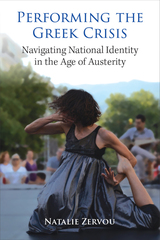 Performing the Greek Crisis: Navigating National Identity in the Age of Austerity
Natalie Zervou
University of Michigan Press, 2024 Performing the Greek Crisis explores the impact of the Greek financial crisis (2009–19) on the performing arts sector in Greece, and especially on contemporary concert dance. When Greece became the first European Union member to be threatened with default, the resulting budget cuts pushed dance to develop in unprecedented directions. The book examines the repercussions that the crisis had on artists’ daily lives and experiences, weaving the personal with the political to humanize a phenomenon that, to date, had been examined chiefly through economic and statistical lenses. Informed by the author’s experience of growing up in Greece and including interviews and rich descriptions of performances, the book offers a glimpse into a pivotal moment in Greek history.
In Greece, dance (and, by extension, the body) has historically held a central role in the process of national identity construction. When the crisis broke out, artists had to navigate through a precariously fluctuating landscape, with their bodies as their only stable referent. By centering the analysis of the Greek crisis on the dancing bodies, Performing the Greek Crisis is able to examine the various ways that artists reconceptualized their history and reframed ideas of national belonging, race, citizenship, and immigration.
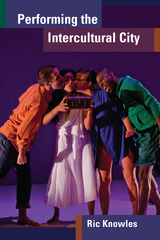 Performing the Intercultural City
Ric Knowles
University of Michigan Press, 2017 In 1971, Canada became the first country to adopt an official policy of multiculturalism. Performing the Intercultural City explores how Toronto—a representative global city in this multicultural country—stages diversity through its many intercultural theater companies and troupes. The book begins with a theoretical introduction to theatrical interculturalism. Subsequent chapters outline the historical and political context within which intercultural performance takes place; examine the ways in which Indigenous, Filipino, and Afro-Caribbean Canadian theater has developed play structures based on culturally specific forms of expression; and explore the ways that intercultural companies have used intermediality, modernist form, and intercultural discourse to mediate across cultures. Performing the Intercultural City will appeal to scholars, artists, and the theater-going public, including those in theater and performance studies, urban studies, critical multiculturalism studies, diaspora studies, critical cosmopolitanism studies, critical race theory, and cultural studies.
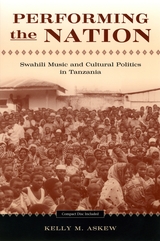 Performing the Nation: Swahili Music and Cultural Politics in Tanzania
Kelly Askew
University of Chicago Press, 2002 Since its founding in 1964, the United Republic of Tanzania has used music, dance, and other cultural productions as ways of imagining and legitimizing the new nation. Focusing on the politics surrounding Swahili musical performance, Kelly Askew demonstrates the crucial role of popular culture in Tanzania's colonial and postcolonial history.
As Askew shows, the genres of ngoma (traditional dance), dansi (urban jazz), and taarab (sung Swahili poetry) have played prominent parts in official articulations of "Tanzanian National Culture" over the years. Drawing on over a decade of research, including extensive experience as a taarab and dansi performer, Askew explores the intimate relations among musical practice, political ideology, and economic change. She reveals the processes and agents involved in the creation of Tanzania's national culture, from government elites to local musicians, poets, wedding participants, and traffic police. Throughout, Askew focuses on performance itself—musical and otherwise—as key to understanding both nation-building and interpersonal power dynamics.
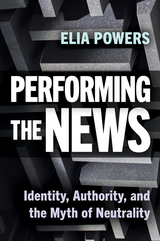 Performing the News: Identity, Authority, and the Myth of Neutrality
Elia Powers
Rutgers University Press, 2024 Performing the News: Identity, Authority, and the Myth of Neutrality explores how journalists from historically marginalized groups have long felt pressure to conform when performing for audiences. Many speak with a flat, “neutral” accent, modify their delivery to hide distinctive vocal attributes, dress conventionally to appeal to the “average” viewer, and maintain a consistent appearance to avoid unwanted attention. Their aim is what author Elia Powers refers to as performance neutrality—presentation that is deemed unobjectionable, reveals little about journalists’ social identity, and supposedly does not detract from their message. Increasingly, journalists are challenging restrictive, purportedly neutral forms of self-presentation. This book argues that performance neutrality is a myth that reinforces the status quo, limits on-air diversity, and hinders efforts to make newsrooms more inclusive. Through in-depth interviews with journalists in broadcasting and podcasting, and those who shape their performance, the author suggests ways to make journalism more inclusive and representative of diverse audiences.
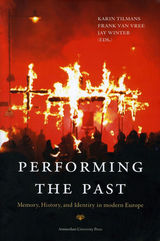 Performing the Past: Memory, History, and Identity in Modern Europe
Edited by Karin Tilmans, Frank van Vree, and Jay M. Winter
Amsterdam University Press, 2010
Throughout Europe, narratives about the past circulate at a dizzying speed, and producing and selling these narratives is big business. In museums, in cinema and opera houses, in schools, and even on the Internet, Europeans are using the power of performance to craft stories that ultimately define the ways their audiences understand and remember history.
Performing the Past offers unparalleled insights into the philosophical, literary, musical, and historical frameworks within which the past has entered into the European imagination. The essays in this volume, from such internationally renowned scholars as Reinhart Koselleck, Jan Assmann, Jane Caplan, Marianne Hirsch, Leo Spitzer, Peter Burke, and Alessandro Portelli, investigate various national and disciplinary traditions to explain how Europeans see themselves in the past, in the present, and in the years to come.
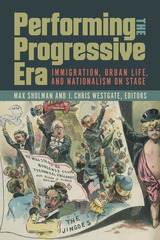 Performing the Progressive Era: Immigration, Urban Life, and Nationalism on Stage
Max Shulman and J. Chris Westgate
University of Iowa Press, 2019 The American Progressive Era, which spanned from the 1880s to the 1920s, is generally regarded as a dynamic period of political reform and social activism. In Performing the Progressive Era, editors Max Shulman and Chris Westgate bring together top scholars in nineteenth- and twentieth-century theatre studies to examine the burst of diverse performance venues and styles of the time, revealing how they shaped national narratives surrounding immigration and urban life. Contributors analyze performances in urban centers (New York, Chicago, Cleveland) in comedy shows, melodramas, Broadway shows, operas, and others. They pay special attention to performances by and for those outside mainstream society: immigrants, the working-class, and bohemians, to name a few. Showcasing both lesser-known and famous productions, the essayists argue that the explosion of performance helped bring the Progressive Era into being, and defined its legacy in terms of gender, ethnicity, immigration, and even medical ethics.
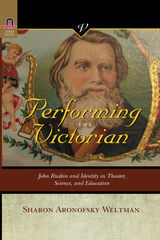 PERFORMING THE VICTORIAN: JOHN RUSKIN AND IDENTITY IN THEATER, SCIENCE, AND EDUCATION
SHARON ARONOFSKY WELTMAN
Ohio State University Press, 2007 Performing the Victorian: John Ruskin and Identity in Theater, Science, and Education by Sharon Aronofsky Weltman is the first book to examine Ruskin’s writing on theater. In works as celebrated as Modern Painters and obscure as Love’s Meinie, Ruskin uses his voracious attendance at the theater to illustrate points about social justice, aesthetic practice, and epistemology. Opera, Shakespeare, pantomime, French comedies, juggling acts, and dance prompt his fascination with performed identities that cross boundaries of gender, race, nation, and species. These theatrical examples also reveal the primacy of performance to his understanding of science and education. In addition to Ruskin on theater, Performing the Victorian interprets recent theater portraying Ruskin (The Invention of Love, The Countess, the opera Modern Painters) as merely a Victorian prude or pedophile against which contemporary culture defines itself. These theatrical depictions may be compared to concurrent plays about Ruskin’s friend and student Oscar Wilde (Gross Indecency: The Three Trials of Oscar Wilde, The Judas Kiss). Like Ruskin, Wilde is misrepresented on the fin-de-millennial stage, in his case anachronistically as an icon of homosexual identity. These recent characterizations offer a set of static identity labels that constrain contemporary audiences more rigidly than the mercurial selves conjured in the prose of either Ruskin or Wilde.
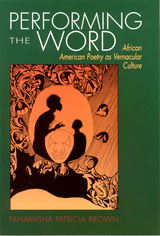 Performing The Word: African American Poetry As Vernacular Culture
Brown, Fahamisha Patricia
Rutgers University Press, 1999 Performing the Word offers readers of African American poetry a way of understanding and appreciating body of work that has received little critical attention. While African American literary tradition begins with eighteenth-century poets like Lucy Terry, Jupiter Hammon, and Phillis Wheatley, critical discussions of African American Poetry have been sparse. Aside from a few studies of "major" poets, such as Langston Hughes, Gwendolyn Brooks, Robert Hayden, Rita Dove, or period histories of phenomena such as the Harlem Renaissance, there has been little sustained critical inquiry into African American poetry as a body of literature- until now.
Fahamista Patricia Brown examines elements of African American expressive culture- its language practices, both fold and popular. Her book is an excellent introduction to a diverse group of poets and the common basis of their work in language practices and performativity, in the expressive culture of a people. Performing the Word is an important contribution to the understanding of African American culture and American poetry as a whole.
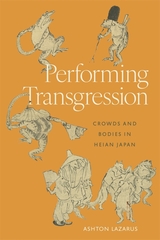 Performing Transgression: Crowds and Bodies in Heian Japan
Ashton Lazarus
Harvard University Press What happens when performance defies social and political boundaries? Performing Transgression offers a new cultural history of non-elite spectacle in Heian Japan (794–1185), uncovering how performances on the margins—boisterous dengaku music and dance, daring sangaku acrobatics, and the infectious lyrics of imayō songs—challenged and fascinated the aristocracy.
Ashton Lazarus reveals how these unruly arts were documented by the very elites they unsettled, appearing in historical chronicles, diaries, prose, poetry, and illustrated scrolls. More than mere precursors to later forms like noh and kyōgen, these performances formed a dynamic cultural force with real political impact. By tracing their influence through literary studies, performance studies, and historiography, Lazarus rethinks the interplay between politics, class, and culture in Heian Japan.
Performing Transgression illuminates how acts of defiance and creative expression resonate across time, offering fresh insights into the ways performance bridges the vanished past and the present.
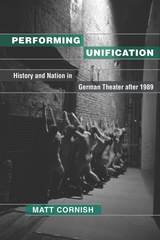 Performing Unification: History and Nation in German Theater after 1989
Matt Cornish
University of Michigan Press, 2017 Since the moment after the fall of the Berlin Wall, important German theater artists have created plays and productions about unification. Some have challenged how German history is written, while others opposed the very act of storytelling. Performing Unification examines how directors, playwrights, and theater groups including Heiner Müller, Frank Castorf, and Rimini Protokoll have represented and misrepresented the past, confronting their nation’s history and collective identity. Matt Cornish surveys German-language history plays from the Baroque period through the documentary theater movement of the 1960s to show how German identity has always been contested, then turns to performances of unification after 1989. Cornish argues that theater, in its structures and its live gestures, on pages, stages, and streets, helps us to understand the past and its effect on us, our relationships with others in our communities, and our futures. Engaging with theater theory from Aristotle through Bertolt Brecht and Hans-Thies Lehmann’s “postdramatic” theater, and with theories of history from Hegel to Walter Benjamin and Hayden White, Performing Unification demonstrates that historiography and dramaturgy are intertwined.
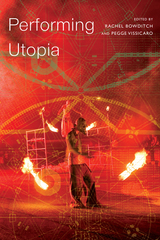 Performing Utopia
Edited by Rachel Bowditch and Pegge Vissicaro
Seagull Books, 2016 In her landmark study Utopia in Performance: Finding Hope at the Theatre, Jill Dolan departed from historical writings on utopia, which suggest that social reorganization and the redistribution of wealth are utopian efforts, to argue instead that utopia occurs in fragmentary “utopian moments,” often found embedded within performance. While Dolan focused on the utopian performative within a theatrical context, this volume, edited by Rachel Bowditch and Pegge Vissicaro, expands her theories to encompass performance in public life—from diasporic hip-hop battles, Chilean military parades, commemorative processions, Blackfoot powwows, and post-Katrina Mardi Gras to the Philadelphia Mummers Parade, Festas Juninas in Brazil, the Renaissance Fairs in Arizona, and neoburlesque competitions.
How do these performances rehearse and enact visions of a utopic world? What can the lens of utopia and dystopia illuminate about the potential of performing bodies to transform communities, identities, values, and beliefs across time? Performing Utopia not only answers these questions, but offers a diverse collection of case studies focusing on utopias, dystopias, and heterotopias enacted through the performing body.
 Performing Violence: Literary and Theatrical Experiments of New Russian Drama
Birgit Beumers and Mark Lipovetsky
Intellect Books, 2009 The so-called “New Russian Drama” emerged at the end of the twentieth century, following a long period of decline in dramatic writing in the late Soviet and post-Soviet era. In Performing Violence, Birgit Beumers and Mark Lipovetsky examine the representation of violence in these new dramatic works by young Russian playwrights. Reflecting the disappointment in Yeltsin’s democratic reforms and Putin’s neoconservative politics, the plays focus on political and social representations of violence, its performances, and its justifications. As the first English-language study of Russian drama and theatre in the twenty-first century, Performing Violence seeks a vantage point for the analysis of brutality in post-Soviet culture. While previous generations had preferred poetry and prose, this new breed of authors—the Presnyakov brothers, Evgeni Grishkovets, and Vasili Sigarev among them—have garnered international recognition for their fierce plays. This book investigates the violent portrayal of the identity crisis of a generation as represented in their theatrical works, and will be a key text for students and scholars of drama, Russian studies, and literature.
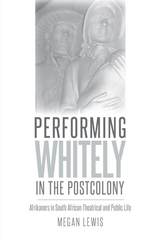 Performing Whitely in the Postcolony: Afrikaners in South African Theatrical and Public Life
Megan Lewis
University of Iowa Press, 2016 What does it mean to perform whiteness in the postcolonial era? To answer this question—crucial for understanding the changing meanings of race in the twenty-first century—Megan Lewis examines the ways that members of South Africa’s Afrikaner minority have performed themselves into, around, and out of power from the colonial period to the postcolony. The nation’s first European settlers and in the twentieth century the architects of apartheid, since 1994 Afrikaners have been citizens of a multicultural, multilingual democracy. How have they enacted their whiteness in the past, and how do they do so now when their privilege has been deflated?
Performing Whitely examines the multiple speech acts, political acts, and theatrical acts of the Afrikaner volk or nation in theatrical and public life, including pageants, museum sites, film, and popular music as well as theatrical productions. Lewis explores the diverse ways in which Afrikaners perform whitely, and the tactics they use, including nostalgia, melodrama, queering, abjection, and kitsch. She first investigates the way that apartheid’s architects leveraged whiteness in support of their nation-building efforts in the early twentieth century. In addition to re-enacting national pilgrimages of colonial-era migrations and building massive monuments at home, Afrikaner nationalists took their show to the United States, staging critical events of the Boer War at the 1904 St. Louis Exposition. A case study of the South African experience, Performing Whitely also offers parables for global whitenesses in the postcolonial era.
 Performing with the Dead: Trances and Traces
Christopher "Kit" Danowski
Intellect Books, 2024 A methodology for incorporating concepts drawn from ancestor trance in Afrolatinx ritual into Western theatrical training.
In this book, Kit Danowski constructs a methodology called kanga (from the Bantu for tying and untying), using three methods based on aspects of the Afrolatinx ritual and modified for performance contexts: spell, charm, and trance. This methodology enacts and complicates distinctions between performance and ritual, serving as a contribution to respectful and responsible intercultural performance practices. The methodology is bricoleur, drawing from ethnography, psychoanalytic theory, and phenomenology. Kanga in practice leads to a state of consciousness that Danowski calls hauntological. This borrows from Derrida but is redefined to refer to the study of haunted states of consciousness, where reality is coconstituted by the living and the dead and ancestral spirits are invoked to do the work once reserved for characters.
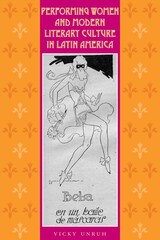 Performing Women and Modern Literary Culture in Latin America: Intervening Acts
By Vicky Unruh
University of Texas Press, 2006 Women have always been the muses who inspire the creativity of men, but how do women become the creators of art themselves? This was the challenge faced by Latin American women who aspired to write in the 1920s and 1930s. Though women's roles were opening up during this time, women writers were not automatically welcomed by the Latin American literary avant-gardes, whose male members viewed women's participation in tertulias (literary gatherings) and publications as uncommon and even forbidding. How did Latin American women writers, celebrated by male writers as the "New Eve" but distrusted as fellow creators, find their intellectual homes and fashion their artistic missions? In this innovative book, Vicky Unruh explores how women writers of the vanguard period often gained access to literary life as public performers. Using a novel, interdisciplinary synthesis of performance theory, she shows how Latin American women's work in theatre, poetry declamation, song, dance, oration, witty display, and bold journalistic self-portraiture helped them craft their public personas as writers and shaped their singular forms of analytical thought, cultural critique, and literary style. Concentrating on eleven writers from Argentina, Brazil, Cuba, Mexico, Peru, and Venezuela, Unruh demonstrates that, as these women identified themselves as instigators of change rather than as passive muses, they unleashed penetrating critiques of projects for social and artistic modernization in Latin America.
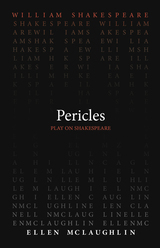 Pericles
William Shakespeare
Arizona Center for Medieval and Renaissance Studies, 2023 The heroic story of Pericles adapted for new audiences by Ellen McLaughlin.
Shakespeare’s romance Pericles follows Pericles, the Prince of Tyre, on a series of adventures across the Mediterranean Sea. Navigating one heroic challenge after another, Pericles strives to be reunited with his wife and child. Ellen McLaughlin’s translation of Pericles illuminates Shakespeare’s text, untangling syntax and bringing forth the poetry of the verse. An encounter between the contemporary and the iconic, this translation brings the play to life as audiences would have experienced it in Shakespeare’s time.
This translation of Pericles was written as part of the Oregon Shakespeare Festival’s Play On! project, which commissioned new translations of thirty-nine Shakespeare plays. These translations present work from “The Bard” in language accessible to modern audiences while never losing the beauty of Shakespeare’s verse. Enlisting the talents of a diverse group of contemporary playwrights, screenwriters, and dramaturges from diverse backgrounds, this project reenvisions Shakespeare for the twenty-first century. These volumes make these works available for the first time in print—a new First Folio for a new era.
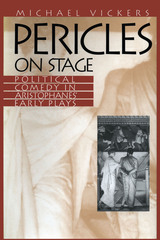 Pericles on Stage: Political Comedy in Aristophanes' Early Plays
By Michael Vickers
University of Texas Press, 1996 Since the eighteenth century, classical scholars have generally agreed that the Greek playwright Aristophanes did not as a matter of course write "political" plays. Yet, according to an anonymous Life of Aristophanes, when Dionysius the tyrant of Syracuse wanted to know about the government of Athens, Plato sent him a copy of Aristophanes' Clouds. In this boldly revisionist work, Michael Vickers convincingly argues that in his earlier plays, Aristophanes in fact commented on the day-to-day political concerns of Athenians. Vickers reads the first six of Aristophanes' eleven extant plays in a way that reveals the principal characters to be based in large part on Pericles and his ward Alcibiades. According to Vickers, the plays of Aristophanes—far from being nonpolitical—actually allow us to gauge the reaction of the Athenian public to the events that followed Pericles' death in 429 B.C., to the struggle for the political succession, and to the problems presented by Alcibiades' emergence as one of the most powerful figures in the state. This view of Aristophanes reaffirms the central role of allegory in his work and challenges all students of ancient Greece to rethink long-held assumptions about this important playwright.
Perigee
Diane Kerr
University of Wisconsin Press, 2020 In these visceral poems, Diane Kerr reckons with dark trauma. Retracing memories from girlhood that she once felt compelled to keep secret, perspectives shift as the lens of adulthood brings the past into sharp clarity.
Moments are revealed in layers; we join the poet as she rides through fields on horseback, watches a woman testify on television, and comes to terms with her experiences of sexual abuse. Vivid recollections of emotionally charged minutiae—broken-in cowboy boots, the second button on a blouse, a housecoat patterned with pink begonias—remind us how even the smallest details can be fraught with both nostalgia and pain. Each poem wields power, with resonating narratives of fear and survival reminding us that suffering has no statute of limitations.
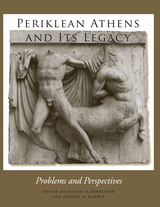 Periklean Athens and Its Legacy: Problems and Perspectives
Edited by Judith M. Barringer and Jeffrey M. Hurwit
University of Texas Press, 2005 The late fifth century BC was the golden age of ancient Athens. Under the leadership of the renowned soldier-statesman Perikles, Athenians began rebuilding the Akropolis, where they created the still awe-inspiring Parthenon. Athenians also reached a zenith of artistic achievement in sculpture, vase painting, and architecture, which provided continuing inspiration for many succeeding generations. The specially commissioned essays in this volume offer a fresh, innovative panorama of the art, architecture, history, culture, and influence of Periklean Athens. Written by leading experts in the field, the articles cover a wide range of topics, including: - An evaluation of Perikles' military leadership during the early stages of the Peloponnesian War.
- Iconographical and iconological studies of vase paintings, wall paintings, and sculpture.
- Explorations of the Parthenon and other monuments of the Athenian Akropolis.
- The legacy of Periklean Athens and its influence upon later art.
- Assessments of the modern reception of the Akropolis.
As a whole, this collection of essays proves that even a well-explored field such as Periklean Athens can yield new treasures when mined by perceptive and seasoned investigators.
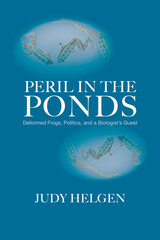 Peril in the Ponds: Deformed Frogs, Politics, and a Biologist's Quest
Judy Helgen
University of Massachusetts Press, 2012
Peril in the Ponds tells the story of a government biologist's investigation into the mystery of deformed frogs, an epidemic that grew during the 1990s and continues today. It provides an inside view of a highly charged environmental issue that aroused the attention of the public and the media and sparked controversies among scientists, politicians, and government agencies.
By the 1990s, wetlands across the United States were endangered from pollution and decades of drainage to convert them into farmland and urban developments. But when deformed frogs—many with missing legs or eyes, footless stumps, or misshapen jaws—began to emerge from Minnesota wetlands, alarm bells went off. What caused such deformities? Pollution? Ultraviolet rays? Biological agents? And could the mysterious cause also pose a threat to humans?
Judy Helgen writes with passionate concern about vulnerable frogs and wetlands as she navigates through a maze of inquisitive media and a reluctant government agency. She reports on the complexity of a growing catastrophe for frogs and broadens the issue as she researches and meets with scientists from around the world. She affirms the importance of examining aquatic life to understand pollution and the need to rescue our remaining wetlands. She also shares the fears expressed by the teachers, students, and other citizens who found these creatures, sensed a problem, and looked to her for answers. Ultimately, this is a story about the biological beauty of wetlands and our need to pay attention to the environment around us.
Perilous Balance
Arnold Stein
University of Minnesota Press, 1945 Perilous Balance was first published in 1945. Minnesota Archive Editions uses digital technology to make long-unavailable books once again accessible, and are published unaltered from the original University of Minnesota Press editions.
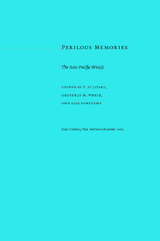 Perilous Memories: The Asia-Pacific War(s)
T. Fujitani, Geoffrey M. White, Lisa Yoneyama, eds.
Duke University Press, 2001 Perilous Memories makes a groundbreaking and critical intervention into debates about war memory in the Asia-Pacific region. Arguing that much is lost or erased when the Asia-Pacific War(s) are reduced to the 1941–1945 war between Japan and the United States, this collection challenges mainstream memories of the Second World War in favor of what were actually multiple, widespread conflicts. The contributors recuperate marginalized or silenced memories of wars throughout the region—not only in Japan and the United States but also in China, Southeast Asia, the Pacific Islands, Okinawa, Taiwan, and Korea. Firmly based on the insight that memory is always mediated and that the past is not a stable object, the volume demonstrates that we can intervene positively yet critically in the recovery and reinterpretation of events and experiences that have been pushed to the peripheries of the past. The contributors—an international list of anthropologists, cultural critics, historians, literary scholars, and activists—show how both dominant and subjugated memories have emerged out of entanglements with such forces as nationalism, imperialism, colonialism, racism, and sexism. They consider both how the past is remembered and also what the consequences may be of privileging one set of memories over others. Specific objects of study range from photographs, animation, songs, and films to military occupations and attacks, minorities in wartime, “comfort women,” commemorative events, and postwar activism in pursuing redress and reparations. Perilous Memories is a model for war memory intervention and will be of interest to historians and other scholars and activists engaged with collective memory, colonial studies, U.S. and Asian history, and cultural studies. Contributors. Chen Yingzhen, Chungmoo Choi, Vicente M. Diaz, Arif Dirlik, T. Fujitani, Ishihara Masaie, Lamont Lindstrom, George Lipsitz, Marita Sturken, Toyonaga Keisaburo, Utsumi Aiko, Morio Watanabe, Geoffrey M. White, Diana Wong, Daqing Yang, Lisa Yoneyama
Perilous Missions: Civil Air Transport and CIA Covert Operations in Asia
William M. Leary
University of Alabama Press, 2005 Civil Air Transport (CAT), founded in China after World War II by Claire Chennault and Whiting Willauer, was initially a commercial carrier specializing in air freight. Its role quickly changed as CAT became first a paramilitary adjunct of the Nationalist Chinese Air Force, then the CIA's secret "air force" in Korea, then "the most shot-at airline in the world" in French Indochina, and eventually becoming reorganized as Air America at the height of the Vietnam War. William M. Leary's detailed operational history of CAT sets the story in the perspective of Asian and Cold War geopolitics and shows how CAT allowed the CIA to operate with a level of flexibility and secrecy that it would not have attained through normal military or commercial air transportation.
 Perilous Performances: Gender and Regency in Early Modern France
Katherine Crawford
Harvard University Press, 2004 In a book addressing those interested in the transformation of monarchy into the modern state and in intersections of gender and political power, Katherine Crawford examines the roles of female regents in early modern France.
The reigns of child kings loosened the normative structure in which adult males headed the body politic, setting the stage for innovative claims to authority made on gendered terms. When assuming the regency, Catherine de Médicis presented herself as dutiful mother, devoted widow, and benign peacemaker, masking her political power. In subsequent regencies, Marie de Médicis and Anne of Austria developed strategies that naturalized a regendering of political structures. They succeeded so thoroughly that Philippe d’Orleans found that this rhetoric at first supported but ultimately undermined his authority. Regencies demonstrated that power did not necessarily work from the places, bodies, or genders in which it was presumed to reside.
While broadening the terms of monarchy, regencies involving complex negotiations among child kings, queen mothers, and royal uncles made clear that the state continued regardless of the king—a point not lost on the Revolutionaries or irrelevant to the fate of Marie-Antoinette.
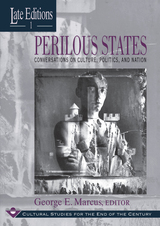 Perilous States: Conversations on Culture, Politics, and Nation
Edited by George E. Marcus
University of Chicago Press, 1993 Encompassing a range of disciplines—notably anthropology,
politics, history, comparative literature, and
philosophy—the unprecedented annual publication Late
Editions exposes unsettling dilemmas and unprecedented
challenges facing cultural studies on the brink of the
twenty-first century. Successive volumes will appear
annually until the year 2000, each engaging the predicaments
of particular institutions, nations, and persons at this
point of social, cultural, and political change. The
project will test the limits of scholarly conventions by
finding new ways to expose cultural formations emerging from
the maturation or exhaustion of once-powerful ideas whose
validity is now deeply in question.
Perilous States, the first volume of Late
Editions, presents conversations between American
scholars, most of whom are anthropologists, and individuals
situated amidst political and social upheaval. Pimarily but
not exclusively from Eastern Europe, the cast includes
Russian writers, Hungarian scientists and academics, Armenian
politicians, Siberian religious and medical leaders, a Gypsy
leader, a Polish poet, a French politician, and a white South
African musician who is a self-styled Zulu. Their voices
unite around themes of democracy, market economy, individual
rights, and the reawakened force of suppressed ethnic and
racial identities.
To obtain fresh perspectives on these cultural and social
transformations, the volumes will consist of in-depth
conversations, relayed in essay form, between scholars and
individuals in other cultures with whom they share
affinities. This novel approach blends the immediacy of
interviews, the objectivity of journalism, and the
intellectual rigor of scholarship.
Contributors to this volume are Marjorie Balzer, Sam
Beck, David B. Coplan, Michael M. J. Fischer, Nia Georges,
Bruce Grant, Douglas R. Holmes, Stella Gregorian, George E.
Marcus, Kathryn Milun, Eleni Papagaroufali, Paul Rabinow,
Julie Taylor, and Tom White.
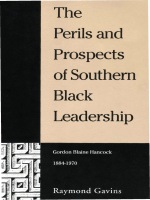 The Perils and Prospects of Southern Black Leadership: Gordon Blaine Hancock, 1884–1970
Raymond Gavins
Duke University Press, 1993 The Perils and Prospects of Southern Black Leadership fills an important gap in uncovering the history of southern black leaders between the death of Booker T. Washington and the rise of Martin Luther King, Jr. Originally published to critical acclaim in 1977 (Duke University Press), and now available in paperback with a new preface by the author, this book provides an intellectual biography of Gordon Blaine Hancock, a Virginia educator, journalist, and minister whose writings and speeches on race relations were widely influential in the South in the thirty years prior to the Brown decision of 1954. In showing how Hancock faced his generation's main dilemma—how to end Jim Crow and ensure integration without abandoning ideals of black identity, independence, and solidarity—Raymond Gavins's biography illuminates the history of African Americans and race relations in America.
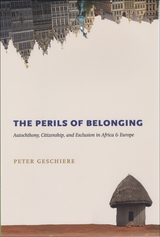 The Perils of Belonging: Autochthony, Citizenship, and Exclusion in Africa and Europe
Peter Geschiere
University of Chicago Press, 2009 Despite being told that we now live in a cosmopolitan world, more and more people have begun to assert their identities in ways that are deeply rooted in the local. These claims of autochthony—meaning “born from the soil”—seek to establish an irrefutable, primordial right to belong and are often employed in politically charged attempts to exclude outsiders. In The Perils of Belonging, Peter Geschiere traces the concept of autochthony back to the classical period and incisively explores the idea in two very different contexts: Cameroon and the Netherlands. In both countries, the momentous economic and political changes following the end of the cold war fostered anxiety over migration. For Cameroonians, the question of who belongs where rises to the fore in political struggles between different tribes, while the Dutch invoke autochthony in fierce debates over the integration of immigrants. This fascinating comparative perspective allows Geschiere to examine the emotional appeal of autochthony—as well as its dubious historical basis—and to shed light on a range of important issues, such as multiculturalism, national citizenship, and migration.
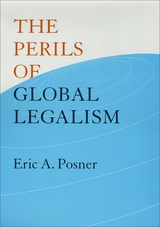 The Perils of Global Legalism
Eric A. Posner
University of Chicago Press, 2009 The first months of the Obama administration have led to expectations, both in the United States and abroad, that in the coming years America will increasingly promote the international rule of law—a position that many believe is both ethically necessary and in the nation’s best interests. With The Perils of Global Legalism, Eric A. Posner explains that such views demonstrate a dangerously naive tendency toward legalism—an idealistic belief that law can be effective even in the absence of legitimate institutions of governance. After tracing the historical roots of the concept, Posner carefully lays out the many illusions—such as universalism, sovereign equality, and the possibility of disinterested judgment by politically unaccountable officials—on which the legalistic view is founded. Drawing on such examples as NATO’s invasion of Serbia, attempts to ban the use of land mines, and the free-trade provisions of the WTO, Posner demonstrates throughout that the weaknesses of international law confound legalist ambitions—and that whatever their professed commitments, all nations stand ready to dispense with international agreements when it suits their short- or long-term interests. Provocative and sure to be controversial, The Perils of Global Legalism will serve as a wake-up call for those who view global legalism as a panacea—and a reminder that international relations in a brutal world allow no room for illusions.
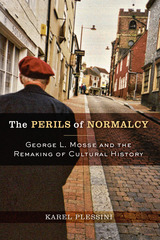 The Perils of Normalcy: George L. Mosse and the Remaking of Cultural History
Karel Plessini
University of Wisconsin Press, 2014 A taboo-breaker and a great provocateur, George L. Mosse (1918–99) was one of the great historians of the twentieth century, forging a new historiography of culture that included brilliant insights about the roles of nationalism, fascism, racism, and sexuality. Jewish, gay, and a member of a culturally elite family in Germany, Mosse came of age as the Nazis came to power, before escaping as a teenager to England and America. Mosse was innovative and interdisciplinary as a scholar, and he shattered in his groundbreaking books prevalent assumptions about the nature of National Socialism and the Holocaust. He audaciously drew a link from bourgeois respectability and the ideology of the Enlightenment—the very core of modern Western civilization—to the extermination of the European Jews.
In this intellectual biography of George Mosse, Karel Plessini draws on all of Mosse's published and unpublished work to illuminate the origins and development of his groundbreaking methods of historical analysis and the close link between his life and work. He redefined the understanding of modern mass society and politics, masterfully revealing the powerful influence of conformity and political liturgies on twentieth-century history. Mosse warned against the dangers inherent in acquiescence, showing how identity creation and ideological fervor can climax in intolerance and mass murder—a message of continuing relevance.
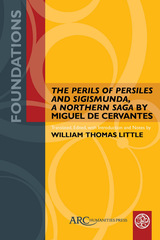 "The Perils of Persiles and Sigismunda, a Northern Saga" by Miguel de Cervantes
William Thomas Little
Arc Humanities Press, 2023
Los trabajos de Persiles y Sigismunda, historia septentrional (1617) is Miguel de Cervantes’s last major work. Virtually ignored for the past four hundred years and overshadowed by the acclaim accorded Don Quixote, it is due a revival. As indicated by this new English title, The Perils of Persiles and Sigismunda, a Northern Saga, this challenging saga-like fiction follows an attractive young prince and princess who undertake a perilous pilgrimage by sea and on land from their North Atlantic islands to Rome.
This new translation by William Thomas Little takes full account of recent scholars’ ground-breaking research and their new readings. It also includes a selected bibliography, a contextualizing introduction, and footnotes on the text that clarify for contemporary readers cultural issues that were readily known to seventeenth-century readers in Spain, France, Italy, Portugal, and England.
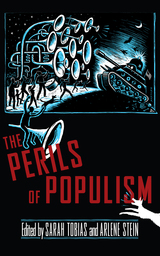 The Perils of Populism
Sarah Tobias
Rutgers University Press, 2022 From Donald Trump in the U.S. to Jair Bolsonaro in Brazil, Viktor Orbán in Hungary, and Narendra Modi in India, right-wing populist leaders have taken power in many parts of the world. While each country’s populist movement is distinct, they are united by several key features, including the presence of a boastful strongman leader and the scapegoating of vulnerable populations, especially immigrants, people of color, LGBTQ people, and women.
The Perils of Populism shows how a feminist lens can help diagnose the factors behind the global rise of right-wing populism and teach us how to resist the threat it presents to democracy. Featuring interdisciplinary essays about politics in the United States, the Middle East, Europe, and India from a variety of acclaimed theorists and activists, the volume contributes to a rapidly expanding literature on gender and the far right. Together, these chapters offer a truly intersectional analysis of the problem, addressing everything from how populism has thrived in a “post-truth” era to the ways it appeals to working-class voters looking for an alternative to neoliberalism. Yet the authors also find reasons to be hopeful, as they showcase forms of grassroots feminist activism that challenge right-wing populism by advocating for racial and economic justice.
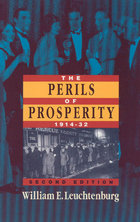 The Perils of Prosperity, 1914-1932
William E. Leuchtenburg
University of Chicago Press, 1993 Beginning with Woodrow Wilson and U.S. entry into World War I and closing with the Great Depression, The Perils of Prosperity traces the transformation of America from an agrarian, moralistic, isolationist nation into a liberal, industrialized power involved in foreign affairs in spite of itself.
William E. Leuchtenburg's lively yet balanced account of this hotly debated era in American history has been a standard text for many years. This substantial revision gives greater weight to the roles of women and minorities in the great changes of the era and adds new insights into literature, the arts, and technology in daily life. He has also updated the lists of important dates and resources for further reading.
“This book gives us a rare opportunity to enjoy the matured interpretation of an American Historian who has returned to the story and seen how recent decades have added meaning and vividness to this epoch of our history.”—Daniel J. Boorstin, from the Preface
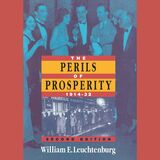 The Perils of Prosperity, 1914-1932
William E. Leuchtenburg
University of Chicago Press, 1993 This is an auto-narrated audiobook version of this book.
Beginning with Woodrow Wilson and U.S. entry into World War I and closing with the Great Depression, The Perils of Prosperity traces the transformation of America from an agrarian, moralistic, isolationist nation into a liberal, industrialized power involved in foreign affairs in spite of itself.
William E. Leuchtenburg's lively yet balanced account of this hotly debated era in American history has been a standard text for many years. This substantial revision gives greater weight to the roles of women and minorities in the great changes of the era and adds new insights into literature, the arts, and technology in daily life. He has also updated the lists of important dates and resources for further reading.
“This book gives us a rare opportunity to enjoy the matured interpretation of an American Historian who has returned to the story and seen how recent decades have added meaning and vividness to this epoch of our history.”—Daniel J. Boorstin, from the Preface
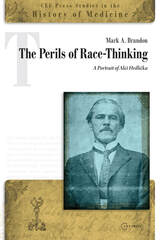 The Perils of Race-Thinking: A Portrait of Ale. Hrdlicka
Mark A. Brandon
Central European University Press, 2023 Eugenics and scientific racism are experiencing a resurgence, and an understanding of the ideas of Aleš Hrdlička can help combat them. Today, the racial science of the early twentieth century is both untenable and contemptible. This book is about an arch figure of that period: Aleš Hrdlička served as Curator of Physical Anthropology at the prestigious Smithsonian Institution from 1910 to 1941. Although his ideas about race are today considered pseudoscience, the uncomfortable truth is that he was an internationally respected scientist in his own day. The Perils of Race-Thinking advances a bold new interpretation of modern racial ideology by exploring Hrdlička’s intellectual world. Using previously untapped Czech-language sources, Brandon irrevocably alters the discussion about this important figure by placing Czech nationalism at the center of his racial thinking. Defying disciplinary categories, Perils of Race-Thinking joins critical analysis of this key American anthropologist with an incisive revisionist perspective of interwar Czechoslovakia to unearth transnational racial presumptions lurking behind the worst crimes of the twentieth century. At the center of Hrdlička’s race beliefs was his commitment to Czech and Slovak unity and independence. From this center, his next level of concern was what he believed to be a millennial racial struggle between Germans and Slavs. On a global scale, he viewed the Slavs, and especially the Soviet Union, as a eugenic bastion of White strength holding off the “rising tide of color.” Step by step, Perils of Race-Thinking mercilessly dismantles Hrdlička’s racial system and exposes it as mysticism dressed up in the language of science. Convinced that human individuals belonged “naturally” in racial groups, Hrdlička embraced a revolutionary program of reordering the globe according to a harrowing morality of “Darwinist” struggle. Yet despite a lifetime of measuring body parts, even Hrdlička could not decide how many races there were or how to tell them apart.
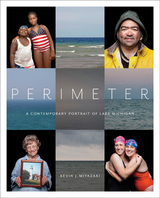 Perimeter: A Contemporary Portrait of Lake Michigan
Kevin J. Miyazaki
Wisconsin Historical Society Press, 2014 Commissioned by the Haggerty Museum of Art at Marquette University to create an artwork reflecting on the importance of freshwater, Milwaukee-based photographer Kevin J. Miyazaki embarked on a two-week, 1,800-mile drive around Lake Michigan. He traveled its perimeter, through Wisconsin, Illinois, Indiana, and Michigan, to produce what he calls “a contemporary portrait of Lake Michigan.” Miyazaki set up his portable studio on beaches, in parks, on boat docks, and in backyards, photographing those he met along the way. From residents, environmental scientists, and artists to a Native American water rights advocate, surfers, and commercial fishermen, Lake Michigan holds a powerful place in the life of each. Many shared their thoughts with him on why this body of water is important to all.
Miyazaki also photographed the water as he went, creating waterscapes of the ever-changing lake affected by weather and time. Perimeter gathers these images together, creating a diverse portrait of both people and a place, encapsulating Lake Michigan’s significance to those who are drawn to it.
Period Piece
Gwen Raverat
University of Michigan Press, 1991 At the close of 1952, Bettrand Russell wrote to Gwen Raverat that he had been reading Period Piece “with the very greatest delight.” Raverat’s memories of childhood and coming of age during the final years of Victoria’s reign capture a young woman’s impressions of dons, eccentrics, and tradespeople in Cambridge during the 1890s. With astonishing power Period Piece brings us into the real presence of the late Victorian past.
Periodic Control of Power Electronic Converters
Keliang Zhou
The Institution of Engineering and Technology, 2017 A key issue for power electronic converters is the ability to tackle periodic signals in electrical power processing to precisely and flexibly convert and regulate electrical power.
 Periodization: Cutting Up the Past, Volume 62
Marshall Brown, ed.
Duke University Press Why do we need to divide time into periods, and how do these divisions of time contribute to or impede our understanding? Unlike other studies of periodization that limit discussions to whether particular period definitions are true and accurate, Periodization delves into our wariness of such categorizing and the impulse to categorize historical time in the first place. This special issue of MLQ covers examples of periodization from the early modern to the present, including a range from the individual year to the longue durée and incorporates a variety of methods from close empirical study to global concern. In the lead essay, Russell A. Berman argues that periodization saves us from the dangers of both anachronism and presentism. Srinivas Aravamudan, updating Vico, reminds usthat we lose the past if we simply leave it unexamined. In “Perioddity” Timothy J. Reiss reflects on the crossings of chronology with geology in long-range and global perspectives. This collection strives to turn discomfort with periodization into a constructive discourse. Contributors. Srinivas Aravamudan, Russell Berman, Marshall Brown, Margreta de Grazia, Robert J. Griffin, Anne K. Mellor, Michael North, Timothy J. Reiss
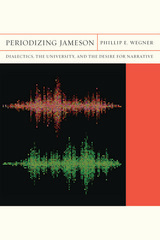 Periodizing Jameson: Dialectics, the University, and the Desire for Narrative
Phillip E. Wegner
Northwestern University Press, 2014 For a half century, the American intellectual Fredric Jameson has been a driving force in literary and cultural theory. In Periodizing Jameson, Phillip E. Wegner builds upon Jameson’s unique dialectical method to demonstrate the value of Jameson’s tools—periodization, the fourfold hermeneutic, and the Greimasian semiotic square, among others—and to develop virtuoso readings of Jameson’s own work and the history of the contemporary American university in which it unfolds. Wegner shows how Jameson’s work intervenes in particular social, cultural, and political situations, using his scholarship both to develop original explorations of nineteenth-century fiction, popular films, and other promiment theorists, and to examine the changing fortunes of theory itself. In this way, Periodizing Jameson casts new light on the potential of and challenges to humanist intellectual work in the present.
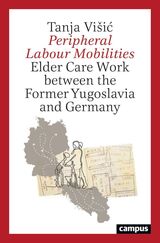 Peripheral Labour Mobilities
Tanja Višic
Campus Verlag, 2022 An inciteful ethnography of cross-border elder care workers.
The precarious situation in the successor states of Yugoslavia created a specific dynamic in the field of labor mobility. Still, little research has been done in this region on how women, who are older care workers from Serbia or Bosnia commute—often via illegal border crossings—to German households to look after the elderly. In Peripheral Labor Mobilities, Tanja Višic explores this gender-specific migration pattern in the first expansive ethnography of contemporary cross-border elder care in this region. She takes up questions about how the mobility and work practices of women are integrated into the socio-economic networks of the informal care work sector while also looking at worker confrontations with labor laws and border regimes. Illustrative case studies clearly detail culturally specific patterns of perception of care work, family relationships, and the mobility demanded by these labor arrangements.
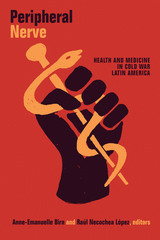 Peripheral Nerve: Health and Medicine in Cold War Latin America
Anne-Emanuelle Birn and Raúl Necochea López
Duke University Press, 2020 Buenos Aires psychoanalysts resisting imperialism. Brazilian parasitologists embracing communism as an antidote to rural misery. Nicaraguan revolutionaries welcoming Cuban health cooperation. Chilean public health reformers gauging domestic approaches against their Soviet and Western counterparts. As explored in Peripheral Nerve, these and accompanying accounts problematize existing understandings of how the Cold War unfolded in Latin America generally and in the health and medical realms more specifically. Bringing together scholars from across the Americas, this volume chronicles the experiences of Latin American physicians, nurses, medical scientists, and reformers who interacted with dominant U.S. and European players and sought alternative channels of health and medical solidarity with the Soviet Union and via South-South cooperation. Throughout, Peripheral Nerve highlights how Latin American health professionals accepted, rejected, and adapted foreign involvement; manipulated the rivalry between the United States and the USSR; and forged local variants that they projected internationally. In so doing, this collection reveals the multivalent nature of Latin American health politics, offering a significant contribution to Cold War history.
Contributors. Cheasty Anderson, Anne-Emanuelle Birn, Katherine E. Bliss, Gilberto Hochman, Jennifer L. Lambe, Nicole Pacino, Carlos Henrique Assunção Paiva, Jadwiga E. Pieper Mooney, Raúl Necochea López, Marco A. Ramos, Gabriela Soto Laveaga
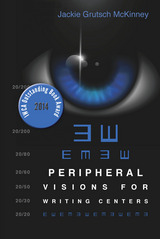 Peripheral Visions for Writing Centers
Jackie Grutsch McKinney
Utah State University Press, 2013 Peripheral Visions for Writing Centers aims to inspire a re-conception and re-envisioning of the boundaries of writing center work. Moving beyond the grand narrative of the writing center—that it is solely a comfortable, yet iconoclastic place where all students go to get one-to-one tutoring on their writing—McKinney shines light on other representations of writing center work.
McKinney argues that this grand narrative neglects the extent to which writing center work is theoretically and pedagogically complex, with ever-changing work and conditions, and results in a straitjacket for writing center scholars, practitioners, students, and outsiders alike. Peripheral Visions for Writing Centers makes the case for a broader narrative of writing center work that recognizes and theorizes the various spaces of writing center labor, allows for professionalization of administrators, and sees tutoring as just one way to perform writing center work.
McKinney explores possibilities that lie outside the grand narrative, allowing scholars and practitioners to open the field to a fuller, richer, and more realistic representation of their material labor and intellectual work.
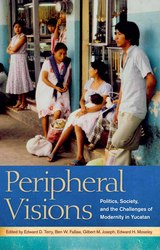 Peripheral Visions: Politics, Society, and the Challenges of Modernity in Yucatan
Edward D. Terry
University of Alabama Press, 2010 The essays in this collection illuminate both the processes of change and the negative reactions that they frequently elicited
Yucatan has been called “a world apart”—cut off from the rest of Mexico by geography and culture. Yet, despite its peripheral location, the region experienced substantial change in the decades after independence. As elsewhere in Mexico, apostles of modernization introduced policies intended to remold Yucatan in the image of the advanced nations of the day. Indeed, modernizing change began in the late colonial era and continued throughout the 19th century as traditional patterns of land tenure were altered and efforts were made to divest the Catholic Church of its wealth and political and intellectual influence. Some changes, however, produced fierce resistance from both elites and humbler Yucatecans and modernizers were frequently forced to retreat or at least reach accommodation with their foes.
Covering topics from the early 19th century to the late 20th century, the essays in this collection illuminate both the processes of change and the negative reactions that they frequently elicited. The diversity of disciplines covered by this volume—history, anthropology, sociology, economics—illuminates at least three overriding challenges for study of the peninsula today. One is politics after the decline of the Institutional Revolutionary Party: What are the important institutions, practices, and discourses of politics in a post-postrevolutionary era? A second trend is the scholarly demystification of the Maya: Anthropologists have shown the difficulties of applying monolithic terms like Maya in a society where ethnic relations are often situational and ethnic boundaries are fluid. And a third consideration: researchers are only now beginning to grapple with the region’s transition to a post-henequen economy based on tourism, migration, and the assembly plants known as maquiladoras. Challenges from agribusiness and industry will no doubt continue to affect the peninsula’s fragile Karst topography and unique environments. Contributors: Eric N. Baklanoff, Helen Delpar, Paul K. Eiss, Ben W. Fallaw, Gilbert M. Joseph, Marie Lapointe, Othón Baños Ramírez, Hernán Menéndez Rodríguez, Lynda S. Morrison, Terry Rugeley, Stephanie J. Smith
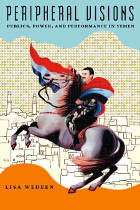 Peripheral Visions: Publics, Power, and Performance in Yemen
Lisa Wedeen
University of Chicago Press, 2008 The government of Yemen, unified since 1990, remains largely incapable of controlling violence or providing goods and services to its population, but the regime continues to endure despite its fragility and peripheral location in the global political and economic order. Revealing what holds Yemen together in such tenuous circumstances, Peripheral Visions shows how citizens form national attachments even in the absence of strong state institutions.
Lisa Wedeen, who spent a year and a half in Yemen observing and interviewing its residents, argues that national solidarity in such weak states tends to arise not from attachments to institutions but through both extraordinary events and the ordinary activities of everyday life. Yemenis, for example, regularly gather to chew qat, a leafy drug similar to caffeine, as they engage in wide-ranging and sometimes influential public discussions of even the most divisive political and social issues. These lively debates exemplify Wedeen’s contention that democratic, national, and pious solidarities work as ongoing, performative practices that enact and reproduce a citizenry’s shared points of reference. Ultimately, her skillful evocations of such practices shift attention away from a narrow focus on government institutions and electoral competition and toward the substantive experience of participatory politics.
Peripheries: A Journal of Word, Image, and Sound, No. 6
Sherah Bloor
Harvard University Press, 2024 Peripheries, No. 6, spans the senses with music, choreography, painting, sculpture, archival material, short stories, and poetry by Victoria Chang, Angie Estes, Aracelis Girmay, Joanna Klink, Alice Oswald, Rowan Ricardo Philips, Tracy K. Smith, and many more. The journal also includes a special folio, “Anti-Letters,” which comprises the “personal” writings—ephemera, letters, lists, notes, recordings, etc.—of poets such as Cody-Rose Clevidence, Jill Magi, and Jane Miller, among others. The issue also features a review by Tawanda Mulalu, creative nonfiction from Jackie Wang, a mixed media collaboration between Sharon Olds and Sam Messer, a David Grubbs composition with an accompaniment by Susan Howe, and an excerpt from a book-length poem by Geoffrey Nutter.
Peripheries: A Journal of Word, Image, and Sound, No. 7
Sherah Bloor
Harvard University Press Peripheries: A Journal of Word, Image, and Sound is a literary and arts journal based at Harvard Divinity School. Established in 2017, Peripheries publishes an annual collection of artistic work, including poetry, fiction, creative non-fiction, visual art that is, broadly understood, “peripheral” exploring the interstices between discourses, traditions, languages, forms, and genres. Each edition includes guest-edited folios on specialized themes.
Peripheries: A Journal of Word, Image, and Sound, No. 7
Sherah Bloor
Harvard University Press Peripheries: A Journal of Word, Image, and Sound is a literary and arts journal based at Harvard Divinity School. Established in 2017, Peripheries publishes an annual collection of artistic work, including poetry, fiction, creative non-fiction, visual art that is, broadly understood, “peripheral” exploring the interstices between discourses, traditions, languages, forms, and genres. Each edition includes guest-edited folios on specialized themes.
Peripheries: A Journal of Word, Image, and Sound, No. 8
Sherah Bloor
Harvard University Press Peripheries: A Journal of Word, Image, and Sound is a literary and arts journal based at Harvard Divinity School. Established in 2017, Peripheries publishes an annual collection of artistic work, including poetry, fiction, creative non-fiction, visual art that is, broadly understood, “peripheral” exploring the interstices between discourses, traditions, languages, forms, and genres. Each edition includes guest-edited folios on specialized themes.
Peripheries: A Journal of Word, Image, and Sound, No. 8
Sherah Bloor
Harvard University Press Peripheries: A Journal of Word, Image, and Sound is a literary and arts journal based at Harvard Divinity School. Established in 2017, Peripheries publishes an annual collection of artistic work, including poetry, fiction, creative non-fiction, visual art that is, broadly understood, “peripheral” exploring the interstices between discourses, traditions, languages, forms, and genres. Each edition includes guest-edited folios on specialized themes.
Peripheries: A Journal of Word, Image, and Sound, No. 8
Sherah Bloor
Harvard University Press Peripheries: A Journal of Word, Image, and Sound is a literary and arts journal based at Harvard Divinity School. Established in 2017, Peripheries publishes an annual collection of artistic work, including poetry, fiction, creative non-fiction, visual art that is, broadly understood, “peripheral” exploring the interstices between discourses, traditions, languages, forms, and genres. Each edition includes guest-edited folios on specialized themes.
Peripheries 8 includes a craft talk by Amanda Gunn, an interview with Jane Miller and Alice Oswald, and folios on parenthood, comics, mushā’iras, and law, among others.
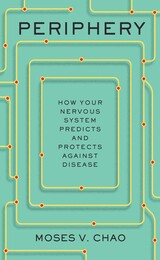 Periphery: How Your Nervous System Predicts and Protects against Disease
Moses V. Chao
Harvard University Press, 2023 A leading neuroscientist argues that the peripheral nervous system, long understood to play a key role in regulating basic bodily functions, also signals the onset of illness.
The central nervous system, consisting of the brain and the spinal cord, has long been considered the command center of the body. Yet outside the central nervous system, an elaborate network of nerve cells and fibers extends throughout our bodies, transmitting messages between the brain and other organs. The peripheral nervous system, as it’s known, regulates such vital functions as heart rate, digestion, and perspiration and enables us to experience the barrage of sounds, tastes, smells, and other sensory information that surrounds us. But beyond these crucial roles, the peripheral nervous system might do even more: it might warn us of diseases in our future.
As Moses Chao argues in Periphery, from Parkinson’s disease to autism to dementia, many neurological conditions emerge not in the brain but rather within the peripheral nervous system, in the dense network of nerves that wrap around the gastrointestinal tract. What’s more, dysfunctions of the peripheral nervous system can signal the onset of disease decades before symptoms like tremor or memory loss occur. Fortunately, unlike nerves in the brain and spinal cord, peripheral nerves can heal and regenerate in response to injury and aging. The therapeutic implications are remarkable. Chao shows how, with a better understanding of the peripheral nervous system, we could not only predict and treat neurological diseases long before their onset, but possibly prevent them altogether.
Full of new ideas and bold interpretations of the latest data, Periphery opens exciting avenues for medical research while deepening our understanding of a crucial yet underappreciated biological system.
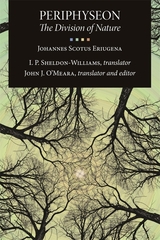 Periphyseon: The Division of Nature
Johannes Scotus Eriugena
Harvard University Press Called the “final achievement” of ancient philosophy, Periphyseon draws on knowledge of both the Greek and Latin Christian theological traditions, remarkable in the Carolingian world. It presents a Neoplatonic cosmology in the form of a catechetical dialogue between master and pupil covering the fourfold division of nature, in which all of reality is involved in a procession from and return to the One.
Periphyseon was written by Johannes Scotus Eriugena (ca. 810–ca. 877), an Irish monk, translator, and philosopher. By 851, he was at the West Frankish court of Charles the Bald, where he would remain for the rest of his life at the palace school. Although Eriugena had followers in his time and later among the mystics—the School of St. Victor, Eckhart, Tauler, Ruysbroeck, and the German mystics, and Nicholas of Cusa and his professed disciple Giordano Bruno—many in the West did not welcome his ideas, and his work was condemned by Honorius III in 1225.
Perishable
Stelios Mormoris
Tupelo Press, 2025 Poems exploring the relationship between joy and elegy.
In Perishable, Stelios Mormoris asks incisive questions about the nature of human connection: Where does memory live—in the body, in the mind, or elsewhere? What happens when the objects that surround us—a wedding ring, an empty purse, a harp—reveal necessary truths about ourselves and those we love? As the book unfolds, lush sensory details and unmatched lyricism are brought to bear on these lingering concerns in a style as neoclassical as it is contemporary. In poems that radiate with intelligence, Mormoris combines understated elegance with finely tuned music and evocative imagery.
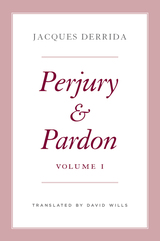 Perjury and Pardon, Volume I
Jacques Derrida
University of Chicago Press, 2022 An inquiry into the problematic of perjury, or lying, and forgiveness from one of the most influential philosophers of the twentieth century.
“One only ever asks forgiveness for what is unforgivable.” From this contradiction begins Perjury and Pardon, a two-year series of seminars given by Jacques Derrida at the École des hautes études en sciences sociales in Paris in the late 1990s. In these sessions, Derrida focuses on the philosophical, ethical, juridical, and political stakes of the concept of responsibility. His primary goal is to develop what he calls a “problematic of lying” by studying diverse forms of betrayal: infidelity, denial, false testimony, perjury, unkept promises, desecration, sacrilege, and blasphemy.
Although forgiveness is a notion inherited from multiple traditions, the process of forgiveness eludes those traditions, disturbing the categories of knowledge, sense, history, and law that attempt to circumscribe it. Derrida insists on the unconditionality of forgiveness and shows how its complex temporality destabilizes all ideas of presence and even of subjecthood. For Derrida, forgiveness cannot be reduced to repentance, punishment, retribution, or salvation, and it is inseparable from, and haunted by, the notion of perjury. Through close readings of Kant, Kierkegaard, Shakespeare, Plato, Jankélévitch, Baudelaire, and Kafka, as well as biblical texts, Derrida explores diverse notions of the “evil” or malignancy of lying while developing a complex account of forgiveness across different traditions.
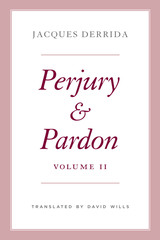 Perjury and Pardon, Volume II
Jacques Derrida
University of Chicago Press, 2023 An exploration of the political dimensions of forgiveness and repentance from Jacques Derrida.
Perjury and Pardon is a two-year seminar series given by Jacques Derrida at the École des hautes études en sciences sociales in Paris during the late 1990s. In these sessions, Derrida focuses on the philosophical, ethical, juridical, and political stakes of the concept of responsibility. His primary goal is to develop what he calls a “problematic of lying” by studying diverse forms of betrayal: infidelity, denial, false testimony, perjury, unkept promises, desecration, sacrilege, and blasphemy.
This volume covers the seminar’s second year when Derrida explores the political dimensions of forgiveness and repentance. Over eight sessions, he discusses Hegel, Augustine, Levinas, Arendt, and Benjamin as well as Bill Clinton’s impeachment and Nelson Mandela and Desmond Tutu’s testimonies before the Truth and Reconciliation Commission. The seminars conclude with an extended reading of Henri Thomas’s 1964 novel Le Parjure.
Permafrost Is an Archive: and Other Inheritances from the Alaska-Yukon Borderlands
Corinna Cook
West Virginia University Press, 2026 A lyrical essay collection exploring reconciliation, colonial legacies, and climate change in the Raven Biome of the Alaska-Yukon borderlands through research, personal reflection, and ekphrastic meditations on maps and artifacts; Corinna Cook wrestles with difficult pasts while facing an uncertain ecological future.
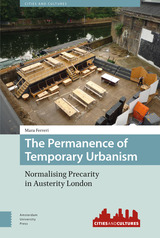 The Permanence of Temporary Urbanism: Normalising Precarity in Austerity London
Mara Ferreri
Amsterdam University Press, 2021 Temporary urbanism has become a distinctive feature of urban life after the 2008 global financial crisis. This book offers a critical exploration of its emergence and establishment as a seductive discourse and as an entangled field of practice encompassing architecture, visual and performative arts, urban regeneration policies and planning. Drawing on seven years of semi-ethnographic research, it explores the politics of temporariness from a situated analysis of neighbourhood transformation, media representations and wider political and cultural shifts in austerity London. Through a longitudinal engagement with projects and practitioners, the book tests the power of aesthetic and cultural interventions and highlights tensions between the promise of vacant space re-appropriation and its commodification. Against the normalisation of ephemerality, it presents a critique of the permanence of temporary urbanism as a glamorisation of the anticipatory politics of precarity which are transforming cities, subjectivities and imaginaries of urban action.
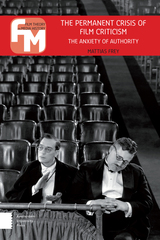 The Permanent Crisis of Film Criticism: The Anxiety of Authority
Mattias Frey
Amsterdam University Press, 2016 Film criticism is in crisis. Dwelling on the many film journalists made redundant at newspapers, magazines, and other 'old media' in past years, commentators have voiced existential questions about the purpose and worth of the profession in the age of WordPress blogospheres and proclaimed the 'death of the critic'. Bemoaning the current anarchy of internet amateurs and the lack of authoritative critics, many journalists and academics claim that in the digital age, cultural commentary has become dumbed down and fragmented into niche markets. Mattias Freu, arguing against these claims, examines the history of film critical discourse in France, Germany, the United Kingdom, and the United States . He demonstrates that since its origins, film criticism has always found itself in crisis: the need to show critical authority and the anxieties over challenges to that authority have been longstanding concerns.
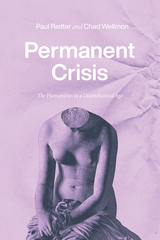 Permanent Crisis: The Humanities in a Disenchanted Age
Paul Reitter and Chad Wellmon
University of Chicago Press, 2021 Leads scholars and anyone who cares about the humanities into more effectively analyzing the fate of the humanities and digging into the very idea of the humanities as a way to find meaning and coherence in the world.
The humanities, considered by many as irrelevant for modern careers and hopelessly devoid of funding, seem to be in a perpetual state of crisis, at the mercy of modernizing and technological forces that are driving universities towards academic pursuits that pull in grant money and direct students to lucrative careers. But as Paul Reitter and Chad Wellmon show, this crisis isn’t new—in fact, it’s as old as the humanities themselves.
Today’s humanities scholars experience and react to basic pressures in ways that are strikingly similar to their nineteenth-century German counterparts. The humanities came into their own as scholars framed their work as a unique resource for resolving crises of meaning and value that threatened other cultural or social goods. The self-understanding of the modern humanities didn’t merely take shape in response to a perceived crisis; it also made crisis a core part of its project. Through this critical, historical perspective, Permanent Crisis can take scholars and anyone who cares about the humanities beyond the usual scolding, exhorting, and hand-wringing into clearer, more effective thinking about the fate of the humanities. Building on ideas from Max Weber and Friedrich Nietzsche to Helen Small and Danielle Allen, Reitter and Wellmon dig into the very idea of the humanities as a way to find meaning and coherence in the world. ,
 Permanent Revolution: The Reformation and the Illiberal Roots of Liberalism
James Simpson
Harvard University Press, 2019 How did the Reformation, which initially promoted decidedly illiberal positions, end up laying the groundwork for Western liberalism?
The English Reformation began as an evangelical movement driven by an unyielding belief in predestination, intolerance, stringent literalism, political quietism, and destructive iconoclasm. Yet by 1688, this illiberal early modern upheaval would deliver the foundations of liberalism: free will, liberty of conscience, religious toleration, readerly freedom, constitutionalism, and aesthetic liberty. How did a movement with such illiberal beginnings lay the groundwork for the Enlightenment? James Simpson provocatively rewrites the history of liberalism and uncovers its unexpected debt to evangelical religion.
Sixteenth-century Protestantism ushered in a culture of permanent revolution, ceaselessly repudiating its own prior forms. Its rejection of tradition was divisive, violent, and unsustainable. The proto-liberalism of the later seventeenth century emerged as a cultural package designed to stabilize the social chaos brought about by this evangelical revolution. A brilliant assault on many of our deepest assumptions, Permanent Revolution argues that far from being driven by a new strain of secular philosophy, the British Enlightenment is a story of transformation and reversal of the Protestant tradition from within. The gains of liberalism were the unintended results of the violent early Reformation.
Today those gains are increasingly under threat, in part because liberals do not understand their own history. They fail to grasp that liberalism is less the secular opponent of religious fundamentalism than its dissident younger sibling, uncertain how to confront its older evangelical competitor.
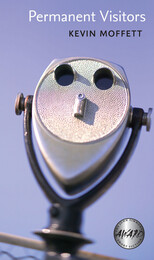 Permanent Visitors
Kevin Moffett
University of Iowa Press, 2006 Settled amid the seasonal amusements and condominium-lined beaches of the Florida coast, the characters who inhabit Kevin Moffett’s award-winning stories reach out of their lives to find that something unexpected and mysterious has replaced what used to be familiar.Some are stalled in the present, alone or lonely, bemused by mortality and disappointment. Some move toward the future heartened by what they learn from those around them--a tattoo artist, an invented medicine man, zoo animals, strangers, fellow outsiders. Deftly rendered, these stories abound with oddness and grace.In “Tattooizm,” included in The Best American Short Stories 2006, a young woman struggles with a promise that her boyfriend is determined to make her keep. In the Nelson Algren Award–winning “Space,” a reluctantly undertaken errand forces a young man to finally confront the death of his mother. And in “The Medicine Man,” hailed by the Times (U.K.) as “perfectly pitched and perfectly written,” a man recounts his manic attachment to his sister.Moffett’s closely observed stories are candid and complex, funny and moving. The world of Permanent Visitors is an idiosyncratic and generous one, its inhabitants searching for constancy in a place crowded with contradiction.
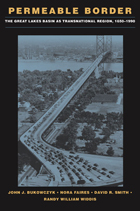 Permeable Border: The Great Lakes Basin As Transnational Region 1650-1990
John J Bukowczyk
University of Pittsburgh Press, 2005
From the colonial era of waterborne transport, through nineteenth-century changes in transportation and communication, to globalization, the history of the Great Lakes Basin has been shaped by the people, goods, and capital crossing and recrossing the U.S.-Canadian border.
During the past three centuries, the region has been buffeted by efforts to benefit from or defeat economic and political integration and by the politics of imposing, tightening, or relaxing the bisecting international border. Where tariff policy was used in the early national period to open the border for agricultural goods, growing protectionism in both countries transformed the border into a bulwark against foreign competition after the 1860s. In the twentieth century, labor migration followed by multinational corporations fundamentally altered the customary pairing of capital and nation to that of capital versus nation, challenging the concept of international borders as key factors in national development.
In tracing the economic development of the Great Lakes Basin as borderland and as transnational region, the authors of Permeable Border have provided a regional history that transcends national borders and makes vital connections between two national histories that are too often studied as wholly separate.
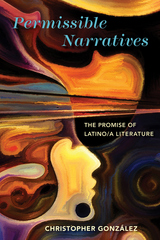 Permissible Narratives: The Promise of Latino/a Literature
Christopher González
Ohio State University Press, 2017 In his groundbreaking new study, Permissible Narratives: The Promise of Latino/a Literature, Christopher González examines the difficulties Latina/o writers face in writing beyond the narrow expectations of U.S. readership in the stories they tell. González argues that a constrained conception of the possibilities of storytelling by and about Latinos diminishes the development and progression of narrative form. Through an examination of Latina/o writers against the a priori mode of engaging with nonethnic literature in the United States, González explores the limitations and challenges Latina/o authors have confronted via the shaping power of their narratives to reach a sustainable audience.
Bringing together cultural critique, memory, narratology, cognition, and comprehension, González examines Latina/o authors—such as Oscar “Zeta” Acosta, Gloria Anzaldúa, Piri Thomas, Giannina Braschi, Gilbert Hernandez, Sandra Cisneros, and Junot Díaz—investigating how they successfully, and sometimes unsuccessfully, use the expansive canvas of narrative form to capture the imaginations of an open-minded readership. Permissible Narratives highlights both the inequitable accessibility of narrative devices and, crucially, the daring of Latina/o authors to nurture a readership to afford the same literary deference to them that is so often afforded to white, male, straight authors.
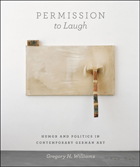 Permission to Laugh: Humor and Politics in Contemporary German Art
Gregory H. Williams
University of Chicago Press, 2012 Permission to Laugh explores the work of three generations of German artists who, beginning in the 1960s, turned to jokes and wit in an effort to confront complex questions regarding German politics and history. Gregory H. Williams highlights six of them—Martin Kippenberger, Isa Genzken, Rosemarie Trockel, Albert Oehlen, Georg Herold, and Werner Büttner—who came of age in the mid-1970s in the art scenes of West Berlin, Cologne, and Hamburg. Williams argues that each employed a distinctive brand of humor that responded to the period of political apathy that followed a decade of intense political ferment in West Germany. Situating these artists between the politically motivated art of 1960s West Germany and the trends that followed German unification in 1990, Williams describes how they no longer heeded calls for a brighter future, turning to jokes, anecdotes, and linguistic play in their work instead of overt political messages. He reveals that behind these practices is a profound loss of faith in the belief that art has the force to promulgate political change, and humor enabled artists to register this changed perspective while still supporting isolated instances of critical social commentary. Providing a much-needed examination of the development of postmodernism in Germany, Permission to Laugh will appeal to scholars, curators, and critics invested in modern and contemporary German art, as well as fans of these internationally renowned artists.
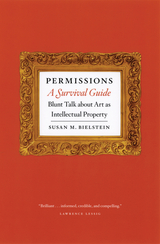 Permissions, A Survival Guide: Blunt Talk about Art as Intellectual Property
Susan M. Bielstein
University of Chicago Press, 2006 If a picture is worth a thousand words, then it's a good bet that at least half of those words relate to the picture's copyright status. Art historians, artists, and anyone who wants to use the images of others will find themselves awash in byzantine legal terms, constantly evolving copyright law, varying interpretations by museums and estates, and despair over the complexity of the whole situation. Here, on a white—not a high—horse, Susan Bielstein offers her decades of experience as an editor working with illustrated books. In doing so, she unsnarls the threads of permissions that have ensnared scholars, critics, and artists for years.
Organized as a series of “takes” that range from short sidebars to extended discussions, Permissions, A Survival Guide explores intellectual property law as it pertains to visual imagery. How can you determine whether an artwork is copyrighted? How do you procure a high-quality reproduction of an image? What does “fair use” really mean? Is it ever legitimate to use the work of an artist without permission? Bielstein discusses the many uncertainties that plague writers who work with images in this highly visual age, and she does so based on her years navigating precisely these issues. As an editor who has hired a photographer to shoot an incredibly obscure work in the Italian mountains (a plan that backfired hilariously), who has tried to reason with artists' estates in languages she doesn't speak, and who has spent her time in the archival trenches, she offers a snappy and humane guide to this difficult terrain.
Filled with anecdotes, asides, and real courage, Permissions, A Survival Guide is a unique handbook that anyone working in the visual arts will find invaluable, if not indispensable.
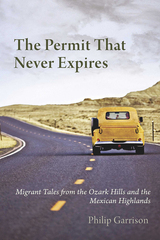 The Permit that Never Expires: Migrant Tales from the Ozark Hills and the Mexican Highlands
By Philip Garrison
University of Arizona Press, 2010 Philip Garrison keeps his eyes and ears open. And he also keeps an open mind. It helps that he’s bilingual, because a lot of his neighbors these days speak Spanish and he likes to know what’s on their minds. Like his epileptic friend Pera, who asks him to write a note in English to explain to her supervisor that she probably shouldn’t be cooking on a grill in case she has a seizure and falls into the flames. When Garrison asks her if she has a work permit, she replies,“Bueno. El que nunca vence.” The kind that never expires. That’s the sort of response he doesn’t forget.
There is a river, Garrison writes, that runs from Oaxaca to British Columbia. El flujo migratorio, he calls it. The migratory flow. But it isn’t a conventional sort of river. “It is made of neither rock nor water nor wind but only of motion, of momentum. And yet . . . it is the most compelling feature in the entire U.S. West,” he claims. Garrison has his feet planted firmly in the middle of this river of humanity, wondering why America is trying to build a wall along an actual river, the Rio Grande, to keep us separated from the mexicanos. All borders, he writes, exist mostly in the imagination—a point he proves decisively in this delightful book.
Garrison is an award-winning writer and this book shows why. Warm, witty, self-deprecating, and charming (the list could go on), this collection illuminates the lives of these migrants, whether at the local food bank in Ellensburg, Washington, in the streets of Michoacán, or everywhere in between.
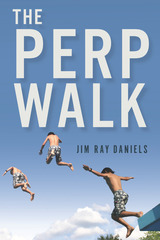 The Perp Walk
Jim Ray Daniels
Michigan State University Press, 2019 In The Perp Walk, his latest collection of linked stories, Daniels maps out the emotional capitals and potholes of coming of age in a blue-collar town in the Great Lakes State, though it could be any state where people work hard, play hard, and aren’t paid nearly enough for their efforts. Alternating flash fiction pieces with longer narratives, Daniels captures both the shooting stars and the constellations that build into earned insights and honest reflections. Sometimes we need both the long version of the short version and the short version of the long version, he suggests. Daniels invites his readers to settle on some truth in between the versions. Humor and heartbreak. Coming to terms, coming of age, or just plain aging. U-Haul trucks full of bad behavior and messy goodbyes. In Daniels’s work, the check is always in the mail but somehow never arrives, and honor is more than a certificate—it’s something we strive for, even while doing our various perp walks through life. Compromises are made, as they must be. Sometimes we get what we want for just a second or two, but for these characters, that has to be enough happiness to live on.
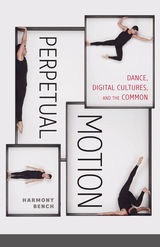 Perpetual Motion: Dance, Digital Cultures, and the Common
Harmony Bench
University of Minnesota Press, 2020 A new exploration of how digital media assert the relevance of dance in a wired world
How has the Internet changed dance? Dance performances can now be seen anywhere, can be looped endlessly at user whim, and can integrate crowds in unprecedented ways. Dance practices are evolving to explore these new possibilities. In Perpetual Motion, Harmony Bench argues that dance is a vital part of civil society and a means for building participation and community. She looks at how, after 9/11, it became a crucial way of recuperating the common character of public spaces. She explores how crowdsourcing dance contributes to the project of performing a common world, as well as the social relationships forged when we look at dance as a gift in the era of globalization. Throughout, she asks how dance brings people together in digital spaces and what dance’s digital travels might mean for how we experience and express community. From original research on dance today to political economies of digital media to the philosophy of dance, Perpetual Motion provides an ambitious, invigorating look at a commonly shared practice.
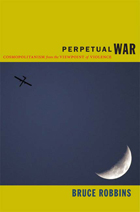 Perpetual War: Cosmopolitanism from the Viewpoint of Violence
Bruce Robbins
Duke University Press, 2012 For two decades Bruce Robbins has been a theorist of and participant in the movement for a "new cosmopolitanism," an appreciation of the varieties of multiple belonging that emerge as peoples and cultures interact. In Perpetual War he takes stock of this movement, rethinking his own commitment and reflecting on the responsibilities of American intellectuals today. In this era of seemingly endless U.S. warfare, Robbins contends that the declining economic and political hegemony of the United States will tempt it into blaming other nations for its problems and lashing out against them. Under these conditions, cosmopolitanism in the traditional sense—primary loyalty to the good of humanity as a whole, even if it conflicts with loyalty to the interests of one's own nation—becomes a necessary resource in the struggle against military aggression. To what extent does the "new" cosmopolitanism also include or support this "old" cosmopolitanism? In an attempt to answer this question, Robbins engages with such thinkers as Noam Chomsky, Edward Said, Anthony Appiah, Immanuel Wallerstein, Louis Menand, W. G. Sebald, and Slavoj Zizek. The paradoxes of detachment and belonging they embody, he argues, can help define the tasks of American intellectuals in an era when the first duty of the cosmopolitan is to resist the military aggression perpetrated by his or her own country.
The Perpetuation of Site-Specific Installation Artworks in Museums: Staging Contemporary Art
Tatja Scholte
Amsterdam University Press, 2022 Site-specific installations are created for specific locations and are usually intended as temporary artworks. The Perpetuation of Site-Specific Installation Artworks in Museums: Staging Contemporary Art shows that these artworks consist of more than a singular manifestation and that their lifespan is often extended. In this book, Tatja Scholte offers an in-depth account of the artistic production of the last forty years. With a wealth of case studies the author illuminates the diversity of site-specific art in both form and content, as well as in the conservation strategies applied. A conceptual framework is provided for scholars and museum professionals to better understand how site-specific installations gain new meanings during successive stages of their biographies and may become agents for change in professional routines.
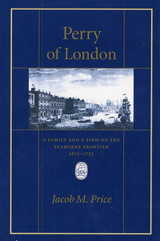 Perry of London: A Family and a Firm on the Seaborne Frontier, 1615–1753
Jacob M. Price
Harvard University Press, 1992 The Establishment of English colonies in North America and the West Indies in the seventeenth century opened new opportunities for trade. Conspicuous among the families who used these opportunities to gain mercantile and social importance was the Perry family of Devon, who created Perry and Lane, by the end of the century the most important London firm trading to the Chesapeake and other parts of North America.
Jacob Price traces the family from Devon to Spain, Ireland, Scotland, the Chesapeake, New England, and London. He describes their relationships with Chesapeake society, from the Byrds and Carters to humble planters. In London, the firm’s patronage gave the family high standing among fellow businessmen, a position the founder’s grandson utilized to become a member of Parliament and Lord Mayor of London. In the end, the grandson’s political success as an antiministerialist brought the family the enmity of the prime minister, Sir Robert Walpole, and contributed to the downfall of their firm.
The Perrys’ story reveals the interrelatedness of social, commercial, and political history. It offers an important contribution to our understanding of the nature of the Chesapeake trade and the forces shaping the success and failure of English mercantile enterprise in the seventeenth and eighteenth centuries.
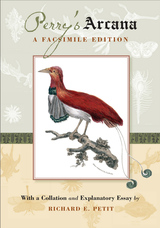 Perry's Arcana: A Facsimile Edition
Richard E. Petit
Temple University Press, 2009 From 1810 to 1811, the English stonemason and amateur naturalist George Perry published a lavishly illustrated magazine on natural history. The Arcana or Museum of Nature ran to 22 monthly parts, with 84 extraordinary hand-colored plates and over 300 text pages describing mammals, birds, reptiles, fish, mollusks, echinoderms, insects, trilobites and plants, alongside travelogues from far-off lands. It presented the first published illustration of the koala and many new genera and species, but astonishingly was then largely forgotten for nearly two hundred years. Perry’s work was deliberately ignored by his contemporaries in England, as he was a supporter of Lamarck rather than of Linnaeus, and the Arcana’s rarity—only thirteen complete copies are known to have survived—has helped maintain its shroud of mystery.
Now at last this neglected gem has been revived for scientists, students, and aficionados of natural history. New scholarship is combined with modern digital reproduction techniques to do full justice to the beautiful plates. An up-to-date account of all the species is given, along with a full collation and extensive notes, by the eminent natural historian Richard E. Petit.
The Arcana is technically interesting too, as its glowing plates were printed with variously colored inks to suppress their outlines. Its appeal will extend not only to academic libraries and scholars specializing in various branches of natural history and the history of science, but also to collectors of beautiful natural history books and enthusiasts of Regency Britain.
 Persecution and Rescue: The Politics of the “Final Solution” in France, 1940-1944
Wolfgang Seibel
University of Michigan Press, 2016 In 1942, two years after invading France, the Germans implemented their policy of exterminating the Jews. In contrast to Jews in many parts of German-occupied Europe, however, the majority of Jews in France survived, thanks to opposition to the Nazi extermination policy from Church dignitaries and the moral indignation of the average Frenchmen. Seeking to maintain popular support, the Vichy Regime bargained with the Germans over the substance and extent of its collaboration, which the Germans needed in order to hold France. Drawing on German and French sources, Wolfgang Seibel traces the twisted process of political decision-making that shaped the fate of the Jews in German-occupied France during World War II. By analyzing the German-French negotiations, he reveals the underlying logic as well as the actual course of the bargaining process as both the Vichy Regime and the Germans sought a stable relationship. Yet that relationship was continually reshaped by the progress of the war, Germany’s deteriorating prospects, France’s economic and geopolitical position, and the Vichy government’s quest for domestic political support. The Jews’ suffering intensified when the Germans had the upper hand; but when the French felt empowered, the Vichy Regime stopped collaborating in the completion of the “final solution.” Persecution and Rescue: The Politics of the “Final Solution” in France, 1940–1944 demonstrates the ways in which political circumstances can mitigate—or foster—mass crime.
Persecution and the Art of Writing
Leo Strauss
University of Chicago Press, 1988 The essays collected in Persecution and the Art of Writing all deal with one problem—the relation between philosophy and politics. Here, Strauss sets forth the thesis that many philosophers, especially political philosophers, have reacted to the threat of persecution by disguising their most controversial and heterodox ideas.
 The Persecution of the Jews in the Netherlands, 1940-1945
Edited and with an Introduction by Wichert ten Have
Amsterdam University Press, 2012 This important study surveys recent Dutch research into persecution of the Jews in the Netherlands during World War II, addressing the political, public, and private responses to National Socialism and the aftermath of the Final Solution. The authors discuss a wide range of issues, including the role of the Dutch state apparatus in the success of the persecution; popular perception of the Jews in Dutch culture of the time; a comparison of the treatment of Jews in the Netherlands, Belgium, and France; and the regime in charge of the Dutch transit to concentration camps. With contributions from eminent historians of the Holocaust, this book draws on personal accounts and diaries to analyze the response among the Dutch population to the escalating persecution of the Dutch Jewish community, effectively contrasting the perspectives of the victims, the perpetrators, and the bystanders.
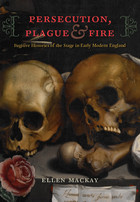 Persecution, Plague, and Fire: Fugitive Histories of the Stage in Early Modern England
Ellen MacKay
University of Chicago Press, 2011 The theater of early modern England was a disastrous affair. The scant record of its performance demonstrates as much, for what we tend to remember today of the Shakespearean stage and its history are landmark moments of dissolution: the burning down of the Globe, the forced closure of playhouses during outbreaks of the plague, and the abolition of the theater by its Cromwellian opponents. Persecution, Plague, and Fire is a study of these catastrophes and the theory of performance they convey. Ellen MacKay argues that the various disasters that afflicted the English theater during its golden age were no accident but the promised end of a practice built on disappearance and erasure—a kind of fatal performance that left nothing behind but its self-effacing poetics. Bringing together dramatic theory, performance studies, and theatrical, religious, and cultural history, MacKay reveals the period’s radical take on the history and the future of the stage to show just how critical the relation was between early modern English theater and its public.
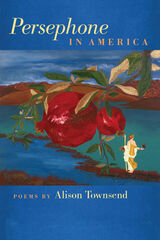 Persephone in America
Alison Townsend
Southern Illinois University Press, 2009 In Persephone in America, Alison Townsend deftly weaves autobiography with myth in this reinvention of the tale of Demeter and Persephone as seen from the modern woman’s perspective. Fraught with emotional honesty, this captivating collection of lyrical and narrative poems chronicles the struggles of the figurative Persephone in three parts—the abduction, descent to the underworld, and return. Townsend turns a shrewd eye to her own experiences, as well as to the lives of other women, to offer an unflinching yet deeply compassionate exploration of such themes as girlhood and the vulnerability of the motherless; the demons of depression, addiction, and abuse; as well as passion, aging, and celebration of the natural world. Although the poems traverse dark emotional territory at times, the picture that emerges ultimately is one of revelation and wisdom. Persephone in America is above all a journey of the soul, following the narrator as she explores what it means to be a woman in America, at times descending into darkness, only to emerge into redemption and realize “time’s sweet and invincible secret—that everything repeats—and we watch it.” Townsend’s candid portrait of female loss and discovery seeks to illuminate the truths inherent in myth, and the awakenings that hide in our darkest moments. Persephone, Pretending (Madison, Wisconsin) When the news says that the girl who had been missing almost four days, only to be found in a marshy area at the edge of our medium-sized city, was faking it all along, I wondered what made her do it. I'd seen her face—bright smile, dark eyes— on a flier masking-taped to a pillar at the airport the week before, felt the involuntary frisson of the curious, then only fear at the thought of a girl abducted in this place once voted "America's most livable city." She must have wanted something she couldn't name, that good girl with good grades who looks like so many girls in my own classes, but who keeps changing her story. It happened here; no, it happened there; no, I really just wanted to be alone. Then she turns her face away, tired of telling her tale, not sure what to make up next or where invention will take her. “Fictitious victimization disorder,” Time magazine claims, but I wonder what else, imagining her in the marsh, cold, unrepentant, powerless, her mind gone muddy with lack of sleep, no way out of this lie she almost believes, or the lies ahead, nothing but memory of the rope, duct tape, cough medicine, and knife she bought at the PDQ with her own cash, wanting to be taken by someone so badly, she takes us, she does it to herself.
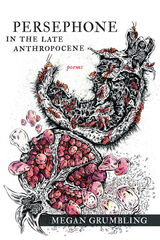 Persephone in the Late Anthropocene: Poems
Megan Grumbling
Acre Books, 2020 Persephone in the Late Anthropocene vaults an ancient myth into the age of climate change. In this poetry collection, the goddess of spring now comes and goes erratically, drinks too much, and takes a human lover in our warming, unraveling world. Meanwhile, Persephone’s mother searches for her troubled daughter, and humanity is first seduced by the unseasonable abundance, then devastated by the fallout, and finally roused to act.
This ecopoetic collection interweaves the voices of Persephone, Demeter, and a human chorus with a range of texts, including speculative cryptostudies that shed light on the culture of the “Late Anthropocene.” These voices speak of decadence and blame, green crabs and neonicotinoids, mysteries and effigies. They reckon with extreme weather, industrialized plenty, and their own roles in ecological collapse.
Tonally, the poems of this book range between the sublime and the profane; formally, from lyric verse and modern magical-realist prose poems to New Farmer’s Almanac riddles and pop-anthropology texts. At the heart of this varied and inventive collection is story itself, as Demeter deconstructs “whodunits,” as the chorus grasps that mythmaking is an act of “throwing their voices,” and as their very language mirrors the downward spiral of destruction. Together, the collected pieces of Persephone in the Late Anthropocene form a narrative prism, exploring both environmental crisis and the question of how we tell it.
Persephone's Girdle: Narratives of Rape in Seventeenth-Century Spanish Literature
Marcia L. Welles
Vanderbilt University Press, 2000 A bold, gender-inflected reinterpretation of secular Spanish texts of the early modern period that focuses on sexual violence as expressive of cultural and political issues.
Marcia Welles applies her extensive knowledge of Spanish Golden Age literature and her insightful grasp of current literary theory to synthesize a wide range of material into a uniquely engaging and refreshing interpretation of well-known texts. While the subject of rape and violence has been studied in other European literatures, Persephone's Girdle is the first to do so in the field of early modern Spanish literature.
 Persevered: A Maternal Mental Health Memoir
Kara Zivin
Ohio University Press If you think you know what mental health during and after pregnancy looks like, Persevered: A Maternal Mental Health Memoir will make you reconsider. Dr. Kara Zivin offers a rare, unfiltered look at what happened when a respected mental health researcher faced her own grave battle with depression and anxiety during and after pregnancy. This book is a raw personal account of surviving the darkest moments of new motherhood while juggling high expectations at home and at work. Zivin takes the reader on an intimate and eye-opening journey that weaves together her perinatal medical records, journal entries, research, and imperfect memories. The story unfolds across hospital rooms, the author’s home, and the university where she works, highlighting the complexity of holding on to one’s identity when everything feels uncertain. Zivin writes with striking honesty about the confusion, guilt, and isolation that so many mothers experience alone but rarely admit to others. Her willingness to lay bare her struggles and her gradual journey toward hope and recovery makes every page feel authentic and deeply relatable. Persevered moves beyond one woman’s survival, breaking the silence that still surrounds maternal mental health. Zivin’s story reminds us that reaching out, sharing our experiences, and demanding better support can make a difference, not just for mothers but for families and communities. This memoir is for anyone who has ever felt overwhelmed, anyone who has supported a loved one through challenging times, or anyone who believes that honest storytelling can spark real change.
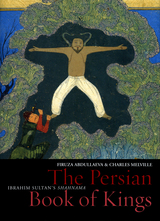 The Persian Book of Kings: Ibrahim Sultan's "Shahnama"
Firuza Abdullaeva and Charles Melville
Bodleian Library Publishing, 2008
India has the Mahabharata, Greece has Homer’s epic cycle, and the national history of Iran is chronicled in Firdausi’s epic poem The Book of Kings, or Shahnama. This lavishly illustrated study explores the intricate complexity of this epic as it is beautifully rendered in a rare fifteenth-century reproduction.
The Shahnama positions Iran at the heart of human civilization, and its sprawling and compelling narrative stretches from the beginning of time to the seventh-century takeover of the Persian Empire by Muslim Arabs. Ibrahim Sultan, governor of Shiraz in southern Iran from 1415 to 1435, commissioned an edition of the Shahnama that contained a lavish assortment of intricate original paintings. This version is now in the collection of the Bodleian Library, and The Persian Book of Kings explores this rare text in extensive detail.
The authors investigate the life of the poet Firdausi, unpack the literary context of the poem and its illuminations, and examine the royal court of Ibrahim Sultan for whom the manuscript was commissioned. The richly colored miniatures and illuminations spread through the text are given full exploration in this study, with examinations of both the artists’ techniques that influenced generations of illustrators and the artworks’ meanings. The book also features a helpful glossary of Persian terms and a list of the numerous characters that appear in the epic.
A gorgeously produced study of one of the great literary works of human history, The Persian Book of Kings offers a fascinating look at the myths and legends of an ancient culture.
Persian Bookbindings of the Fifteenth Century: A Contribution from the Research Seminary in Islamic Art
Mehmet Aga-Oglu
University of Michigan Press, 1935 Because of the lack of systematically treated material from the period preceding the fifteenth century, the publication of an exhaustive study on the historical and artistic development of Persian bookbinding is almost impossible at the present time. It is not the writer's purpose to present here a historical or stylistic study of the subject, but rather to add to already published material additional specimens of artistic value, which may extend the hitherto scanty knowledge concerning the art of Persian bookbinding of the century in question. This book appears as a contribution from the University of Michigan Research Seminary in Islamic Art, which owes its existence to the interest of Dr. Alexander G. Ruthven, President of the University, and Professor John G. Winter, Director of the Division of Fine Arts.
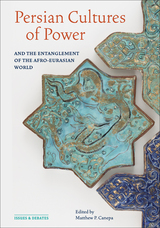 Persian Cultures of Power and the Entanglement of the Afro-Eurasian World
Matthew P. Canepa
J. Paul Getty Trust, The, 2024 A cutting-edge analysis of 2,500 years of Persian visual, architectural, and material cultures of power and their role in connecting the world.
With the rise of the Achaemenid Empire (550–330 BCE), Persian institutions of kingship became the model for legitimacy, authority, and prestige across three continents. Despite enormous upheavals, Iranian visual and political cultures connected an ever-wider swath of Afro-Eurasia over the next two millennia, exerting influence at key historical junctures. This book provides the first critical exploration of the role Persian cultures played in articulating the myriad ways power was expressed across Afro-Eurasia between the sixth century BCE and the nineteenth century CE.
Exploring topics such as royal cosmologies, fashion, banqueting, manuscript cultures, sacred landscapes, and inscriptions, the volume’s essays analyze the intellectual and political exchanges of art, architecture, ritual, and luxury material within and beyond the Persian world. They show how Perso-Iranian cultures offered neighbors and competitors raw material with which to formulate their own imperial aspirations. Unique among studies of Persia and Iran, this volume explores issues of change, renovation, and interconnectivity in these cultures over the longue durée.
Persian Diary, 1939-1941
Walter N. Koelz
University of Michigan Press, 1983 Naturalist and zoologist Walter Koelz traveled to Iran on a project of plant exploration (sponsored by the U.S. Department of Agriculture) from late 1939 to early 1941. With him were three companions: Rup Chand, Wangyel, and Rinchen Gialtsen. Together they brought back 3000 seed samples, 4000 herbarium specimens, and a collection of bird skins. Koelz’s diary of that journey is presented in this volume, with an introduction by Henry T. Wright. Includes dozens of black and white photos.
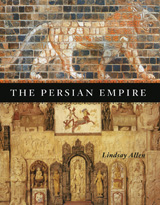 The Persian Empire
Lindsay Allen
University of Chicago Press, 2005 Beginning in the sixth century BCE, Persian kings ruled a vast, culturally diverse empire that stretched from northern Libya to central Asia. The regime and its rich multicultural traditions prospered for 250 years until its invasion, and eventual defeat, by Alexander the Great's army in 331 BCE. Yet until the British Museum's exhibition in the summer of 2005, the Persian perspective of this landmark event in world history will have been largely neglected. In one of the few accounts available, The Persian Empire provides a comprehensive and accessible portrayal of one of the world's first land-based dynastic kingdom.
In her cultural and political history of the development of this power, Lindsay Allen-whose posts in the Ancient Near East departments of the British Museum and the Metropolitan Museum of Art make her one of the leading authorities on Persia-surveys written sources, art objects, warfare, politics, archaeological sites, and daily life during Persian rule. She traces the evolution of the monarchy, showing how it fostered unprecedented international communication and cultural exchange, and describes how the Persian expedition into Greece in the early fifth century BCE became a defining moment that established a European identity apart from an Asian one. Throughout, lavish illustrations bring to life the traditions of this ancient Middle Eastern civilization and finally place Alexander's invasion within a Persian context. As the subject experiences renewed interest, The Persian Empire promises to be the definitive work on one of the most powerful dynasties in ancient history.
Persian Gardens and Garden Pavilions
Donald Newton Wilber
Harvard University Press, 1979 This study traces the history of gardens in Iran from the earliest remains of the Timurid period to those of the Qajar dynasty of the nineteenth century. Illustrations from early travel books and paintings show the original conditions of now ruined gardens.
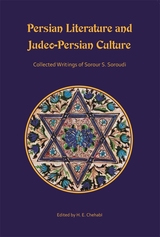 Persian Literature and Judeo-Persian Culture: Collected Writings of Sorour S. Soroudi
H. E. Chehabi
Harvard University Press This volume presents several articles and other writings of Sorour S. Soroudi (1938–2002), who taught in the Department of Iranian Studies at the Hebrew University for three decades. Soroudi’s research was concentrated in three main areas, all of which are well represented in this collection. First, Soroudi was an early specialist in modern Persian poetry, particularly that of the constitutional era; her studies and translations did much to bring this poetry to the attention of critics and scholars. Second, on the basis of extensive fieldwork as well as literary study, Soroudi contributed greatly to the study of Judeo-Persian literature and folk culture. Third, Soroudi explored the history and culture of Iranian Jewry, which she situated in the larger context of Iranian history. This volume, meticulously and sensitively edited by Houchang E. Chehabi, brings together many of Dr. Soroudi’s published articles in these two areas. Included in this book is a previously unpublished piece as well as an article that appears here in English for the first time.
 Persian Manuscripts & Paintings from the Berenson Collection
Yoltar-Yıldırım, Ayşin
Harvard University Press Persian Manuscripts & Paintings from the Berenson Collection presents an in-depth analysis of the little-known Persian manuscripts and paintings collected by the world-renowned art historian, art critic, and connoisseur Bernard Berenson (1865–1959). It focuses on three manuscripts and four detached folios (containing over fifty paintings) from the fourteenth to the seventeenth century produced in Iran and Central Asia (with a later addition in Mughal India).
Fourteen essays are written by an international team of specialists in art history, Persian literature, statistics, conservation, and conservation science. The first two essays introduce Berenson’s collecting of these art works as an individual and as a trend among other collectors. The rest of the essays explain individual works of art. The Timurid Rasaʾil and the Safavid manuscripts Shahnama of Firdawsi and Farhad va Shirin of Vahshi are examined in groups of essays ranging from art historical to literary, statistical, and codicological analysis. The detached folios studied as single essays originate from the famous Great Mongol Shahnama; the 1436 Timurid Zafarnama of Sharaf al-Din ʿAli Yazdi; a Turkman Shahnama; and the dispersed Imperial Mughal Album also known as the Minto, Wantage, and Kevorkian albums. The appendix refers to the materials and techniques of the paintings in the volume.
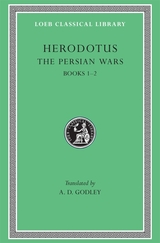 The Persian Wars, Volume I: Books 1–2
Herodotus
Harvard University Press, 1981 The “Father of History.”
Herodotus the great Greek historian was born about 484 BC, at Halicarnassus in Caria, Asia Minor, when it was subject to the Persians. He traveled widely in most of Asia Minor, Egypt (as far as Aswan), North Africa, Syria, the country north of the Black Sea, and many parts of the Aegean Sea and the mainland of Greece. He lived, it seems, for some time in Athens, and in 443 went with other colonists to the new city Thurii (in South Italy), where he died about 430. He was “the prose correlative of the bard, a narrator of the deeds of real men, and a describer of foreign places” (Murray).
Herodotus’ famous history of warfare between the Greeks and the Persians has an epic dignity which enhances his delightful style. It includes the rise of the Persian power and an account of the Persian empire; a description and history of Egypt; and a long digression on the geography and customs of Scythia. Even in the later books on the attacks of the Persians against Greece there are digressions. All is most entertaining and produces a grand unity. After personal inquiry and study of hearsay and other evidence, Herodotus gives us a not uncritical estimate of the best that he could find.
The Loeb Classical Library edition of Herodotus is in four volumes.
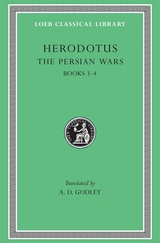 The Persian Wars, Volume II: Books 3–4
Herodotus
Harvard University Press, 1981 The “Father of History.”
Herodotus the great Greek historian was born about 484 BC, at Halicarnassus in Caria, Asia Minor, when it was subject to the Persians. He traveled widely in most of Asia Minor, Egypt (as far as Aswan), North Africa, Syria, the country north of the Black Sea, and many parts of the Aegean Sea and the mainland of Greece. He lived, it seems, for some time in Athens, and in 443 went with other colonists to the new city Thurii (in South Italy), where he died about 430. He was “the prose correlative of the bard, a narrator of the deeds of real men, and a describer of foreign places” (Murray).
Herodotus’ famous history of warfare between the Greeks and the Persians has an epic dignity which enhances his delightful style. It includes the rise of the Persian power and an account of the Persian empire; a description and history of Egypt; and a long digression on the geography and customs of Scythia. Even in the later books on the attacks of the Persians against Greece there are digressions. All is most entertaining and produces a grand unity. After personal inquiry and study of hearsay and other evidence, Herodotus gives us a not uncritical estimate of the best that he could find.
The Loeb Classical Library edition of Herodotus is in four volumes.
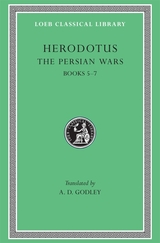 The Persian Wars, Volume III: Books 5–7
Herodotus
Harvard University Press, 1981 The “Father of History.”
Herodotus the great Greek historian was born about 484 BC, at Halicarnassus in Caria, Asia Minor, when it was subject to the Persians. He traveled widely in most of Asia Minor, Egypt (as far as Aswan), North Africa, Syria, the country north of the Black Sea, and many parts of the Aegean Sea and the mainland of Greece. He lived, it seems, for some time in Athens, and in 443 went with other colonists to the new city Thurii (in South Italy), where he died about 430. He was “the prose correlative of the bard, a narrator of the deeds of real men, and a describer of foreign places” (Murray).
Herodotus’ famous history of warfare between the Greeks and the Persians has an epic dignity which enhances his delightful style. It includes the rise of the Persian power and an account of the Persian empire; a description and history of Egypt; and a long digression on the geography and customs of Scythia. Even in the later books on the attacks of the Persians against Greece there are digressions. All is most entertaining and produces a grand unity. After personal inquiry and study of hearsay and other evidence, Herodotus gives us a not uncritical estimate of the best that he could find.
The Loeb Classical Library edition of Herodotus is in four volumes.
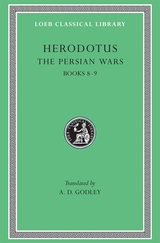 The Persian Wars, Volume IV: Books 8–9
Herodotus
Harvard University Press, 1981 The “Father of History.”
Herodotus the great Greek historian was born about 484 BC, at Halicarnassus in Caria, Asia Minor, when it was subject to the Persians. He traveled widely in most of Asia Minor, Egypt (as far as Aswan), North Africa, Syria, the country north of the Black Sea, and many parts of the Aegean Sea and the mainland of Greece. He lived, it seems, for some time in Athens, and in 443 went with other colonists to the new city Thurii (in South Italy), where he died about 430. He was “the prose correlative of the bard, a narrator of the deeds of real men, and a describer of foreign places” (Murray).
Herodotus’ famous history of warfare between the Greeks and the Persians has an epic dignity which enhances his delightful style. It includes the rise of the Persian power and an account of the Persian empire; a description and history of Egypt; and a long digression on the geography and customs of Scythia. Even in the later books on the attacks of the Persians against Greece there are digressions. All is most entertaining and produces a grand unity. After personal inquiry and study of hearsay and other evidence, Herodotus gives us a not uncritical estimate of the best that he could find.
The Loeb Classical Library edition of Herodotus is in four volumes.
The Persian Whitman: Beyond a Literary Reception
Behnam M. Fomeshi
Leiden University Press, 2019 Walt Whitman, a world poet and the father of American free verse, has been read by diverse audiences from around the world. Literary and cultural scholars have studied Whitman’s interaction with social, political and literary movements of different countries. Despite his continuing presence in Iran, Whitman’s reception in this country has remained unexplored. Additionally, Iranian reception of Western literature is a field still in its infancy and under-researched, particularly due to contemporary political circumstances. The Persian Whitman examines Whitman’s heretofore unexplored reception in Iran. It is primarily involved with the “Persian Whitman,” a new phenomenon born in diachronic and synchronic dialogue between the Persian culture and an American poet.
 Persians. Seven against Thebes. Suppliants. Prometheus Bound
Aeschylus
Harvard University Press, 2008 Four unconnected but unforgettable plays from ancient Athens’ first great tragedian.
Aeschylus (ca. 525–456 BC), the dramatist who made Athenian tragedy one of the world’s great art forms, witnessed the establishment of democracy at Athens, fought against the Persians at Marathon and probably also at Salamis, and had one of his productions sponsored by the young Pericles. He was twice invited to visit Sicily, and it was there that he died. At Athens he competed for the tragic prize at the City Dionysia about nineteen times between circa 499 and 458, and won it on thirteen occasions; in his later years he was probably victorious almost every time he put on a production, though Sophocles beat him at least once.
Of his total of about eighty plays, seven survive complete. The first volume of this new Loeb Classical Library edition contains fresh texts and translations by Alan H. Sommerstein of Persians (472), on the recent war, the only surviving Greek historical drama; Seven against Thebes (467), the third play of a trilogy, on the conflict between Oedipus’ sons which ends when they kill each other; Suppliants, the first or second play of a trilogy, on the successful appeal by the daughters of Danaus to the king and people of Argos for protection against a forced marriage to their cousins (whom they will later murder, all but one); and Prometheus Bound (of disputed authenticity), on the terrible punishment of Prometheus for giving fire to humans in defiance of Zeus (with whom he will later be reconciled after preventing his overthrow). The second volume contains the complete Oresteia trilogy (458), comprising Agamemnon, Libation-Bearers, and Eumenides, presenting the murder of Agamemnon by his wife, the revenge taken by their son Orestes, the pursuit of Orestes by his mother’s avenging Furies, his trial and acquittal at Athens, Athena’s pacification of the Furies, and the blessings they both invoke upon the Athenian people.
This edition’s third volume offers all the major fragments of lost Aeschylean plays, with brief headnotes explaining what is known, or can be plausibly inferred, about their content, and bibliographies of recent studies.
Persist and Publish: Helpful Hints for Academic Writing and Publishing
Ralph Matkin
University Press of Colorado, 2002 Persist and Publish provides a clear, concise understanding of the requirements for successful academic writing. Not aimed at any particular field, this book will be useful to faculty writing and publishing in all academic areas. The authors demystify the teaching-research-service paradigm and discuss the relationships among professional academic activities, the essential skills needed to write, research on how much time professionals spend on writing, the niceties of academic collaboration, and other pertinent topics.
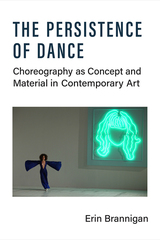 The Persistence of Dance: Choreography as Concept and Material in Contemporary Art
Erin Brannigan
University of Michigan Press, 2023 There is a category of choreographic practice with a lineage stretching back to mid-20th century North America that has re-emerged since the early 1990s: dance as a contemporary art medium. Such work belongs as much to the gallery as does video art or sculpture and is distinct from both performance art and its history as well as from theater-based dance.
The Persistence of Dance: Choreography as Concept and Material in Contemporary Art clarifies the continuities and differences between the second-wave dance avant-garde in the 1950s‒1970s and the third-wave starting in the 1990s. Through close readings of key artists such as Maria Hassabi, Sarah Michelson, Boris Charmatz, Meg Stuart, Philipp Gehmacher, Adam Linder, Agatha Gothe-Snape, Shelley Lasica and Latai Taumoepeau, The Persistence of Dance traces the relationship between the third-wave and gallery-based work. Looking at these artists highlights how the discussions and practices associated with “conceptual dance” resonate with the categories of conceptual and post-conceptual art as well as with the critical work on the function of visual art categories. Brannigan concludes that within the current post-disciplinary context, there is a persistence of dance and that a model of post-dance exists that encompasses dance as a contemporary art medium.
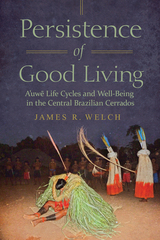 Persistence of Good Living: A’uwe Life Cycles and Well-Being in the Central Brazilian Cerrados
James R. Welch
University of Arizona Press, 2023 Cultural understandings of well-being often differ from scientific measures such as health, happiness, and affluence. For the Indigenous A’uwẽ (Xavante) people in the tropical savannas of Brazil, special forms of intimate and antagonistic social relations, camaraderie, suffering, and engagement with the environment are fundamental aspects of community wellness.
Anthropologist James R. Welch transparently presents ethnographic insights from his long-term fieldwork in two A’uwẽ communities. He addresses how distinctive constructions of age organization contribute to social well-being in an era of major ecological, economic, and sociocultural change. Welch shows how A’uwẽ perspectives on the human life cycle help define ethnic identity, promote cultural resilience, and encourage the betterment of youth. They provide frameworks that people may creatively mobilize to responsibly and respectfully engage with others at different stages of life. They also motivate people to access and manage landscape resources essential to the social construction of good living. Through careful analysis, Welch shows how contemporary traditional peoples can foster enthusiasm for service to family and community amid dominant cultures that prioritize individual well-being.
This book is an essential resource for students and scholars interested in sociocultural anthropology, Indigenous cultures, health and culture, and human ecology.
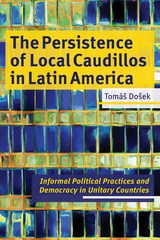 The Persistence of Local Caudillos in Latin American: Informal Political Practices and Democracy in Unitary Countries
Tomas Dosek
University of Pittsburgh Press, 2024 Despite democratization at the national level, local political bosses still govern many municipalities in Latin America. Caudillos and clans often use informal political practices—ranging from clientelism and patronage to harassment of political opposition—to control local political dynamics. These arbitrary and, at times, abusive practices pose important challenges to how Latin American democracy works and how power is exercised after the decentralization reforms in the region. These reforms promised to bring the government closer to the people and to promote popular participation. In many cases, these ideals are unmet, and newly empowered local politicians have been able to turn municipalities into personal fiefdoms. This book explores how local caudillos stay in power and why some are more successful than others in retaining office. Tomáš Došek provides an in-depth analysis of six cases from Chile, Paraguay, and Peru to show the strategies that caudillos pursue to secure power and the mistakes they commit that drive them out.
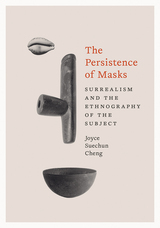 The Persistence of Masks: Surrealism and the Ethnography of the Subject
Joyce Suechun Cheng
University of Minnesota Press, 2025 An examination of surrealism’s unofficial ethnography of marginalized subjectivities
In interwar Paris, the encounter between surrealism and the nascent discipline of ethnology led to an intellectual project now known as “ethnographic surrealism.” In The Persistence of Masks, Joyce Suechun Cheng considers the ethnographic dimension of the surrealist movement in its formative years through a close look at the reviews Documents (1929–30) and Minotaure (1933–39) as well as the surrealist writer-turned-ethnographer Michel Leiris’s ethnography of possession. Analyzing surrealist aesthetic criticism, art, poetry, and field research in terms of a common interest in marginalized modes of subjectivity, Cheng argues that the surrealists used the figures of the mask, the veil, the hand, and the hat to radically reconceive the subject as nonhegemonic, nonanthropocentric, and feminine-identified. Though ethnographic surrealism usually refers to the collaboration between professional ethnologists at the Institut de l’Ethnologie in Paris and Georges Bataille’s so-called dissident circle of surrealists, Cheng demonstrates that surrealism’s unofficial ethnography began long before the founding of the movement. Starting with André Breton’s wartime text “Subject” (1916), written when he was still a young psychiatric intern treating traumatized soldiers, she shows how the future surrealist poet shifted from a clinical to a para-ethnographic approach to subjectivity when adopting his patient’s first-person voice as a textual mask. Revealing surrealism to be always implicitly ethnographic, Cheng uncovers deep affinities between archrivals Breton and Bataille, highlights psychiatry’s underacknowledged role in surrealism’s lay ethnography, and theorizes the surrealists’ feminine identification as a means of critiquing power. By broadening the scope of ethnographic surrealism, The Persistence of Masks offers new insights that challenge longstanding beliefs about this multifaceted movement in poetry, the arts, and culture.
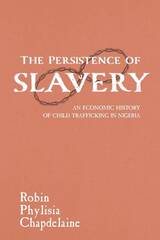 The Persistence of Slavery: An Economic History of Child Trafficking in Nigeria
Robin Phylisia Chapdelaine
University of Massachusetts Press, 2021 Despite efforts to abolish slavery throughout Africa in the nineteenth century, the coercive labor systems that constitute “modern slavery” have continued to the present day. To understand why, Robin Phylisia Chapdelaine explores child trafficking, pawning, and marriages in Nigeria's Bight of Biafra, and the ways in which British colonial authorities and Igbo, Ibibio, Efik, and Ijaw populations mobilized children's labor during the early twentieth century. Drawing on a wealth of primary sources that include oral interviews, British and Nigerian archival materials, newspaper holdings, and missionary and anthropological accounts, Chapdelaine argues that slavery's endurance can only be understood when we fully examine “the social economy of a child”—the broader commercial, domestic, and reproductive contexts in which children are economic vehicles.
The Persistence of Slavery provides an invaluable investigation into the origins of modern slavery and early efforts to combat it, locating this practice in the political, social, and economic changes that occurred as a result of British colonialism and its lingering effects, which perpetuate child trafficking in Nigeria today.
 The Persistence of the Sacred in Modern Thought
Chris L. Firestone
University of Notre Dame Press, 2012
In The Persistence of the Sacred in Modern Thought, Chris L. Firestone, Nathan A. Jacobs, and thirteen other contributors examine the role of God in the thought of major European philosophers from the seventeenth to the nineteenth century. The philosophers considered are, by and large, not orthodox theists; they are highly influential freethinkers, emancipated by an age no longer tethered to the authority of church and state. While acknowledging this fact, the contributors are united in arguing that this is only one side of a complex story. To redress the imbalance of attention to secularism among crucial modern thinkers and to consolidate a more theologically informed view of modernity, they focus on the centrality of the sacred (theology and God) in the thought of these philosophers. The essays, each in its own way, argue that the major figures in modernity are theologically astute, bent not on removing God from philosophy but on putting faith and reason on a more sure footing in light of advancements in science and a perceived need to rethink the relationship between God and world.
By highlighting and defending the theologically affirmative dimensions of thinkers such as Thomas Hobbes, Gottfried Leibniz, John Locke, Immanuel Kant, F. W. J. Schelling, G. W. F. Hegel, and others, the essayists present a forceful and timely correction of widely accepted interpretations of these philosophers. To ignore or downplay the theological dimensions of the philosophical works they address, they argue, distorts our understanding of modern thought.
"Over the past twenty-five years there has been a gradual change in the study of modern philosophy toward recognizing the centrality of our relation to God in the work of most of the major modern thinkers of the period. The Persistence of the Sacred in Modern Thought is a timely and useful collection that has the potential to crystallize this important development in the study of modern philosophy." —John E. Hare, Yale Divinity School
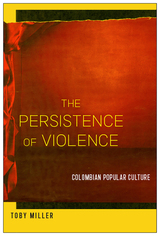 The Persistence of Violence: Colombian Popular Culture
Toby Miller
Rutgers University Press, 2020 Colombia’s headline story, about the peace process with guerrilla and its attendant controversies, does not consider the fundamental contradiction of a nation that spans generosity and violence, warmth and hatred—products of its particular pattern of invasion, dispossession, and enslavement. The Persistence of Violence fills that gap in understanding. Colombia is a place that is two countries in one—the ideal and the real—summed up in the idiomatic expression, not unique to Colombia, but particularly popular there, "Hecha la ley, hecha la trampa" (When you pass a law, you create a loophole). Less cynically, and more poetically, the Nobel Laureate Gabriel García Márquez deemed Colombians capable of both the most noble acts and the most abject ones, in a world where it seems anyone might do anything, from the beautiful to the horrendous.The Persistence of Violence draws on those contradictions and paradoxes to look at how violence—and resistance to it—characterize Colombian popular culture, from football to soap opera to journalism to tourism to the environment.
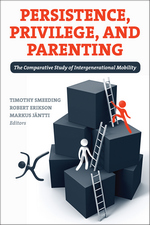 Persistence, Privilege, and Parenting: The Comparative Study of Intergenerational Mobility
Timothy Smeeding
Russell Sage Foundation, 2012 Americans like to believe that theirs is the land of opportunity, but the hard facts are that children born into poor families in the United States tend to stay poor and children born into wealthy families generally stay rich. Other countries have shown more success at lessening the effects of inequality on mobility—possibly by making public investments in education, health, and family well-being that offset the private advantages of the wealthy. What can the United States learn from these other countries about how to provide children from disadvantaged backgrounds an equal chance in life? Making comparisons across ten countries, Persistence, Privilege, and Parenting brings together a team of eminent international scholars to examine why advantage and disadvantage persist across generations. The book sheds light on how the social and economic mobility of children differs within and across countries and the impact private family resources, public policies, and social institutions may have on mobility. In what ways do parents pass advantage or disadvantage on to their children? Persistence, Privilege, and Parenting is an expansive exploration of the relationship between parental socioeconomic status and background and the outcomes of their grown children. The authors also address the impact of education and parental financial assistance on mobility. Contributors Miles Corak, Lori Curtis, and Shelley Phipps look at how family economic background influences the outcomes of adult children in the United States and Canada. They find that, despite many cultural similarities between the two countries, Canada has three times the rate of intergenerational mobility as the United States—possibly because Canada makes more public investments in its labor market, health care, and family programs. Jo Blanden and her colleagues explore a number of factors affecting how advantage is transmitted between parents and children in the United States and the United Kingdom, including education, occupation, marriage, and health. They find that despite the two nations having similar rates of intergenerational mobility and social inequality, lack of educational opportunity plays a greater role in limiting U.S. mobility, while the United Kingdom’s deeply rooted social class structure makes it difficult for the disadvantaged to transcend their circumstances. Jane Waldfogel and Elizabeth Washbrook examine cognitive and behavioral school readiness across income groups and find that pre-school age children in both the United States and Britain show substantial income-related gaps in school readiness—driven in part by poorly developed parenting skills among overburdened, low-income families. The authors suggest that the most encouraging policies focus on both school and home interventions, including such measures as increases in federal funding for Head Start programs in the United States, raising pre-school staff qualifications in Britain, and parenting programs in both countries. A significant step forward in the study of intergenerational mobility, Persistence, Privilege, and Parenting demonstrates that the transmission of advantage or disadvantage from one generation to the next varies widely from country to country. This striking finding is a particular cause for concern in the United States, where the persistence of disadvantage remains stubbornly high. But, it provides a reason to hope that by better understanding mobility across the generations abroad, we can find ways to do better at home.
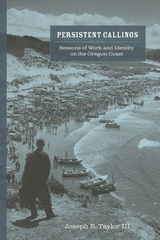 Persistent Callings: Seasons of Work and Identity on the Oregon Coast
Joseph E. Taylor
Oregon State University Press, 2019 The Nestucca Valley is a small watershed, tucked away in one corner of a county in far western Oregon. There are no incorporated towns, and cows outnumber humans. It has long been a place without a written history, yet its past offers many surprising twists on received wisdom about rural economies. In crisp prose and succinct chapters, Persistent Callings carries readers from aboriginal times to the present, illustrating the wisdom of seasonal labor, the complex relationships between work and identity, and the resilience of rural economics across more than a century of almost continual change. Life in this watershed, known to locals as “South County,” has always been demanding. Farming, fishing, and logging were difficult occupations, but work had deeper meanings. Challenges arrived in many forms, including climate shifts, market crashes, regulatory changes, and industry consolidations. Residents’ ability to innovate was their greatest resource, and their persistence helps us to recognize the callings they pursued. During the late twentieth and early twenty-first centuries, disruptions came more quickly, and they coincided with infusions of capital that dramatically altered the structure of employment, with devastating results for the valley’s hardest working residents. Unemployment and poverty skyrocketed while health and life expectancy dropped to alarming levels. Moreover, the arrival of retirees and rise of environmental amenities actually exacerbated some ecological problems. Little in this history plays out as expected, and much of it will make readers reconsider how they think about the social, economic, and environmental contours of rural life in the American West.
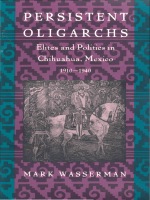 Persistent Oligarchs: Elites and Politics in Chihuahua, Mexico 1910–1940
Mark Wasserman
Duke University Press, 1993 Did the Mexican Revolution do away with the ruling class of the old regime? Did a new ruling class rise to take the old one's place—and if so, what differences resulted? In this compelling study, the first of its kind, Mark Wasserman pursues these questions through an analysis of the history and politics of the northern Mexican state of Chihuahua from 1910 to 1940.
Chihuahua boasted one of the strongest pre-revolutionary elite networks, the Terrazas-Creel family. Wasserman describes this group's efforts to maintain its power after the Revolution, including its use of economic resources and intermarriage to forge partnerships with the new, revolutionary elite. Together, the old and new elites confronted a national government that sought to reestablish centralized control over the states and the masses. Wasserman shows how the revolutionary government and the popular classes, joined in opposition to the challenge of the elites, finally formalized into a national political party during the 1930s.
Persistent Oligarchs concludes with an account of the Revolution's ultimate outcome, largely accomplished by 1940: the national government gaining central control over politics, the popular classes obtaining land redistribution and higher wages, and regional elites, old and new, availing themselves of the great opportunities presented by economic development. A complex analysis of revolution as a vehicle for both continuity and change, this work is essential to an understanding of Mexico and Latin America, as well as revolutionary politics and history.
Persistent Peoples: Cultural Enclaves in Perspective
Edited by George Pierre Castile and Gilbert Kushner
University of Arizona Press, 1981 What constitutes a people? Persistent Peoples draws on enduring groups from around the world to identify and analyze the phenomenon of cultural enclavement. While race, homeland, or language are often considered to be determining factors, the authors of these original articles demonstrate a more basic common denominator: a continuity of common identity in resistance to absorption by a dominant surrounding culture.
Contributors:
William Y. Adams
George Pierre Castile
N. Ross Crumrine
Timothy Dunnigan
Charles J. Erasmus
Frederick J. E. Gorman
Vera M. Green
William B. Griffen
Robert C. Harman
Mark P. Leone
Janet R. Moone
John van Willigen
Willard Walker
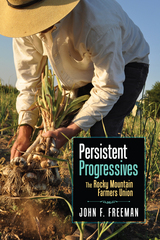 Persistent Progressives: The Rocky Mountain Farmers Union
John F. Freeman
University Press of Colorado, 2015 Persistent Progressives tells the story of the Rocky Mountain Farmers Union’s evolution from an early movement against monopolists and wholesalers to a regional trailblazer for agriculture ideologies built on social democracy, the family farmer, and cooperative enterprises. As a continuing advocate for saving the family farm, the Farmers Union legacy provides a unique window into the transformation of the agriculture and rural communities in Wyoming, Colorado, and New Mexico.
Using data spanning decades, author John Freeman covers the founding of the RMFU in 1907 until the present, demonstrating how members continually sought to control the means of production and marketing by forming cooperatives, providing consumer services, and engaging in politics. Powering this evolution was a group of “practical idealists”—the Farmers Union leaders and titular persistent progressives who shaped the organization’s growth and expansion. Initiated by Jim Patton, who brought the organization out of its oppositional roots and into its cooperative advocacy, the RMFU passed to John Stencel and then David Carter, joining hands with agricultural conservationists and small organic producers along the way to carry the torch for progressive agrarianism in today’s urbanized world. Shaken but undeterred by some notable failures, its leadership remains convinced of the efficacy of cooperatives as a means to achieve justice for all.
Discussing the broader social, economic, political, and environmental issues related to farming, ranching, and urbanization, Persistent Progressives seamlessly blends regional history with ongoing issues of agricultural and economic development.
A Persistent Threat: The Evolution of al Qa'ida and Other Salafi Jihadists
Seth G. Jones
RAND Corporation, 2014 This report examines the status and evolution of al Qa’ida and other Salafi-jihadist groups, and uses qualitative and quantitative data to assess whether this movement has strengthened. The author uses this analysis to examine U.S. strategic options to counter al Qa’ida and other terrorist groups based on the threat level and the capacity of local governments.
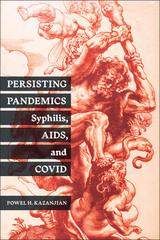 Persisting Pandemics: Syphilis, AIDS, and COVID
Powel H. Kazanjian
Rutgers University Press, 2025 Persisting Pandemics explores the history of syphilis and AIDS to provide insights into the limits of biomedicine and our experience with epidemics today. Novel therapies developed for syphilis and AIDS became renowned in the medical field and the broader public sphere as exemplars of biomedical innovations. Public health campaigns based on these spectacular biomedical advances, however, have repeatedly fallen short of their goals to eliminate syphilis and AIDS in the population. The diseases epitomize the power of innovative biomedical therapies for the individual while unveiling limitations of scientific medicine in the domain of public health. The need for a public health approach to address mistrust in science, government indifference, and racial inequalities is relevant for strategies to eliminate COVID-19 today. Persisting Pandemics argues that campaigns to eliminate these diseases have not succeeded because they have not adequately addressed how diseases like AIDS, syphilis, and COVID spread unevenly in populations according to race, ethnicity, and geographic location. Despite the expectation of public health officials that medical advances would render epidemics obsolete, new diseases continue to emerge and spread regardless of efforts to eliminate them. Medical doctor and historian Powel H. Kazanjian concludes that narratives of syphilis, AIDS and COVID, unlike smallpox, do not contain a discrete ending—at least not within the timelines specified by their elimination campaigns. Instead they will be a continued part of our existence.
Persius: A Study in Food, Philosophy, and the Figural
Shadi Bartsch
University of Chicago Press, 2015 The Roman poet and satirist Persius (34–62 CE) was unique among his peers for lampooning literary and social conventions from a distinctly Stoic point of view. A curious amalgam of mocking wit and philosophy, his Satires are rife with violent metaphors and unpleasant imagery and show little concern for the reader’s enjoyment or understanding.
In Persius, Shadi Bartsch explores this Stoic framework and argues that Persius sets his own bizarre metaphors of food, digestion, and sexuality against more appealing imagery to show that the latter—and the poetry containing it—harms rather than helps its audience. Ultimately, he encourages us to abandon metaphor altogether in favor of the non-emotive abstract truths of Stoic philosophy, to live in a world where neither alluring poetry, nor rich food, nor sexual charm play a role in philosophical teaching.
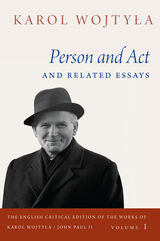 Person and Act and Related Essays
Karol Wojtyla
Catholic University of America Press, 2021 The Catholic University of America Press is honored to announce the publication of the first volume of the critical English edition of The Collected Works of Karol Wojtyła/John Paul II. In conjunction with an international editorial board, the English Critical Edition will comprise 20 volumes, covering all of his writings and correspondence both in the years before and during his papacy.
What makes this collection so important is that access to his writings have been a significant challenge. Except for official papal addresses and documents preserved and disseminated by the Vatican, his works have been scattered and limited, or in need of a new translation. Finally, English-language audiences have faced the challenge, even in the case of published texts, of working across multiple languages and translations and of dealing with textual idiosyncrasies.
The inaugural volume of this collection is Person and Act, together with related essays, which is in many respects constitutes Karol Wojtyła’s most profound and well-known philosophical work. Originally published in 1969 as Osoba I czyn, this work of metaphysics and philosophy is widely influential even though it is highly challenging intellectually and has heretofore posed difficulties for translators.
Person and Myth: Maurice Leenhardt in the Melanesian World
James Clifford
Duke University Press, 1992 Originally published in 1982, James Clifford's analytical biography of Maurice Leenhardt (1878–1954)—missionary, anthropologist, founder of French Oceanic studies, historian of religion, and colonial reformer—received wide critical acclaim for its insight into the colonial history of anthropology. Drawing extensively on unpublished letters and journals, Clifford traces Leenhardt's life from his work as a missionary on the island of New Caledonia (1902–1926) to his subsequent return to Paris where he became an academic anthropologist at the École Practique des Hautes Études, where he followed Marcel Mauss and was succeeded in 1951 by Claude Lévi-Strauss. Clifford sees in Leenhardt's career a foreshadowing of contemporary anthropological concerns with reflexivity, cultural hybridity, and colonial and post-colonial entanglements.
Person, Being, and History
Michael Baur
Catholic University of America Press, 2011 the various essays in this volume by colleagues and former students of Schmitz examine his thought and the subjects of his teaching. In addition to an overall exposition of his own thought, the collection treats themes such as gift, faith and reason, culture and dialogue, modernity and post-modernity
Person Means Relation
David Walsh
St. Augustine's Press, 2024 In Person Means Relation, David Walsh offers a moving reflection on personhood, beginning from the connection between person and relation established in the Trinitarian theology of St. Thomas Aquinas. Although Thomas did not apply this insight to persons more generally, Walsh argues, there is enough to suggest the path he might have taken. To know persons, we can now see, is to know what is going on within them. This understanding is largely the fruit of a later philosophical revolution, a fruit toward which Thomas may have pointed, and which he might well have welcomed.
The University of Dallas Aquinas Lecture for 2023, Person Means Relation is published here with a response by Matthew Walz and a reply by David Walsh.
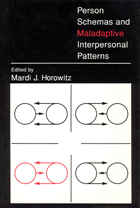 Person Schemas and Maladaptive Interpersonal Patterns
Edited by Mardi J. Horowitz
University of Chicago Press, 1991 This fresh exploration of the utility of “person schemas” for understanding interpersonal
behavior and intrapsychic conflict brings together psychoanalytic researchers, social learning
theorists, and cognitive scientists. The contributors show that a fuller conceptualization of
person schemas can begin to close the gap between psychodynamic and cognitive science
research, providing new methods for understanding disorders of personality.
“There are many strengths in this volume beyond the clear presentation of the person schema
as a concept linking cognitive and psychodynamic perspectives. . . . Students will have an
opportunity for comparison of perspectives while those working in the field will have an
opportunity to follow the shift from concept to method to case application to theoretical
context for understanding personality change.”—Bertram J. Cohler, University of Chicago
Contributors are Lorna Smith Benjamin, Paul Crits-Christoph, Randolph L. Cunningham, Roy
D'Andrade, Amy Demorest, Mary Ewert, Scott H. Friedman, Frances J. Friedrich, Jess H.
Ghannam, Dianna Hartley, Mardi J. Horowitz, John F. Kihlstrom, Peter H. Knapp, Lester
Luborsky, David Mark, Thomas V. Merluzzi, Stephen E. Palmer, Carol Popp, Peter Salovey,
Pamela Schaffler, Jerome L. Singer, Charles H. Stinson, and Sandra L. Tunis.
PERSON TO PERSON: THE GOSPEL OF MARK
PAUL VICKERS
Swedenborg Foundation Publishers, 1998
Paul Vickers grapples with the question of how God wants us to live our daily lives, and he turns to a new way of reading the gospel of Mark for answers. Vickers' insightful discussion of its rich symbolism reveals the relevance this gospel has to our lives. God, according to Vickers, is the same immediate presence for the reader of today that he was at the time of the writing of the book of Mark. Through the immediacy of his presence, in a manner unique to each reader, God urges us to examine and improve our lives. Encouraging a less self-centered engagement with the world, Person to Person: The Gospel of Mark fosters development of a more loving, more spiritually conscious soul.
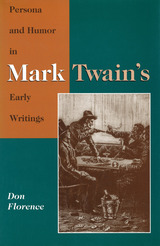 Persona and Humor in Mark Twain's Early Writings
Don Florence
University of Missouri Press, 1995
In Persona and Humor in Mark Twain's Early Writings, Don Florence explains that Samuel Clemens did more than use the borrowed name of Mark Twain to sign his writings. He also developed a separate identity, or persona, becoming "a literary personality in his own right."
Challenging mainstream Twain criticism on many fronts, Florence focuses exclusively on Twain's early writings. He demonstrates how Twain evolved in his early narratives into the "Mark Twain" we now recognize. Florence maintains that this process was evolutionary: Although Twain might have been dependent on Clemens for the initial experiences, they become Twain's experiences, necessary for his development as a persona. Traditionally, critics of Twain have been preoccupied with dualities, but Florence sees this emphasis upon polarities as an oversimplification. He argues that much of Twain's humor strives to shape more and more of the world, giving Twain multiple narrative voices and letting him be inclusive, not exclusive.
Finally, this study asserts that there is more continuity to Mark Twain's career than has been generally recognized. Many Twain scholars have argued that Twain's later writings are radically different from his earlier writings because of their emphasis upon illusion and dream. Florence argues that the preoccupation with illusion and fantasy is scarcely new. Whether Twain's mood is exuberant or dark, he emphasizes subjectivity over objectivity, the dominance of fantasy, the creative powers of humor, and his ability as persona to determine what we consider "reality." Florence contends that Twain's early writings show Mark Twain gradually evolving into a masterfully comic persona.
Jargon-free and eloquently written, Persona and Humor in Mark Twain's Early Writings provides a fascinating look at Mark Twain's developing genius and will be a welcome addition to Twain literature.
Persona: Social Role and Personality
Helen Harris Perlman
University of Chicago Press, 1986 Persona is the Latin word for the mask used in Greek drama with which the actor assumed his role and defined his identity. Perlman analyzes the way in which adult roles assumed in work, marriage, and parenthood continue to shape human personality. Referring to Freud's definition of maturity as the ability to love and to work, she discusses how a person makes himself known through the roles involved in loving and working, what expectations a person brings to each role, and what personal changes can come about through the demands of being a worker, marriage partner, and parent.
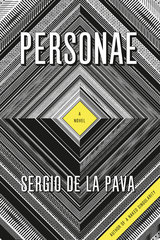 Personae: A Novel
Sergio De La Pava
University of Chicago Press, 2013 Sergio De La Pava’s A Naked Singularity was one of the most highly praised debut novels in decades. The Wall Street Journal called it “a propulsive, mind-bending experience,” and named it one of the ten best books of the year. The Toronto Star did the same, calling it “a great American novel: large, ambitious, and full of talk.” In Slate, Paul Ford proclaimed,“It’s a fine thing for an author to bring forth something so unapologetically maximalist.”
This book is nothing like that one. Just look at it: A Naked Singularity was a brick of a book, 678 pages, and this one’s slim--lean and focused. A Naked Singularity locked us into the unforgettable voice of its protagonist, Casi, while Personae shimmers and shifts among different perspectives, locations, and narrative techniques.
But sharp readers will quickly see that the two books are the work of the same hand. The sheer energy of De La Pava’s sentences, his eye for absurd humor, his commitment to the idea of justice--all will be familiar here as they carry us from the tale of an obsessive, damaged psychic detective consumed by a murder case, into a Sartrean drama that raises questions (and jokes) about responsibility, fate, death, and more. And when De La Pava eventually returns us to the investigation, this time seen from the other side, the lives and deaths bound up in it feel all the more real, and moving, even as solid answers slip away into mist.
Shelf Awareness declared that A Naked Singularity "heralded the arrival of a tremendous talent." In some ways, despite its brevity, Personae is even more surprising and challenging--and, in its ambition and fierce intelligence, it’s proof that Sergio De La Pava is here to stay.
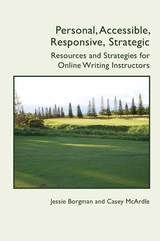 Personal, Accessible, Responsive, Strategic: Resources and Strategies for Online Writing Instructors
Jessie Borgman
University Press of Colorado, 2020 Drawing on their novel PARS framework, Jessie Borgman and Casey McArdle explore the complexities and anxieties associated with online writing instruction. PARS offers an innovative way to support your own online instructional efforts as well as those of faculty members in programs that offer online writing instruction. Borgman and McArdle offer extensive examples of how to create assignments, syllabi, and accessible, productive learning spaces. Drawing on work in the design of user experiences, they explore how we can design online writing courses with our students' experiences in mind. Borgman and McArdle encourage us to plan online writing courses strategically, and they reinforce the importance of iterating our course design and teaching practices continually with the goal of creating a better user experience for everyone involved with the course.
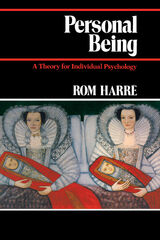 Personal Being: A Theory for Individual Psychology
Rom Harre
Harvard University Press, 1984 The undoubted fact of human individuality has remained outside the field of interest of scientific psychology. Neither the central organization of consciousness nor individual powers of action have been dealt with in substantial research programmes. Yet every facet of our mental lives is influenced by how our minds are organized. How much of this organization comes from the languages and social practices of the cultures into which we are born is undetermined.
In this book, Rom Harré explores the radical thesis that most of our personal being may be of social origin. Consciousness, agency and autobiography are the three unities which make up our personal being. Their origin in childhood development and their differences in different cultures are explored.
Nevertheless, despite the overwhelming influence of social environment on mental structure, individual identity is a central facet of Western culture. How is the formation of such identity possible? Rom Harré ends with the suggestion that personal identity derives from the complementary powers of human beings both to display themselves socially as unique and to create novel linguistic forms making individual thought and feeling possible.
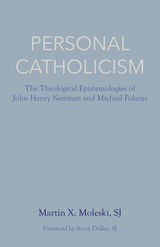 Personal Catholicism: The Theological Epistemologies of John Henry Newman and Michal Polanyi
Martin X. Moleski
Catholic University of America Press, 2020 "Both Newman and Polanyi rank high among the pioneers in the history of the post-critical movement in epistemology. They pointed out the limitations of the methods that had become current since the time of Descartes and Spinoza. . . . The systems of these two authors are exceptionally useful for dealing with the major issues that trouble the theological climate today."—From the Foreword by Avery Dulles, S.J.
"This engaging and lucid study brings into dialogue two thinkers whose methods share much in common despite their different purposes. . . . A principal contribution of Moleski's study is its cultivation of the common ground that religion shares with science."—Theological Studies
"An important and utterly engaging study. . . . Those familiar with Newman's Grammar of Assent and Polanyi's Personal Knowledge will appreciate the ways in which Moleski makes sometimes unexpected connections between the two thinkers, despite Polanyi's critical disposition toward Catholicism. Personal Catholicism is a most welcome contribution to today's rethinking of the relationship between faith and reason."—First Things
"There is a wealth of material here that could be applied to issues of faith and reason, science and faith, faith and the nature of reality as they are raised in contemporary society. . . ."—The Gospel and Our Culture
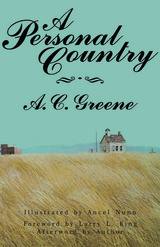 A Personal Country
A. C. Greene
University of North Texas Press, 1998 This book brings alive what one man feels about his childhood home. The place is West Texas, seen across a long vista in which today’s events and people merge with the author’s boyhood and young manhood.
It is a harsh, remote country, where the weather is always very close and the horizon far away. The Brazos country of long-ago Fourth of July fishing expeditions; the grass-grown remains of a way station of the Butterfield Stage Line; the streets of Abilene; the sparse grazing lands under infinite skies-all are made resonant by a native son’s affection and understanding. It is a way of life-resilient and persnickety-that is almost gone.
Above all, it is people: the author’s grandmother, who had a mortal fear of bridges and whose premonitions of unnamed calamities (that as often as not happened), both alarmed and pleased the young boy; Uncle Aubrey, “who married late”; the blacksmith they awakened in the dead of night; the familiar neighbors; the rare and deliciously mysterious strangers.
With humor and strong, unsentimental feeling, A. C. Greene conserves for us the priceless eccentricities of place and person that are being flattened out-almost literally bulldozed away-by the impatient, insatiable onrush of the twentieth century. His West Texas is a very personal country, but what he seeks to share will be familiar to all who take pleasure in the memories that tie them to their own special region of America.
Personal Effects
edited by Deborah H. Holdstein & David Bleich
Utah State University Press, 2002 In Personal Effects, Holdstein and Bleich compile a volume that cuts across the grain of current orthodoxy. These editors and contributors argue that it is fundamental in humanistic scholarship to take account of the personal and collective experiences of scholars, researchers, critics, and teachers.
With this volume, then, these scholars move us to explore the intersections of the social with subjectivity, with voice, ideology, and culture, and to consider the roles of these in the work of academics who study writing and literature. Taken together, the essays in this collection carry forward the idea that the personal, the candidly subjective and intersubjective, must be part of the subject of study in humanities scholarship. They propose an understanding of the personal in scholarship that is more helpful because more clearly anchored in human experience.
Personal Knowledge Graphs (PKGs): Methodology, tools and applications
Sanju Tiwari
The Institution of Engineering and Technology, 2023 Since the development of the semantic web, knowledge graphs (KGs) have been used by search engines, knowledge-engines and question-answering services as well as social networks. A knowledge graph, also known as a semantic network, represents and illustrates a network of real-world entities such as objects, events, situations, or concepts and the relationships between them. This information is usually stored in a graph database and visualized as a graph structure, prompting the term "knowledge graph". Knowledge graphs structure the information of entities, their properties and the relation between them.
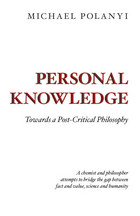 Personal Knowledge: Towards a Post-Critical Philosophy
Michael Polanyi
University of Chicago Press, 1974 In this work the distinguished physical chemist and philosopher, Michael Polanyi, demonstrates that the scientist's personal participation in his knowledge, in both its discovery and its validation, is an indispensable part of science itself. Even in the exact sciences, "knowing" is an art, of which the skill of the knower, guided by his personal commitment and his passionate sense of increasing contact with reality, is a logically necessary part. In the biological and social sciences this becomes even more evident.
The tendency to make knowledge impersonal in our culture has split fact from value, science from humanity. Polanyi wishes to substitute for the objective, impersonal ideal of scientific detachment an alternative ideal which gives attention to the personal involvement of the knower in all acts of understanding. His book should help to restore science to its rightful place in an integrated culture, as part of the whole person's continuing endeavor to make sense of the totality of his experience. In honor of this work and his The Study of Man Polanyi was presented with the Lecomte de Noüy Award for 1959.
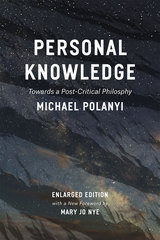 Personal Knowledge: Towards a Post-Critical Philosophy
Michael Polanyi
University of Chicago Press, 2015 The publication of Personal Knowledge in 1958 shook the science world, as Michael Polanyi took aim at the long-standing ideals of rigid empiricism and rule-bound logic. Today, Personal Knowledge remains one of the most significant philosophy of science books of the twentieth century, bringing the crucial concepts of “tacit knowledge” and “personal knowledge” to the forefront of inquiry.
In this remarkable treatise, Polanyi attests that our personal experiences and ways of sharing knowledge have a profound effect on scientific discovery. He argues against the idea of the wholly dispassionate researcher, pointing out that even in the strictest of sciences, knowing is still an art, and that personal commitment and passion are logically necessary parts of research. In our technological age where fact is split from value and science from humanity, Polanyi’s work continues to advocate for the innate curiosity and scientific leaps of faith that drive our most dazzling ingenuity.
For this expanded edition, Polyani scholar Mary Jo Nye set the philosopher-scientist’s work into contemporary context, offering fresh insights and providing a helpful guide to critical terms in the work. Used in fields as diverse as religious studies, chemistry, economics, and anthropology, Polanyi’s view of knowledge creation is just as relevant to intellectual endeavors today as when it first made waves more than fifty years ago.
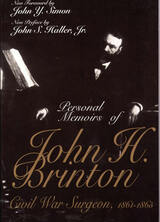 Personal Memoirs of John H. Brinton: Civil War Surgeon, 1861-1865
John H. Brinton. Preface by John S. Haller, Jr. Foreword by John Y. Simon
Southern Illinois University Press, 1996 John Hill Brinton (1832–1907) met, observed, and commented on practically the entire hierarchy of the Union army; serving as medical director for Ulysses S. Grant, he came into contact with Philip H. Sheridan, John C. Frémont, Henry W. Halleck, William A. Hammond, D. C. Buell, John A. Rawlins, James Birdseye McPherson, C. F. Smith, John A. McClernand, William S. Rosecrans, and his first cousin George Brinton McClellan. John Y. Simon points out in his foreword that Brinton was one of the first to write about a relatively obscure Grant early in the war: "Brinton found a quiet and unassuming man smoking a pipe—he could not yet afford cigars— and soon recognized a commander with mysterious strength of intellect and character." Positioned perfectly to observe the luminaries of the military, Brinton also occupied a unique perspective from which to comment on the wretched state of health and medicine in the Union army and on the questionable quality of medical training he found among surgeons. With both A.B. and A.M. degrees from the University of Pennsylvania and postgraduate training in Paris and Vienna at a time when most medical schools required only a grammar school education, Brinton was exceptional among Civil War doctors. He found, as John S. Haller, Jr., notes in his preface, "the quality of candidates for surgeon’s appointments was meager at best." As president of the Medical Examining Board, Brinton had to lower his standards at the insistence of Secretary of War Edwin Stanton. Haller points out that one "self-educated candidate for an appointment as brigade surgeon explained to the board that he could do ‘almost anything, from scalping an Indian, up and down.’" Brinton assigned this singular candidate to duty in Kansas "where Brinton hoped he would do the least amount of damage." Throughout the war, the dearth of qualified surgeons created problems. Brinton’s memoirs reveal a remarkable Civil War surgeon, a witness to conditions in Cairo, the Battle of Belmont, and the Siege of Fort Donelson who encountered almost every Union military leader of note. Brinton wrote his memoirs for the edification of his family, not for public consumption. Yet he was, as Haller notes, a "keen observer of character." And with the exception of Brinton’s acceptance of late nineteenth-century gossip favorable to his cousin General McClellan, Simon finds the memoirs "remarkable for accuracy and frankness." His portrait of Grant is vivid, and his comments on the state of medicine during the war help explain, in Haller’s terms, why the "Civil War was such a medical and human tragedy."
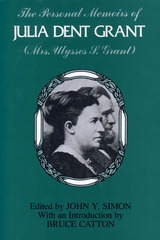 The Personal Memoirs of Julia Dent Grant: (Mrs. Ulysses S. Grant)
Edited by John Y. Simon
Southern Illinois University Press, 1975 Written in the early twentieth century for her children and grandchildren and first published in 1975, these eloquent memoirs detail the life of General Ulysses S. Grant’s wife. First Lady Julia Dent Grant wrote her reminiscences with the vivacity and charm she exhibited throughout her life, telling her story in the easy flow of an afternoon conversation with a close friend. She writes fondly of White Haven, a plantation in St. Louis County, Missouri, where she had an idyllic girlhood and later met Ulysses. In addition to relating the joys she experienced, Grant tells about the difficult and sorrowful times. Her anecdotes give fascinating glimpses into the years of the American Civil War. One recounts the night President Abraham Lincoln was assassinated. Grant insisted she and her husband turn down an invitation to the theater. Her decision saved her husband’s life: like Lincoln, he too had been marked for assassination. Throughout these memoirs, which she ends with her husband’s death, Grant seeks to introduce her descendants to both her and the man she loved. She also strives to correct misconceptions that were circulated about him. She wanted posterity to share her pride in this man, whom she saw as one of America’s greatest heroes. Her book is a testament to their devoted marriage. This forty-fifth-anniversary edition includes a new foreword by John F. Marszalek and Frank J. Williams, a new preface by Pamela K. Sanfilippo, the original foreword by Bruce Catton, the original introduction by editor John Y. Simon, recommendations for further reading, and more than twenty photographs of the Grants, their children, and their friends.
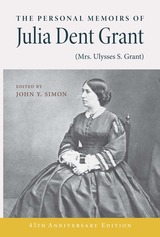 The Personal Memoirs of Julia Dent Grant: (Mrs. Ulysses S. Grant)
Edited by John Y. Simon
Southern Illinois University Press, 1975 Written in the early twentieth century for her children and grandchildren and first published in 1975, these eloquent memoirs detail the life of General Ulysses S. Grant’s wife. First Lady Julia Dent Grant wrote her reminiscences with the vivacity and charm she exhibited throughout her life, telling her story in the easy flow of an afternoon conversation with a close friend. She writes fondly of White Haven, a plantation in St. Louis County, Missouri, where she had an idyllic girlhood and later met Ulysses. In addition to relating the joys she experienced, Grant tells about the difficult and sorrowful times. Her anecdotes give fascinating glimpses into the years of the American Civil War. One recounts the night President Abraham Lincoln was assassinated. Grant insisted she and her husband turn down an invitation to the theater. Her decision saved her husband’s life: like Lincoln, he too had been marked for assassination. Throughout these memoirs, which she ends with her husband’s death, Grant seeks to introduce her descendants to both her and the man she loved. She also strives to correct misconceptions that were circulated about him. She wanted posterity to share her pride in this man, whom she saw as one of America’s greatest heroes. Her book is a testament to their devoted marriage. This forty-fifth-anniversary edition includes a new foreword by John F. Marszalek and Frank J. Williams, a new preface by Pamela K. Sanfilippo, the original foreword by Bruce Catton, the original introduction by editor John Y. Simon, recommendations for further reading, and more than twenty photographs of the Grants, their children, and their friends.
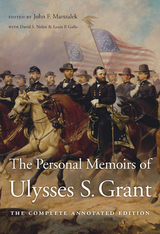 The Personal Memoirs of Ulysses S. Grant: The Complete Annotated Edition
Ulysses S. Grant
Harvard University Press, 2017 “Leaps straight onto the roster of essential reading for anyone even vaguely interested in Grant and the Civil War.”
—Ron Chernow, author of Grant
“Provides leadership lessons that can be obtained nowhere else… Ulysses Grant in his Memoirs gives us a unique glimpse of someone who found that the habit of reflection could serve as a force multiplier for leadership.”
—Thomas E. Ricks, Foreign Policy
Ulysses S. Grant’s memoirs, sold door-to-door by former Union soldiers, were once as ubiquitous in American households as the Bible. Mark Twain and Henry James hailed them as great literature, and countless presidents credit Grant with influencing their own writing. This is the first comprehensively annotated edition of Grant’s memoirs, clarifying the great military leader’s thoughts on his life and times through the end of the Civil War and offering his invaluable perspective on battlefield decision making. With annotations compiled by the editors of the Ulysses S. Grant Association’s Presidential Library, this definitive edition enriches our understanding of the pre-war years, the war with Mexico, and the Civil War. Grant provides essential insight into how rigorously these events tested America’s democratic institutions and the cohesion of its social order.
“What gives this peculiarly reticent book its power? Above all, authenticity… Grant’s style is strikingly modern in its economy.”
—T. J. Stiles, New York Times
“It’s been said that if you’re going to pick up one memoir of the Civil War, Grant’s is the one to read. Similarly, if you’re going to purchase one of the several annotated editions of his memoirs, this is the collection to own, read, and reread.”
—Library Journal
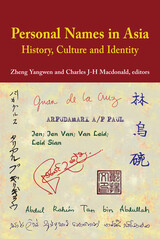 Personal Names in Asia: History, Culture and Identity
Edited by Yangwen Zheng and Chales J-H MacDonald
National University of Singapore Press, 2009 The world's population negotiates a multiplicity of naming systems. Some are compatible with the "normative" system of the world of passports and identity cards but a great many are not. This is particularly true in Asia, a region with some of the most sophisticated naming devices found anywhere in the world, including nicknames and teknonyms, religious and corporation names, honor and death names, pseudonyms and retirement names, house names and clan names, local and foreign names, official and private names. People across the continent carry multiple names meaningful to different audiences. Some are used only in family relations while others locate individuals in terms of gender, ethnicity, religion, caste, class, and nation. The centrality of names to many of the crucial debates and preoccupations of the modern world – identity, hybridity, migration, nationalism, multi-culturalism, globalization – makes it particularly surprising that there has been little systematic comparative exploration of Asian names and naming systems. This path-breaking volume classifies and theorizes the systems underlying naming practices in Asia, especially in Southeast Asia where systems are abundant and fluid. Using historical and socio-anthropological perspectives, the authors of this exceptionally close collaborative effort show the intricate connections between naming systems, notions of personhood and the prevailing ethos of interpersonal relations. They also show how the peoples of Asia are fashioning new types of naming and different ways of identifying themselves to suit the demands of a changing world.
Personal Places: Perspectives on Informal Art Environments
Smith
University of Wisconsin Press, 1984 The human-constructed modifications of the environment and landscape examined in the essays collected here have been referred to as everything from piles of junk to the greatest accomplishments of humankind.
A Personal Record
Joseph Conrad
Northwestern University Press, 1982 Long unavailable, A Personal Record, the second of Conrad's autobiographical memoirs, originally appeared in 1912. These "reminiscent pages" retrace the author's East European origins, his years at sea, his passionate adoption of English, and the emergence of his career as one of the key figures in modern literature.
Personal Responsibility and Christian Morality
Josef Fuchs, SJ
Georgetown University Press, 1983 In this volume, Josef Fuchs has brought together 12 important essays which consider various aspects of the relationship between Christian morality and human behavior. Among the subjects he discusses are the connections between moral theology and Christian experience, the absolute character of moral norms, and the importance of ethical reflection in shaping the future of the human race.
Personal Science
Lillian-Yvonne Bertram
Tupelo Press, 2017 What happens when the imagined life and the stories we tell ourselves become terrifying, given our human ability to inhabit both mental and physical worlds? Bertram’s third full-length collection pivots on an extended piece of creative nonfiction, “Forecast,” which shows how obsessive thinking can begin in actual occurrences that are then exploded in the imagination. The science is personal, as the factual is tinted and stylized, filtered through a self grappling with the difficulty of knowing what is “real.”
 Personal Style Blogs: Appearances That Fascinate
Rosie Findlay
Intellect Books, 2017 From Style Rookie to Style Bubble, personal style blogs exploded onto the scene in the mid-2000s giving voice to young and stylish writers who had their own unique take on the seasonal fashion cycle and how to curate an individual style within the shifting swirl of trends. Personal Style Blogs examines the history and rise of style blogging and looks closely at the relationship between bloggers and their (frequently anonymous) readers as well as the response of the fashion industry to style bloggers’ amateur and often unauthorized fashion reportage.
The book charts the development of the style blogosphere and its transformation from an alternative, experimental space to one dominated by the fashion industry. Complete with examples of several famous fashion bloggers, such as Susie Lau, Rumi Neely, and Tavi Gevinson, the author explores notions of individuality, aesthetics, and performance on both sides of the digital platform. Findlay asks: what can style blogging teach us about women’s writing and the performance of a private self online? And what drives style bloggers to carve a space for themselves online?
Personal Styles in Early Cycladic Sculpture
Pat Getz-Gentle; With a Chapter by Jack de Vries
University of Wisconsin Press, 2001 Pat Getz-Gentle provides a clear and detailed survey of the Cycladic period, an early Bronze Age culture that thrived at the heart of the Aegean. In particular, she emphasizes the steps leading to the iconic, reclining folded-arm figure that uniquely defines the Cycladic era. Getz-Gentle also focuses on the personal aesthetics of fifteen carvers, several of whom are identified and discussed in this volume. New to this paperback edition is an expanded bibliography as well an addendum that contains additional works Getz-Gentle has attributed to some of the fifteen Cycladic sculptors she discusses in her book.
 The Personal Vote: Constituency Service and Electoral Independence
Bruce Cain, John Ferejohn, and Morris Fiorina
Harvard University Press, 1987 Modern legislators are increasingly motivated to serve their constituents in personal ways. Representatives act like ultimate ombudsmen: they keep in close touch with their constituents and try to cultivate a relationship with them based on service and accessibility. The Personal Vote describes the behavior of representatives in the United States and Great Britain and the response of their constituents as well. It shows how congressmen and members of Parliament earn personalized support and how this attenuates their ties to national leaders and parties.
The larger significance of this empirical work arises from its implications for the structure of legislative institutions and the nature of legislative action. Personalized electoral support correlates with decentralized governing institutions and special-interest policy making. Such systems tend to inconsistency and stalemate. The United States illustrates a mature case of this development, and Britain is showing the first movements in this direction with the decline of an established two-party system, the rise of a centrist third party, greater volatility in the vote, growing backbench independence and increasing backbench pressure for committees and staff.
This book is essential for specialists in American national government, British politics, and comparative legislatures and comparative parties.
Personalisation
Edited by Peter Beresford
Bristol University Press, 2014 Personalization has become a social policy buzzword in the twenty-first century as many organizations move steadily away from one-size-fits-all models of service. In this provocative book, Peter Beresford is joined by other top academics to challenge the personalization agenda. Although critical of one-size-fits-all approaches, they contend that personalization turns service users into consumers who are shopping in a care market. This does not facilitate better attunement to user needs, they argue, but an increased commodification of care that actually channels large profits toward a decreasing number of providers at the expense of service quality. A timely debate in an era when public programs are deeply embattled, Personalisation is a careful work of critical policy assessment.
 Personalism
Emmanuel Mounier
University of Notre Dame Press, 1989 Emmanuel Mounier and many other young Frenchmen in the early 1930’s rejected the values, the ideas, and the structures of society. They recognized a crisis which endangered the future of Western life and which demanded the most revolutionary solutions. Mounier and his comrades established the journal Espirit to propound their revolutionary programs and the outlook of personalism, which became their philosophical guideline. This volume is Mounier’s final definition of personalism. First published less than a year before his tragic death in 1950, it is a beautifully written, clear yet unsystematic statement of personalism. Mounier addresses himself to the relationship between the temporal and the spiritual. He believes that although man’s goal is beyond the temporal and beyond human history, man must seek this goal within the changing materials of history. Man must bear witness to eternal truths by committing himself in the world’s affairs.
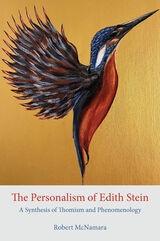 The Personalism of Edith Stein: A Synthesis of Thomism and Phenomenology
Robert McNamara
Catholic University of America Press, 2023 Edith Stein’s life and thought intersect with many important movements of life and thought in the twentieth century. Through her life and eventual martyrdom, she gave witness to the primacy of truth and faith in the face of political totalitarianism, and in her philosophical works, she contributed to a synthesis of phenomenological thought with the thought of Aquinas, while also progressively advancing a compelling form of philosophical personalism. As a result, Stein represents one of the most important Catholic thinkers of the twentieth century and is a figure of growing fascination and devotion among believers and nonbelievers alike.
The Personalism of Edith Stein is an investigation of Stein’s mature philosophical anthropology, exploring her engagement with the thought of Aquinas and Thomism while maintaining the phenomenological mode of investigation. Through a careful examination of Stein’s later works under the themes of human nature, the human individual, and the human being’s relation to God, McNamara shows that Stein’s mature personalism is considerably expanded and substantiated by her assimilation of key anthropological and metaphysical teachings of Aquinas and Thomism, and, conversely, that Stein significantly develops and deepens these same teachings through a phenomenological reconsideration of each from a personalist perspective.
As a whole, the study reveals the profound accord between Stein’s mature thought and the received teachings of Aquinas, while yet carefully attending to the remaining differences between them. Ultimately, the author proposes that Stein imbues the teachings of Aquinas with a fundamental personalization such that her mature anthropology can be understood as a Thomistically informed personalism that represents a significant, original contribution to the anthropological dimension of the philosophia perennis.
The Personalism of John Henry Newman
John Crosby
Catholic University of America Press, 2014 In The Personalism of John Henry Newman, Crosby shows the reader how Newman finds the life-giving religious knowledge that he seeks. He explores the "heart" in Newman and explains what Newman was saying when he chose as his cardinal's motto, cor ad cor loquitur (heart speaks to heart). He explains what Newman means in saying that religious truth is transmitted not by argument but by "personal influence."
Personalist Papers
John F. Crosby
Catholic University of America Press, 2004 In Personalist Papers, John F. Crosby continues the discussion of Christian personalism begun in his highly acclaimed book, The Selfhood of the Human Person.
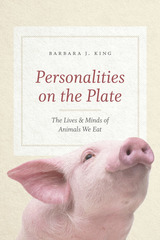 Personalities on the Plate: The Lives and Minds of Animals We Eat
Barbara J. King
University of Chicago Press, 2017 In recent years, scientific advances in our understanding of animal minds have led to major changes in how we think about, and treat, animals in zoos and aquariums. The general public, it seems, is slowly coming to understand that animals like apes, elephants, and dolphins have not just brains, but complicated inner and social lives, and that we need to act accordingly.
Yet that realization hasn’t yet made its presence felt to any great degree in our most intimate relationship with animals: at the dinner table. Sure, there are vegetarians and vegans all over, but at the same time, meat consumption is up, and meat remains a central part of the culinary and dining experience for the majority of people in the developed world.
With Personalities on the Plate, Barbara King asks us to think hard about our meat eating--and how we might reduce it. But this isn’t a polemic intended to convert readers to veganism. What she is interested in is why we’ve not drawn food animals into our concern and just what we do know about the minds and lives of chickens, cows, octopuses, fish, and more. Rooted in the latest science, and built on a mix of firsthand experience (including entomophagy, which, yes, is what you think it is) and close engagement with the work of scientists, farmers, vets, and chefs, Personalities on the Plate is an unforgettable journey through the world of animals we eat. Knowing what we know--and what we may yet learn--what is the proper ethical stance toward eating meat? What are the consequences for the planet? How can we life an ethically and ecologically sound life through our food choices?
We could have no better guide to these fascinatingly thorny questions than King, whose deep empathy embraces human and animal alike. Readers will be moved, provoked, and changed by this powerful book.
Personality and the Cultural Construction of Society
Edited by David K. Jordan and Marc J. Swartz
University of Alabama Press, 1990 Pyschological anthropology is a vital area of contemporary social science, and one of the field's most important and innovative thinkers is Melford E. Spiro. This volume brings together sixteen essays that review Spiro's theoretical insights and extend them into new areas. The essays center on several general problems: In what ways is it meaningful to speak of a social act as having "functions"? What elements and processes of human personality are universal, and why? What is the relationship between religion and personality? Why? What are the pyschological underpinnings of social manipulation?
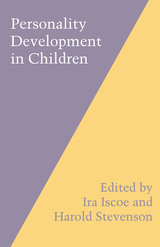 Personality Development in Children
Edited by Ira Iscoe and Harold Stevenson
University of Texas Press, 1960 This book presents penetrating observations by six authorities on the personality development of children for the enlightenment of parents, teachers, and others who have a vital interest in children.
In the first paper, the late Harold E. Jones, a professor of psychology and the director of the Institute of Human Development at the University of California, examines the development of personality over a long period of time. He discusses the child-rearing practices used with a number of babies, then follows through with observations made several years later to see the effects of these practices.
In another paper, John E. Anderson, a professor of psychology at the University of Minnesota and the former director of the Institute of Child Development and Welfare there, supports the theory that valid predictions of future personality adjustment can be made through an assessment of the present status of an individual.
Anderson’s findings are based on the results of tests administered to children of Nobles County, Minnesota, during the period 1950–1957, and on teacher-community-pupil ratings of these children.
Still other papers offer a variety of ideas. Dr. Milton J. E. Senn, Sterling Professor of Pediatrics and Psychiatry and the director of the Child Study Center at Yale University, suggests that there be greater harmony and more exchange of thought among people working toward a proper understanding of human nature. To a degree this entire book follows his suggestion.
Among several noteworthy observations made by Stanford University Professor of Psychology Robert R. Sears is the point that the development of conscience depends largely upon whether a child is loved or rejected by his or her parents.
John W. M. Whiting, professor of education and director of the Laboratory for Human Development at Harvard University, discusses, among other problems, the question of why children like to play grown-up roles and what happens when they are not permitted to do so. Orville Brim, a sociologist at the Russell Sage Foundation of New York City, explains personality in terms of demands, holding that one’s personality changes from situation to situation and from person to person.
 The Personality of Power: A Theory of Fascism for Anti-fascist Life
Brian Massumi
Duke University Press, 2025 “I am the Chosen One!” With this exclamation Donald Trump crowns the national exceptionalism his base upholds with a claim of personal exceptionalism. He leaves no doubt as to the emotional note: “I am your vengeance!” He personifies reaction for the masses. Except, in today’s microsegmented social media environment the “masses” no longer exist. Fascism’s cultural conditions have shifted. In The Personality of Power, Brian Massumi retheorizes the conditions of contemporary fascism through the prism of Trump’s persona. Older theories based on identification of the masses with a charismatic leader no longer hold. Rather, an affective regime of reaction agitates bodies and orients lives at the molecular level. Massumi examines this agitation in relation to race, gender, personhood, and conspiracy thinking. The Personality of Power is a political treatise on fascism and its precursor movements, coupled with a philosophical inquiry into becoming reactionary as a collective process. Massumi calls the very concept of the person into question, asking what collective personhood means concretely. Nothing less than an alternative political logic is needed, turned to the task of thinking collective individuation.
 Personality Plus: Some Experiences of Emma McChesney and Her Son, Jock
Edna Ferber
University of Illinois Press, 2002 Edna Ferber, the Pulitzer Prize-winning author of Show Boat and Giant, achieved her first great success with a series of stories featuring Emma McChesney: a smart, stylish, divorced mother who in a mere twelve years rose from stenographer to traveling sales representative to business manager and partner of the T. A. Buck Featherloom Petticoat Company.
In this second of three volumes chronicling the travels and trials of Emma McChesney, the plucky heroine trades in her traveling bag and coach tickets for an office and a position a T. A. Buck Jr.'s business partner. Along with this well-earned promotion comes the home–-with a fireplace–-that she had longed for during her ten years on the road.
Her dashing son Jock, now twenty-one, has just entered the business world himself with the Berg, Shriner Advertising company. His colleagues believe that with his heritage he "ought to be able to sell ice to an eskimo." Indeed, Jock dazzles them with his keen business sense and exemplary work ethic, but goes overboard on the charm and ends up alienating clients, unnerving his boss, and even patronizing his business-savvy mother. When his company takes on the challenge of creating a zippy advertising campaign for T. A. Buck's no-frills petticoats, Jock comes through, but not without a reminder that mother always knows best.
In this bracingly modern novel, first published in 1914, Ferber contrasts the virtues of talent with those of experience to provide a fresh, readable, and smartly entertaining contest between a mother and her adult son.
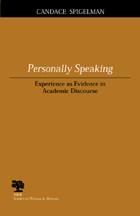 Personally Speaking: Experience as Evidence in Academic Discourse
Candace Spigelman
Southern Illinois University Press, 2004 Responding to contemporary discussion about using personal accounts in academic writing, Personally Speaking: Experience as Evidence in Academic Discourse draws on classical and current rhetorical theory, feminist theory, and relevant examples from both published writers and first-year writing students to illustrate the advantages of blending experiential and academic perspectives. Candace Spigelman examines how merging personal and scholarly worldviews produces useful contradictions and contributes to a more a complex understanding in academic writing. This rhetorical move allows for greater insights than the reading or writing of experiential or academic modes separately does. Personally Speaking foregrounds the semi-fictitious nature of personal stories and the rhetorical possibilities of evidence as Spigelman provides strategies for writing instructors who want to teach personal academic argument while supplying practical mechanisms for evaluating experiential claims. The volume seeks to complicate and intensify disciplinary debates about how compositionists should write for publication and what kinds of writing should be taught to composition students. Spigelman not only supplies evidence as to why the personal can count as evidence but also relates how to use it effectively by including student samples that reflect particular features of personal writing. Finally, she lays the groundwork to move narrative from its current site as confessional writing to the domain of academic discourse.
 Personification and the Sublime: Milton to Coleridge
Steven Knapp
Harvard University Press, 1985 Eighteenth-century and Romantic readers had a peculiar habit of calling personified abstractions “sublime.” This has always seemed mysterious, since the same readers so often expressed a feeling that there was something wrong with turning ideas into people—or, worse, turning people into ideas. In this wide-ranging, carefully argued study, Steven Knapp explains the connection between personification and the aesthetics of the sublime.
Personifications, such as Milton’s controversial figures of Sin and Death in Paradise Lost, were seen to embody a unique combination of imaginative power and overt fictionality, and these, Knapp shows, were exactly the conflicting requirements of the sublime in general. He argues that the uneasiness readers felt toward sublime personifications was symptomatic of broader ambivalences toward archaic beliefs, political and religious violence, and poetic fiction as such.
Drawing on recent interpretations of Romanticism, allegory, and the sublime, Knapp provides important new readings of Coleridge, Wordsworth, Kant, and William Collins. His provocative thesis sheds new light on the relationship between Romanticism and the eighteenth century.
 Personology: Method and Content in Personality Assessment and Psychobiography
Irving E. Alexander
Duke University Press, 1990 How can we know what another human being is like in some meaningful, dynamic way? Can we distill the signature-like features of an individual personality? What is the relationship between personal experience and our attempts to describe the person who has that experience?
This work by a highly respected senior psychologist is an effort to answer these questions. Irving E. Alexander presents a case for considering the personal narrative of a human life as the most compelling aspect of that life to be decoded and understood. In part a critique of an exclusive reliance on general theories about the development of personality and ways of knowing based primarily on comparison with others, Personology is illustrated with material drawn from the lives, personal writings, and theories of Freud, Jung, and Sullivan. Alexander develops new insights into the lives of these men and offers methods and guidelines for investigating and teaching personology and psychobiography.
 Persons and Things
Barbara Johnson
Harvard University Press, 2010 Moving effortlessly between symbolist poetry and Barbie dolls, artificial intelligence and Kleist, Kant, and Winnicott, Barbara Johnson not only clarifies psychological and social dynamics; she also re-dramatizes the work of important tropes—without ever losing sight of the ethical imperative with which she begins: the need to treat persons as persons.
In Persons and Things, Johnson turns deconstruction around to make a fundamental contribution to the new aesthetics. She begins with the most elementary thing we know: deconstruction calls attention to gaps and reveals that their claims upon us are fraudulent. Johnson revolutionizes the method by showing that the inanimate thing exposed as a delusion is central to fantasy life, that fantasy life, however deluded, should be taken seriously, and that although a work of art “is formed around something missing,” this “void is its vanishing point, not its essence.” She shows deftly and delicately that the void inside Keats’s urn, Heidegger’s jug, or Wallace Stevens’s jar forms the center around which we tend to organize our worlds.
The new aesthetics should restore fluidities between persons and things. In pursuing it, Johnson calls upon Ovid, Keats, Poe, Plath, and others who have inhabited this in-between space. The entire process operates via a subtlety that only a critic of Johnson’s caliber could reveal to us.
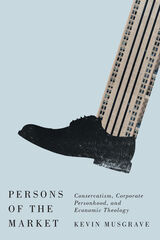 Persons of the Market: Conservatism, Corporate Personhood, and Economic Theology
Kevin Musgrave
Michigan State University Press, 2022 Taking corporate personhood as a starting point, Persons of the Market observes the complex historical entanglement of Christian theology and liberal capitalism to shed new
light on their seemingly odd marriage in contemporary American politics. Author Kevin Musgrave highlights the ways that theories of corporate and human personhood have long been and remain bound together by examining four case studies: the U.S. Supreme Court’s 1886 Santa Clara decision, the role of early twentieth-century advertisers in endowing corporations with souls, Justice Lewis Powell Jr.’s eponymous memo of 1971, and the arc of the conservative movement from Ronald Reagan to Donald Trump. Tracing this rhetorical history of the extension and attribution of personhood to the corporate form illustrates how the corporation has for many increasingly become a normative model or ideal to which human persons should aspire. In closing, the book offers preliminary ideas about how we might fashion a more democratic and humane understanding of what it means to be a person.
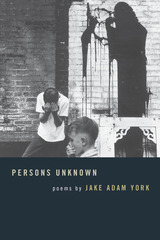 Persons Unknown
Jake Adam York
Southern Illinois University Press, 2010 In this stunning continuation to the poetry collection A Murmuration of Starlings, dedicated to those who lost their lives during the Civil Rights movement, Jake Adam York presents another set of searing portraits of these martyrs—men whose murders haunt America’s history. These elegiac and documentary poems seek justice and understanding for such sacrifices as Mack Charles Parker, lynched in Mississippi in 1959, his body disposed of in the waters of the Pearl River; Charles Eddie Moore and Henry Hezekiah Dee, abducted into the depths of the Homochitto Forest, beaten, and drowned in the Mississippi by the Ku Klux Klan; and Medgar Evers, dedicated activist, whose assassination outside his home in 1963 sent shockwaves throughout the South. Drawing on photographs, articles, legal documents, and other cultural artifacts, York deftly weaves history and memory into a lyrical reckoning for these often-overlooked victims of the bitter struggle for Civil Rights. A Natural History of Mississippi A blade of rust from the ocean and from the air a rumor that corrodes the earth in tongues, lichen, moss, magnolia, until each gossip’s true. Things go this way, each green repeating its fact of sun and wind and rain, its dialect, its blade, while beneath each leaf a quiet cuts between the veins. Laced, pale wings open to learn the particular weather, the place or part of speech that will darken and give them a name. So each sugar furls to burn and bitter against whatever mouths might swallow, each skin becomes the history of its harbor, another word for here. This hatch of bark and shade hangs like a photograph of all it covers, so perfect, so still, its edges blur, then disappear.
 Persophilia: Persian Culture on the Global Scene
Hamid Dabashi
Harvard University Press, 2015 From the Biblical period and Classical Antiquity to the rise of the Renaissance and the Enlightenment, aspects of Persian culture have been integral to European history. A diverse constellation of European artists, poets, and thinkers have looked to Persia for inspiration, finding there a rich cultural counterpoint and frame of reference. Interest in all things Persian was no passing fancy but an enduring fascination that has shaped not just Western views but the self-image of Iranians up to the present day. Persophilia maps the changing geography of connections between Persia and the West over the centuries and shows that traffic in ideas about Persia and Persians did not travel on a one-way street.
How did Iranians respond when they saw themselves reflected in Western mirrors? Expanding on Jürgen Habermas’s theory of the public sphere, and overcoming the limits of Edward Said, Hamid Dabashi answers this critical question by tracing the formation of a civic discursive space in Iran, seeing it as a prime example of a modern nation-state emerging from an ancient civilization in the context of European colonialism. The modern Iranian public sphere, Dabashi argues, cannot be understood apart from this dynamic interaction.
Persophilia takes into its purview works as varied as Xenophon’s Cyropaedia and Nietzsche’s Thus Spoke Zarathustra, Handel’s Xerxes and Puccini’s Turandot, and Gauguin and Matisse’s fascination with Persian art. The result is a provocative reading of world history that dismantles normative historiography and alters our understanding of postcolonial nations.
Perspectives from the Disciplines: Stanford Online High School
Jeffrey Scarborough and Raymond Ravaglia
CSLI In this companion volume to Bricks and Mortar, Jeffrey Scarborough and Raymond Ravaglia present a series of essays written by senior instructors and division heads at the Stanford Online High School (SOHS). Written from the perspective of the online-learning practitioner, these essays discuss in detail the challenges of teaching particular disciplines, accomplishing particular pedagogical objectives, and fostering the habits of mind characteristic of students who have received deep education in a given discipline. Perspectives from the Disciplines also examines counseling, student services, and student life viewpoints as it discusses how a truly international community has been fostered at SOHS, and how SOHS’s student relationships are in many ways deeper and more intimate than those found in traditional secondary schools.
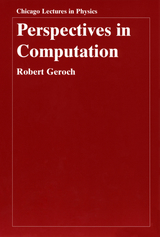 Perspectives in Computation
Robert Geroch
University of Chicago Press, 2009 Computation is the process of applying a procedure or algorithm to the solution of a mathematical problem. Mathematicians and physicists have been occupied for many decades pondering which problems can be solved by which procedures, and, for those that can be solved, how this can most efficiently be done. In recent years, quantum mechanics has augmented our understanding of the process of computation and of its limitations.
Perspectives in Computation covers three broad topics: the computation process and its limitations, the search for computational efficiency, and the role of quantum mechanics in computation. The emphasis is theoretical; Robert Geroch asks what can be done, and what, in principle, are the limitations on what can be done? Geroch guides readers through these topics by combining general discussions of broader issues with precise mathematical formulations—as well as through examples of how computation works.
Requiring little technical knowledge of mathematics or physics, Perspectives in Computation will serve both advanced undergraduates and graduate students in mathematics and physics, as well as other scientists working in adjacent fields.
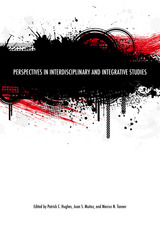 Perspectives in Interdisciplinary and Integrative Studies
Patrick C. Hughes
Texas Tech University Press, 2015 The essays and primary research studies presented in Perspectives in Interdisciplinary and Integrative Studies extend the field of integrative studies further by drawing a clear distinction between integrative and interdisciplinary studies, in which integrative studies provides for a synthesis of study and life, an application of interdisciplinarity to complex problems. This volume provides a common body of integrative knowledge, theory, methods, and program development and assessment, and reveals how scholars have applied the principles of integrative studies in their courses, degree programs, and research. As a primary or supplemental text, this volume is designed for upper-division undergraduate and graduate students, as well as a resource of contemporary integrative studies theories and practices for scholars and teachers. Students interested in interdisciplinary programs will find this text instrumental for synthesizing information across disciplines to solve real-world complex problems. University and college administrators responsible for faculty development, academic assessment, degree program development, and the promotion of an integrative campus culture will also find this a useful resource.
Perspectives in Phonology
Edited by Jennifer S. Cole and Charles Kisseberth
CSLI, 1997
Subject: Linguistics; Grammar--Phonology
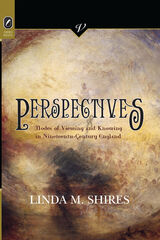 Perspectives: Modes of Viewing and Knowing in Nineteenth-Century England
Linda M. Shires
Ohio State University Press, 2009 Perspectives: Modes of Viewing and Knowing in Nineteenth-Century England reopens the question of classical perspective and its vicissitudes in aesthetic practice with a focus on texts of the 1830s to the end of the 1870s. Linda M. Shires demonstrates why and how artists and writers across media experimented with techniques of dissolution, combination, and multiple viewpoints much earlier in the century than intellectual historians generally assume. Arguing for a relationship between what she calls the disappearing “I” in poetry, a compromised omniscience, and the testing of a mastering eye in painting and photography, Shires argues that art forms themselves, rather than new technologies alone, reshaped the period by educating readers and viewers into new ways of knowing. In chapters on visual and verbal art and a waning theocentrism; D.G. Rossetti; Henry Peach Robinson and Lady Clementina Hawarden; and Robert Browning, Wilkie Collins, and George Eliot, Shires revitalizes the currently available scholarship on connections among nineteenth-century art forms. This interdisciplinary study offers nuanced, close readings in order to rebut assertions of delayed artistic responses to the decreasing influence of traditional perspective. It shows how vision is bound up with all the senses of a viewer and it supports current concepts of modernism as transitional, rather than radical.
Perspectives of Black Popular Culture
Harry B. Shaw
University of Wisconsin Press, 1990 While blacks have made perhaps their most obvious and substantial contributions to Western popular culture through music and dance, they have developed a rich popular culture in a number of other areas, including the visual arts, mass media, health practices, recreation, and literature. Glimpsed through any medium, black popular culture is the DNA that runs throughout the various kinds of black—and American—artistic achievement and shared experience, helping to identify, explain, and retain Africanisms and the essential blackness that emanate from the everyday lives of black people.
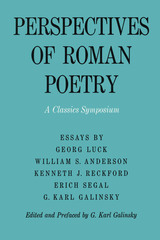 Perspectives of Roman Poetry: A Classics Symposium
Edited by G. Karl Galinsky
University of Texas Press, 1974 Written by leading specialists, the essays in Perspectives of Roman Poetry seek to provide a broad range of readers with a good understanding of some essential aspects of major Roman poets and poetic genres. The value of the essays is enhanced, for comparative purposes, by their extensive reference to modern authors. such as Shakespeare and Tolkien. For the modern reader, Latin quotations are accompanied by effective English translations. The essays and their authors are as follows: - "The Woman's Role in Latin Love Poetry," by Georg Luck
- "Autobiography and Art in Horace," by William S. Anderson
- "Some Trees in Virgil and Tolkien," by Kenneth J. Reckford
- "The Business of Roman Comedy," by Erich Segal
- "Ovid's Metamorphosis of Myth," by G. Karl Galinsky
The preface and concluding panel discussion illumine the situation of literary criticism inthe classics and point out the need for diversity. Perspectives of Roman Poetry resulted from a symposium held at the University of Texas at Austin in 1972. These essays offer different and, in some cases, heterodox interpretations that will serve as a basis for future discussions.
Perspectives of Saskatchewan
Jene M. Porter
University of Manitoba Press, 2008 At the turn of the nineteenth century, Saskatchewan was one of the fastest growing provinces in the country. In the early 1900s, it revolutionized the Canadian political landscape and gave rise to socialist governments that continue to influence Canadian politics today. It was the birthplace of Canada’s publicly funded health care system, and home to a thriving arts and literary community that helped define western Canadian culture.In Perspectives of Saskatchewan, twenty-one noted scholars present an in-depth look at some of the major developments in the province’s history, including subjects such as art, literature, demographics, politics, northern development, and religion. It lays the foundations for a greater understanding of Saskatchewan’s unique history, identity, and place in Canada.
Perspectives on Behavioral Inhibition
Edited by J. Steven Reznick
University of Chicago Press, 1989 Behavioral inhibition, often displayed as shyness in children and avoidance in animals, can be observed in the earliest stages of infancy. Recent research indicates that in extreme cases the tendency to either approach or withdraw from uncertain events continues through late childhood and is supported by specific biological mechanisms, suggesting a genetic basis. To effectively study behavioral inhibition, researchers are departing from the essentially experiential and descriptive techniques of traditional psychology and turning to a multidisciplinary approach that integrates psychology, psychiatry, epidemiology, genetics, and ethology. Perspectives in Behavioral Inhibition brings together the most current research of leading scholars in the various disciplines involved.
Perspectives on Contexts
Edited by Paolo Bouquet, Luciano Serafini, and Richmond H. Thomason
CSLI, 2008 Most human thinking is thoroughly informed by context but, until recently, theories of reasoning have concentrated on abstract rules and generalities that make no reference to this crucial factor. Perspectives on Contexts brings together essays from leading cognitive scientists to forge a vigorous interdisciplinary understanding of the contextual phenomenon. Applicable to human and machine cognition in philosophy, artificial intelligence, and psychology, this volume is essential to the current renaissance in thinking about context.
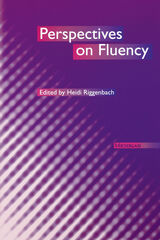 Perspectives on Fluency
Heidi Riggenbach
University of Michigan Press, 2000 Because there have been few attempts to specify precisely what fluency is, Heidi Riggenbach has culled an impressive list of linguistic scholars and researchers representing the disciplines of psycholinguistics, socio-linguistics, and speech communication, for example, to write original papers for Perspectives on Fluency. This volume offers a historical overview of fluency and, in seeking to better define the term, focuses on both native speaker and nonnative speaker fluency.
Section 1, What Is Fluency? presents papers that all describe fluency, but in different ways.
The articles in Section 2, Essential Components of Fluency, consider features or components that contribute to impressions of fluency.
Section 3, Cognitive Processes Underlying Fluency, is devoted to an exploration of the psycholinguistic factors underlying fluency.
Three studies are presented in Section 4, Empirical Studies on Nonnative Fluency, and they exemplify the range of approaches to characterizing learners as fluent or nonfluent in their target language.
One objective of Perspectives on Fluency is to provide a starting point for language researchers interested in exploring the concept of fluency, a foundation that, until the arrival of this volume, did not exist. The book can be useful to those approaching fluency from a language assessment perspective, and those interested in the relationship of fluency to oral proficiency.
 Perspectives on Food-Safety Issues of Animal-Derived Foods
Steven C. Ricke
University of Arkansas Press, 2010 As recent stories in the news have shown, maintaining the integrity of the food supply is of critical importance to the consumer. Thousands of Americans die each year from food-borne illnesses, and millions more get sick. Tremendous strides have been made to reduce the incidence of food-borne diseases originating from animal-derived foods, but food safety and food-borne pathogens continue to remain problematic throughout the world. Food-safety scientists from around the nation continue to conduct groundbreaking research not only to understand causative factors in food-borne pathogen prevalence but to develop novel intervention strategies for limiting contamination in all phases of food animal production. The twenty-four essays in this book highlight research efforts of researchers from the tristate Food Safety Consortium established in 1988 by Congress as a research alliance of food-safety scientists at the University of Arkansas, Iowa State University, and Kansas State University. Members of the consortium conduct research through an annual grant approved by Congress and administered by the U.S. Department of Agriculture. Its mission is to conduct extensive investigation into all areas of poultry, beef, and pork meat production, from the farm to the consumer’s table. In addition to the consortium researchers, collaborative university researchers, government officials, and industry personnel provide timely reviews of their latest findings with regard to five significant subject areas: preharvest food-borne pathogen ecology and intervention strategies, postharvest food-borne pathogen ecology, rapid methods and detection strategies for food-borne pathogens, antibiotics and antimicrobials in food safety, and emerging issues in food safety. Progress in these research areas provides opportunities to further enhance protection of animal-derived foods from farm to fork.
|
|



